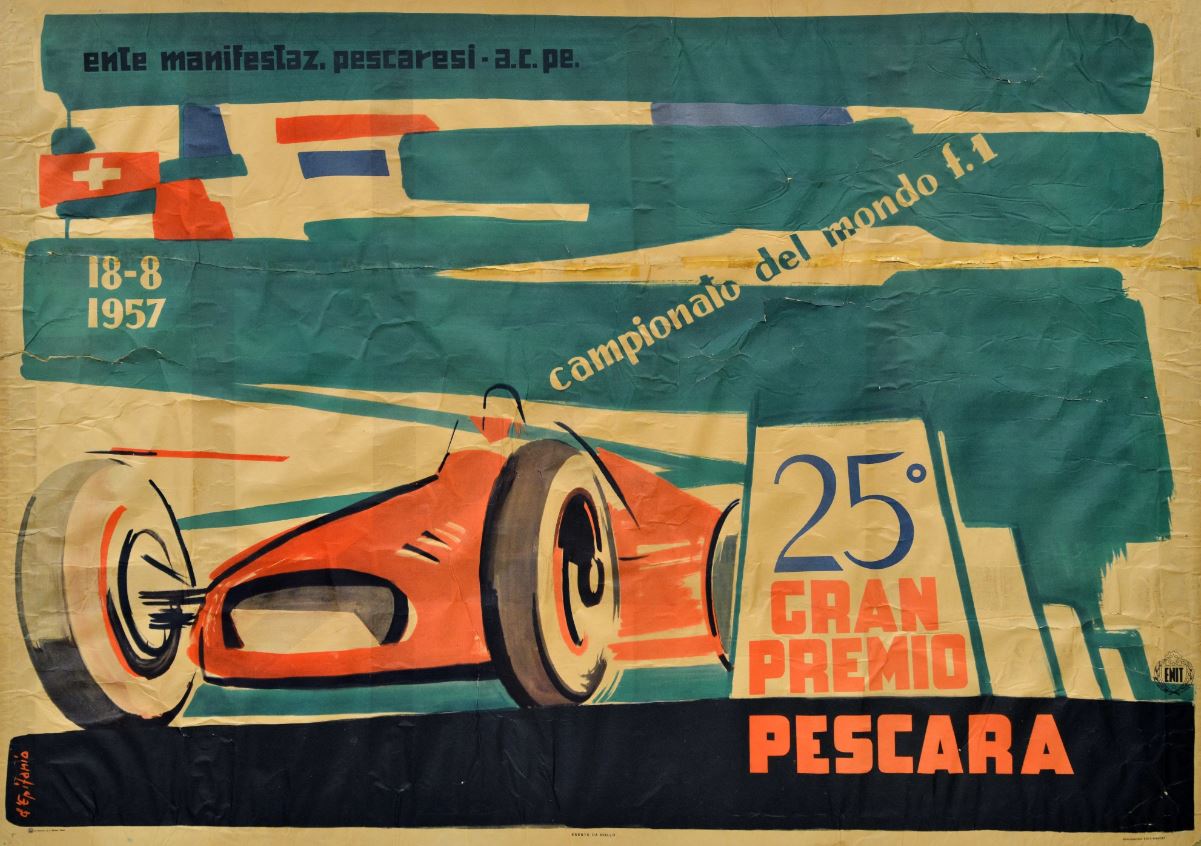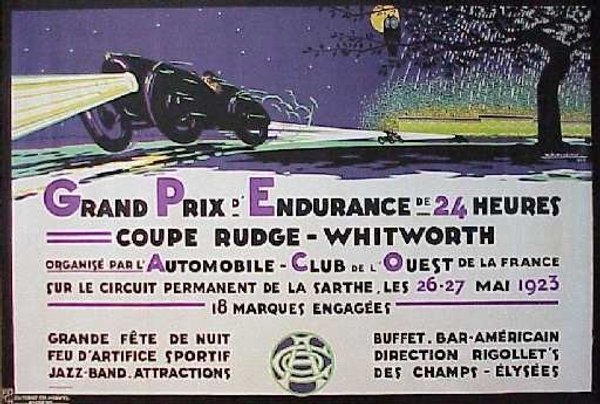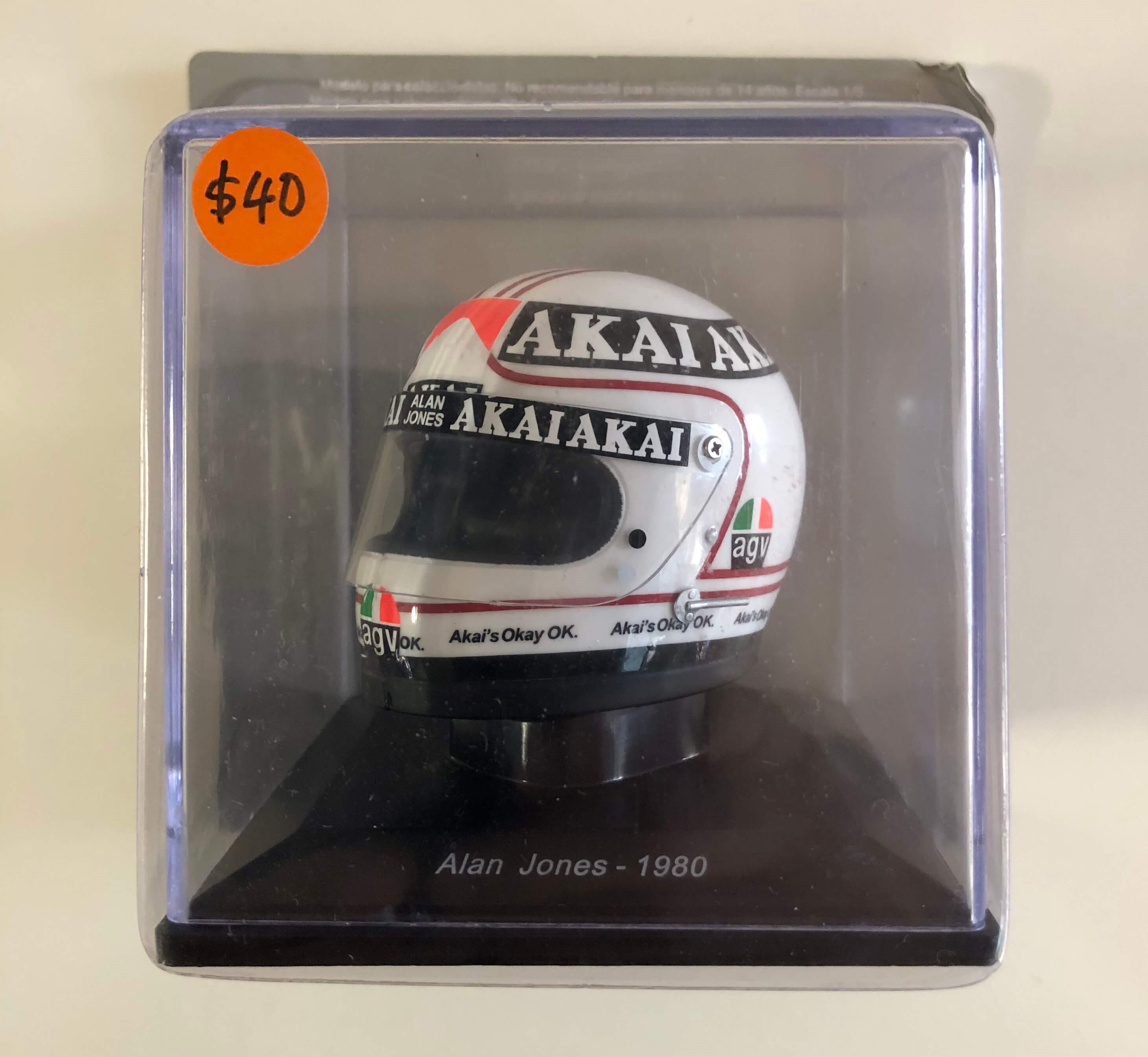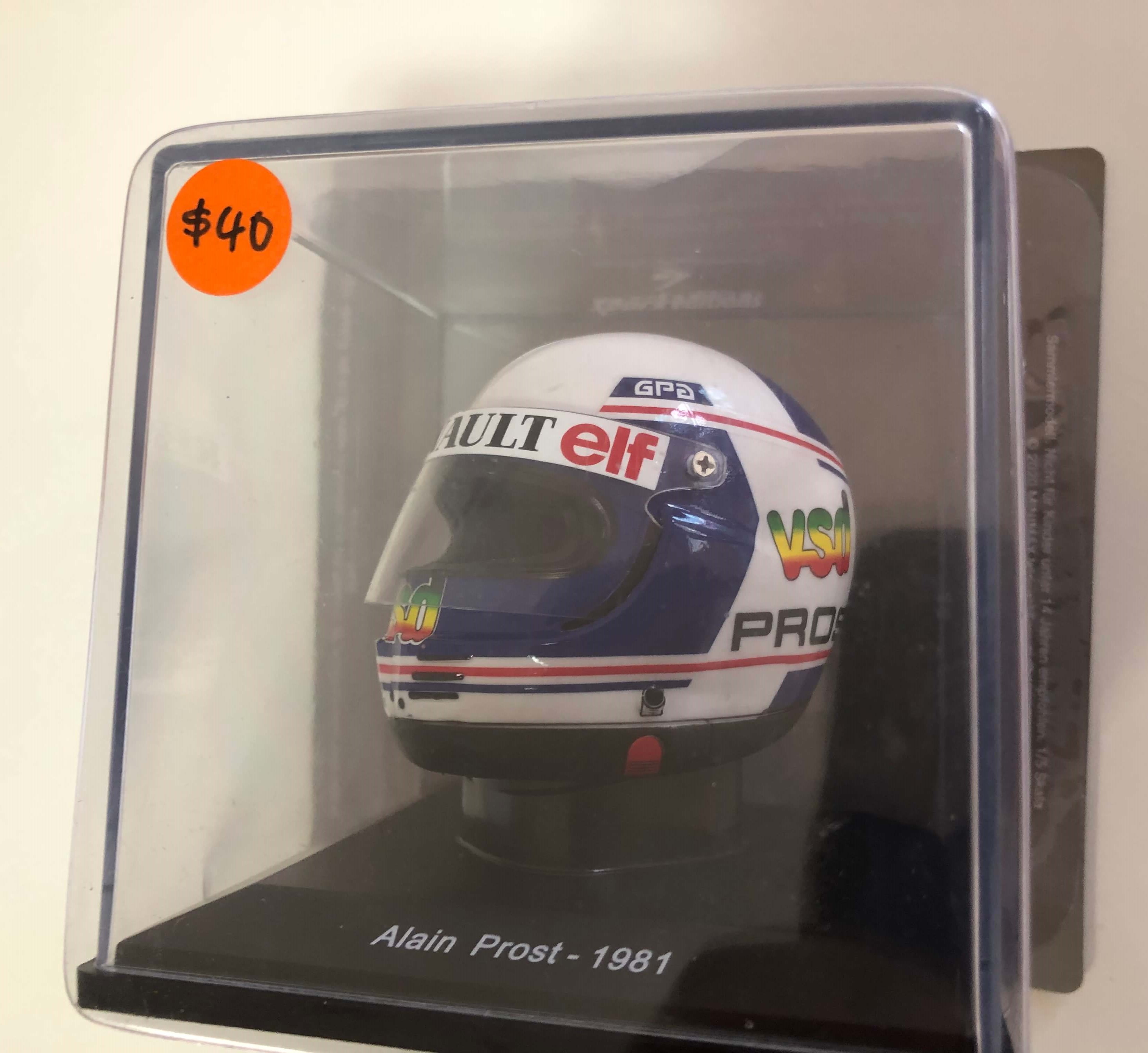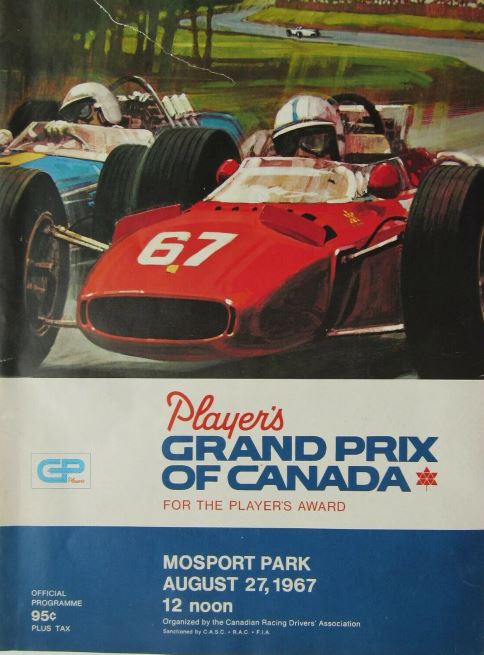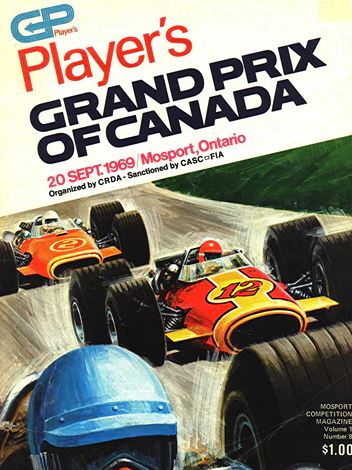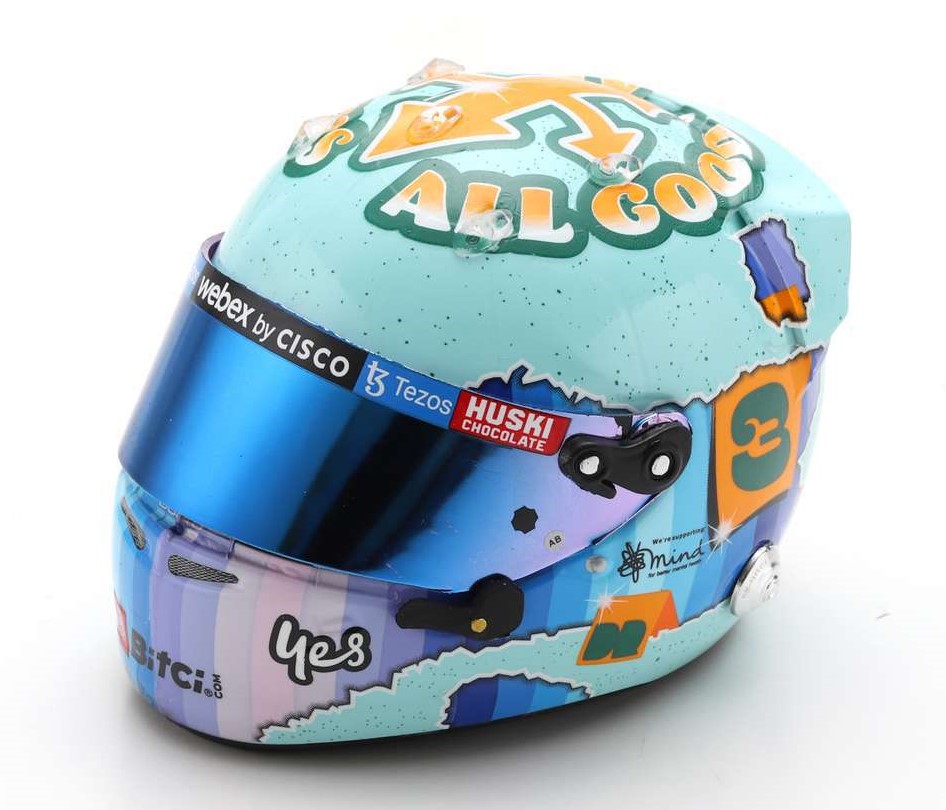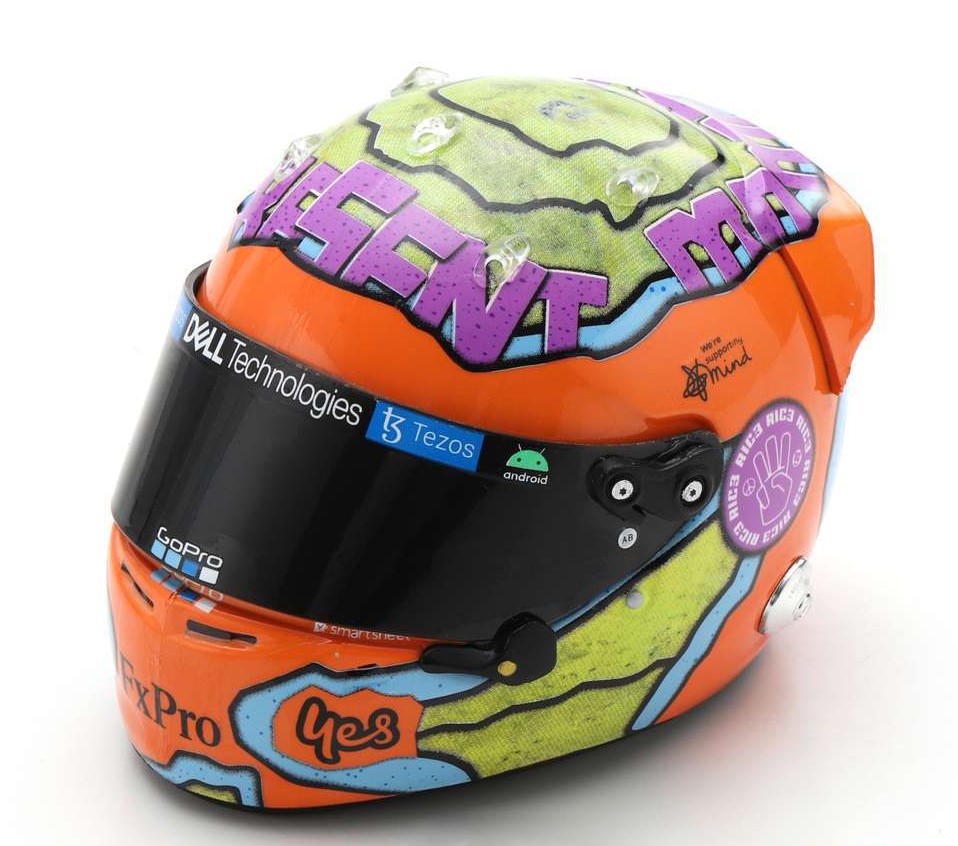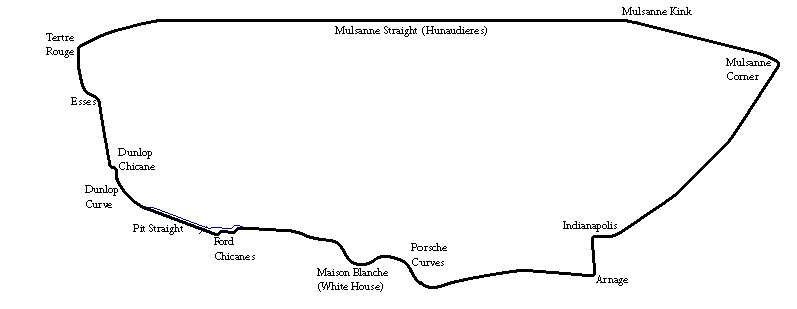www.F1scalemodels.com
... specialising in 1:43 scale model cars (Formula 1, Indy 500, Le Mans, GT and classic and modern road cars)
New Additions: December 2023
Hi and welcome to last monthly update for 2023; didn't the year just fly by? Thanks to all those who stopped by my stall at the Collector Con Fair at Penrith on 26 November. Some more Spark models have arrived this month plus a few others to add to the stock lists. As usual, I've picked a couple of models to highlight.
Gérard Larrousse, a former sports car and F1 driver founded his own self-named F1 team in 1987. Following the end of the 1991 F1 season, the Larrouse team had been declared bankrupt, and former partners Brian Hart and Lola ended their contracts due to the money they were owed. To keep his team going he sold a majority share to Venturi, a GT car maker and hired Robin Herd to build the 1992 cars having lost the use of Lola cars. The car that Herd produced was the Venturi LC92. A new two-year deal was also penned with Lamborghini for their V12 3.5-litre engine and Betrand Gachot and Ukyo Katayama were hired to drive the Venturi. The LC92 impressed at times, especially on fast circuits but its reliability was the second-worst on the grid. Gachot was occasionally quick in qualifying but finished only four races; his undoubted highlight was 6th at Monaco to claim the team's only point for the season. Spark has produced the colourful car that Gachot drove in the Monaco GP.
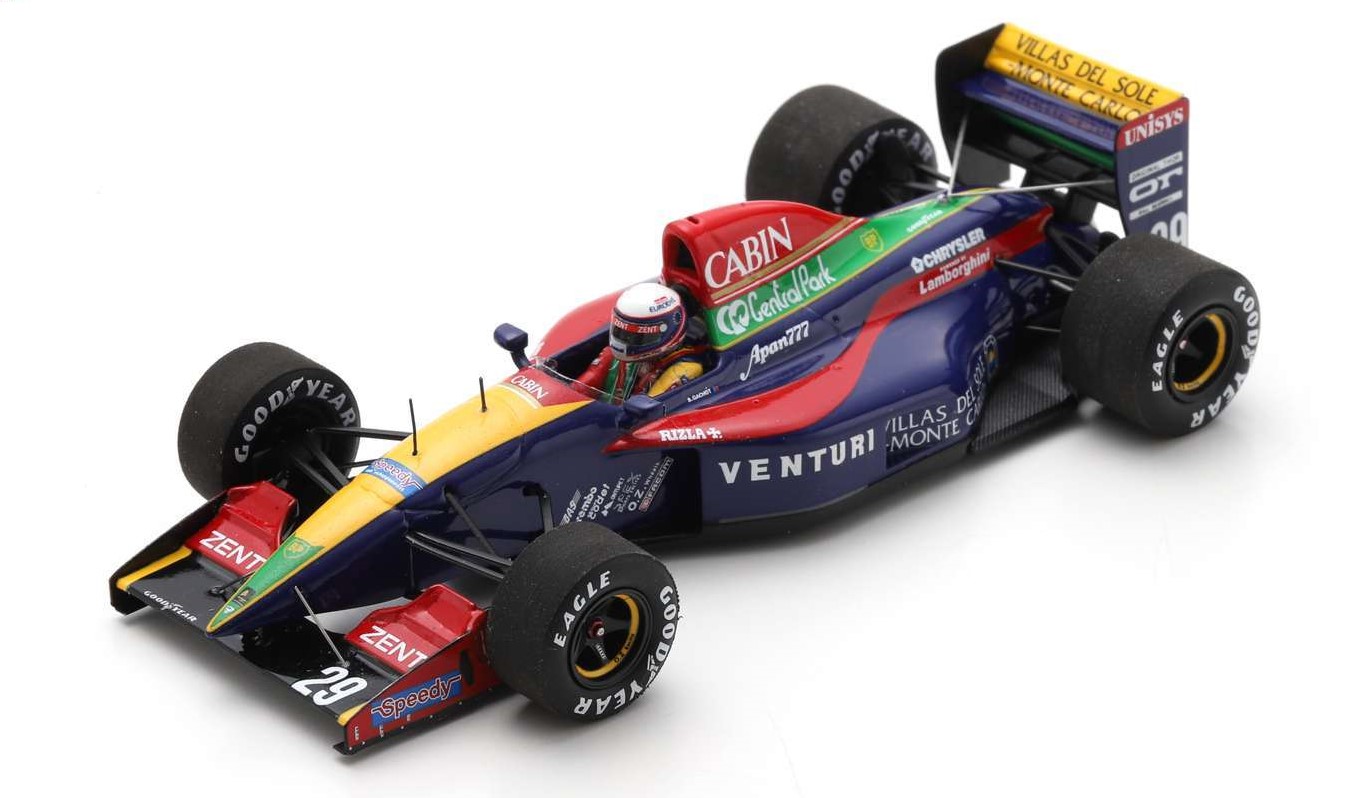 Spark: Venturi LC92 B.Gachot 6th Monaco GP
Spark: Venturi LC92 B.Gachot 6th Monaco GP
After the victory at Le Mans in 1959 and the World Sportscar Championship in the same year, Aston Martin pulled out of racing. Privateers in DB4 GT's and Zagatos were left to fly the flag. But after encouragement from dealers who wanted to sell cars with racing connections, the factory created a special 4 litre prototype GT based on the DB4 GT for the 1962 Le Mans race. It never got a proper name, and became known only by its internal code: DP212. The DP stood for ‘Design Project’. Although loosely based on the DB4 GT, the DP212 was uprated with a chassis that the competition department comprehensively drilled for lightness. A bigger engine, a special gearbox plus improved braking and suspension were added and it was then clothed with a streamlined magnesium-alloy body designed to maximise top speed on the ultra-fast Le Mans circuit. Unbelievable by today's standard, Project 212 went from green light to starting flag at Le Mans in just over five months. It was exceedingly quick at Le Mans in the hands of Graham Hill and Richie Ginther but with the sixth hour approaching, and in 9th place the DP212 was retired as a result of a piston failure. After this promising display by the DP212 at Le Mans, David Brown sanctioned the production of three new DP cars for 1963. A brace of DP214s and an even lighter DP215 were constructed. Aston Martin ultimately quit sportscar racing at the end of 1963. This model of the DP212 is by Spark.
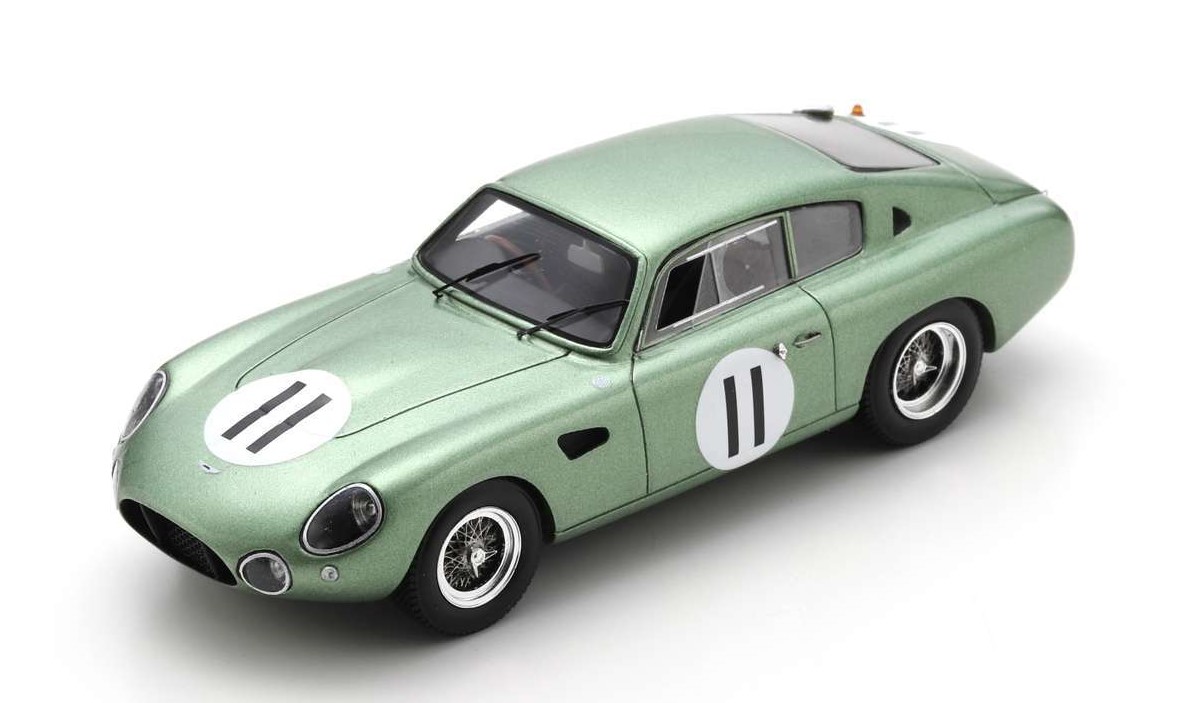 Spark: Aston Martin DP212 Hill/Ginther Le Mans '62
Spark: Aston Martin DP212 Hill/Ginther Le Mans '62
OK, that about wraps it up for another month and another year. There is only one show in December, the regular 1st Friday Sydney Toy and Hobby Fair at Epping on 1st December. Despite the "cost-of-living" crisis, I hope to see you at the last event of the year. There's nothing left to do but to thank you all for your patronage and above all, your friendship this year. I wish you all the very best for the festive season. Until next year, happy collecting.
Formula One
- 2022 Alfa Romeo Ferrari C42, V.Bottas (77) 5th Emilia Romagna GP (Spark)
- 2022 Alfa Romeo Ferrari C42, G.Y.Zhou (24) Azerbaijan GP (Spark)
- 1952 Ferrari 375, L.Rosier (8) race car "Ecurie Rosier" (Altaya)
- 1956 Ferrari D50, P.Collins (2) race car (Altaya)
- 1967 Ferrari 312 F1, C.Amon (8) race car (Altaya)
- 1982 Ferrari 126 C2, D.Pironi (28) race car (Altaya)
- 1994 Ferrari 412 T1, G.Berger (28) race car (Altaya)
- 1964 Lotus Cosworth 32, J.Clark (2) 1st Pau F2 GP (Spark)
- 1975 March Ford 751, V.Brambilla (9) 6th British GP (Spark)
- 1988 McLaren Honda MP4/4, A.Senna (12) 1st Japanese GP (Spark)
- 2022 Red Bull RBPT RB18, M.Verstappen (1) 1st Japanese GP w/pit boards (Spark)
- 2022 Red Bull RBPT RB18, M.Verstappen (1) 1st Abu Dhabi GP w/tyre marks (Spark)
- 1978 Tyrrell Ford 008, D.Pironi (3) 5th German GP (Spark)
- 1992 Venturi Lamborghini LC92, B.Gachot (29) 6th Monaco GP (Spark)
- 1978 Wolf Ford WR3, K.Rosberg (32) 10th German GP (Spark)
Australian Racing Series
- 2012 Audi R8 LMS GT3, Mies/O'Young/Joens (1A) 1st Bathurst 12 hour (Spark)
- 2018 Audi R8 LMS, Frijns/Leonard/Vanthoor (37) 1st Bathurst 12h (Spark)
Le Mans / Sports Car Racing
- 2022 Alpine Gibson A480, Negrão/Lapierre/Vaxivière (36) Le Mans (Spark)
- 1962 Aston Martin DP212, G.Hill/Ginther (11) Le Mans (Spark)
- 1965 Brabham Climax BT8, D.Hulme (16) 1st RAC Tourist Trophy (Spark)
- 1966 Ford J-Car, K.Miles - Riverside Test (Spark)
- 2022 Oreca Gibson 07, Allen/Binder/Thomas (45) 1st LMP2 Le Mans (Spark)
- 1969 Porsche 908/02, Elford/Maglioli (270) 2nd Targa Florio (Spark)
- 1969 Porsche 908/02, Hermann/Stommelen (274) 3rd Targa Florio (Spark)
- 1969 Porsche 908/02, Kauhsen/von Wendt (272) 4th Targa Florio (Spark)
- 1971 Porsche 917K Twin air scoops, J.Oliver (18) Le Mans Test (Spark)
Road Cars
- 1959 Ford Anglia Mk1 in light blue/white (Cararama)
- 1996 Ford Fiesta in dark red (Minichamps)
- 2001 Ford Fiesta 3-door in red (Minichamps)
- Ford Focus 3-door in metallic red (Minichamps)
After Thoughts: "A 60-year retrospective - The 1963 F1 World Championship." Since Graham Hill's championship the previous year, the manufacturers were in turmoil. Both Porsche and Bowmaker-Yeoman (Lola) had decided to withdraw, leaving prominent drivers looking for new teams. Dan Gurney joined Brabham and John Surtees, who had been with Bowmaker-Yeoman, went to Ferrari. Meanwhile Carlo Chiti, Ferrari's chief engineer had left to set up his own team, ATS and took with him Phil Hill and Giancarlo Baghetti. For Jim Clark (Lotus), 1962 had been a disappointment and was looking to make amends. The Cooper team retained Bruce McLaren, while reigning champion Graham Hill and Richie Ginther re-signed with BRM.
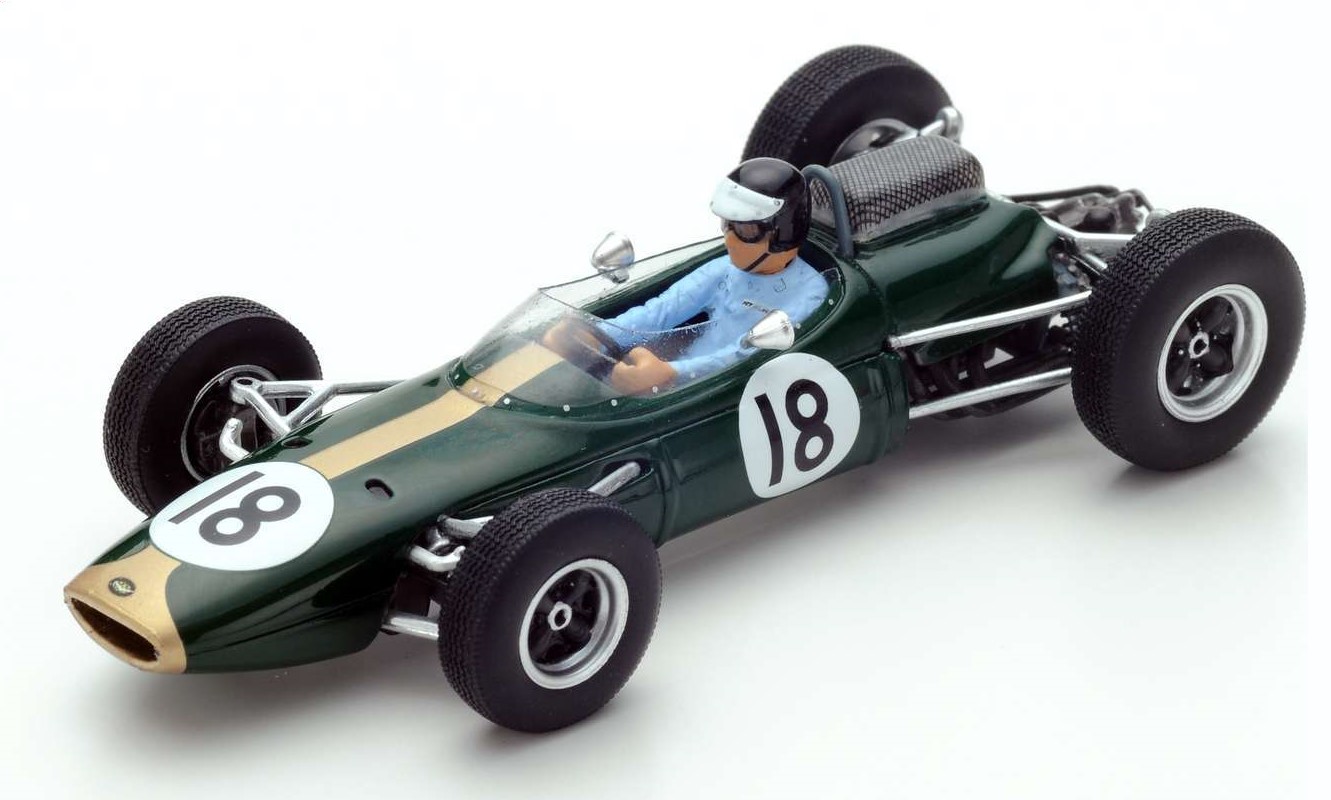 Spark: Brabham Climax BT7 1963 D.Gurney
Spark: Brabham Climax BT7 1963 D.Gurney
It was Graham Hill who took the honours in the opening race at Monaco. It was to be Hill's first of 5 victories at Monaco and only Senna was to score more with 6 wins. Then it was all about Jim Clark who won the next four races (Belgian, Dutch, French and British) in his Lotus Climax 25. Of these, perhaps the Dutch race best epitomised the level of Clark's performance that year. He was fastest in practice, led the race from start to finish and lapped the entire field in the process. Clark was unlucky at the next race at the Nurburgring where he was hampered by a misfiring engine, yet still managed to come in second behind John Surtees' Ferrari. This enabled Surtees to score his maiden GP win. Following the German GP, Clark was able to reassert his dominance with a win at the Italian GP and to secure the world championship with 3 races still to run. With the best six scores from ten races counting, Clark was in an unassailable position. The final three GP's were non-european races, with the first at Watkins Glen (USA) where Clark stumbled. He lost a lap and a half in the pits with battery problems yet still managed to finish third. The win went to Graham Hill with his BRM team mate, Ginther in second. The season ended with Clark winning the last two races in Mexico and South Africa.
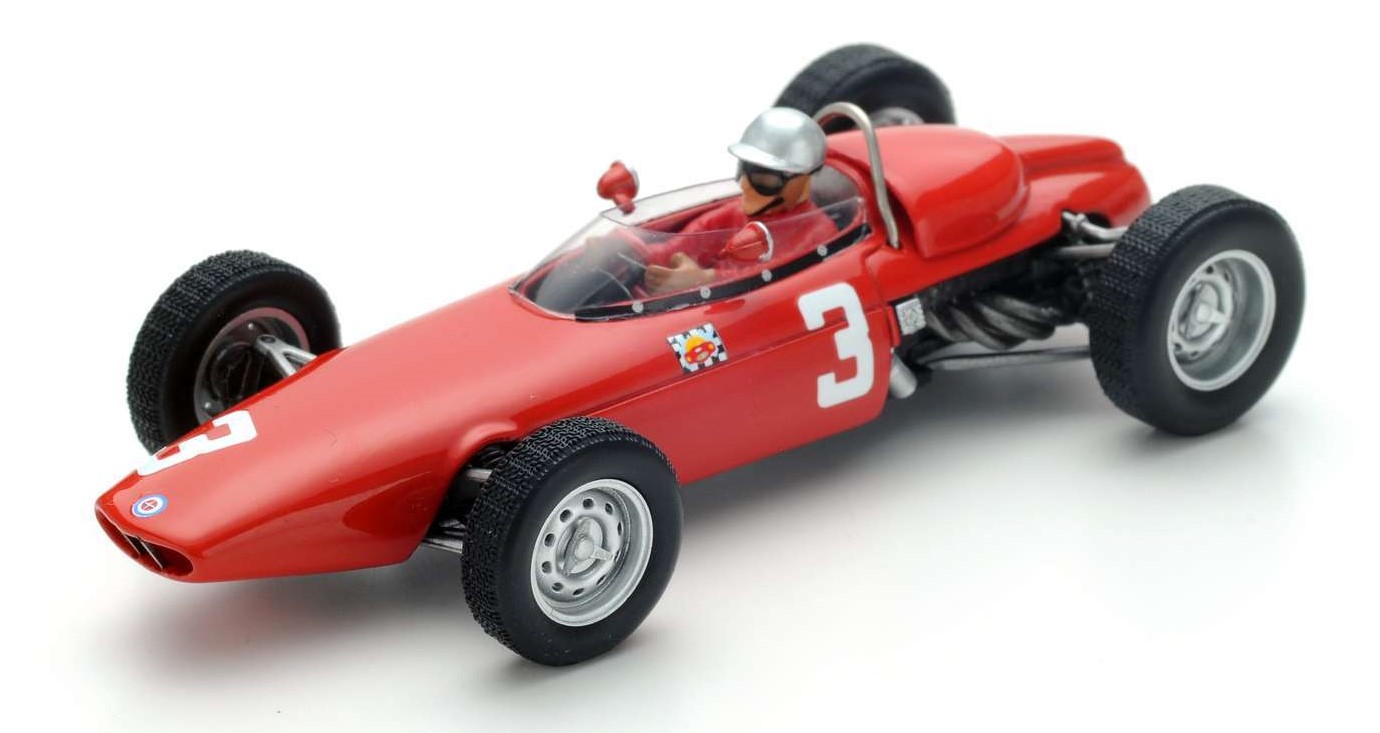 Spark: BRM P57 "Scuderia Centro Sud" L.Bandini
Spark: BRM P57 "Scuderia Centro Sud" L.Bandini
1963 was Graham Hill's turn to be disappointed with a run of ill fortune, leaving him with 2 wins and 2nd in the championship. BRM tried to emulate Lotus by introducing their own monocoque design but it handled poorly and Hill eventually returned to his old car. 1963 was also a disappointing year for Jack Brabham with only one podium finish, in Mexico. Brabham considered giving up racing to concentrate on team management. Jim Clark's outstanding performance during the season ensured that he was fast becoming considered the greatest driver of his generation, and the man to beat.
New Additions: November 2023
Hi and welcome to another monthly update. A few more Spark models arrived in time for this update and as usual, I've picked a couple to highlight.
Longtime Indy 500 car entrant, Rolla Vollstedt first entered a car in the National Championship (now IndyCar) in 1955 but it was not until 1963 that Vollstedt first brought a car to the Indianapolis Motor Speedway. In 1967, Vollstedt built two new cars and stock car racer Cale Yarborough was employed for the Indy 500; he qualified but crashed late in the race. At the Riverside Indy GP later in the year, one car was handed to George Follmer while the second car was raced by Jim Clark, who qualified in 2nd position and led the race briefly. Unfortunately for the Vollstedt team, Clark over-revved the engine and damaged a valve, forcing his retirement, but Follmer had a good run to 6th place, the team's best finish of the season. Unfortunately, Vollstedt cars never won an Indy car race. It's been a while since Spark has produced an Indy car so these will be much sought-after models for aficionados of American open-wheeler racing.
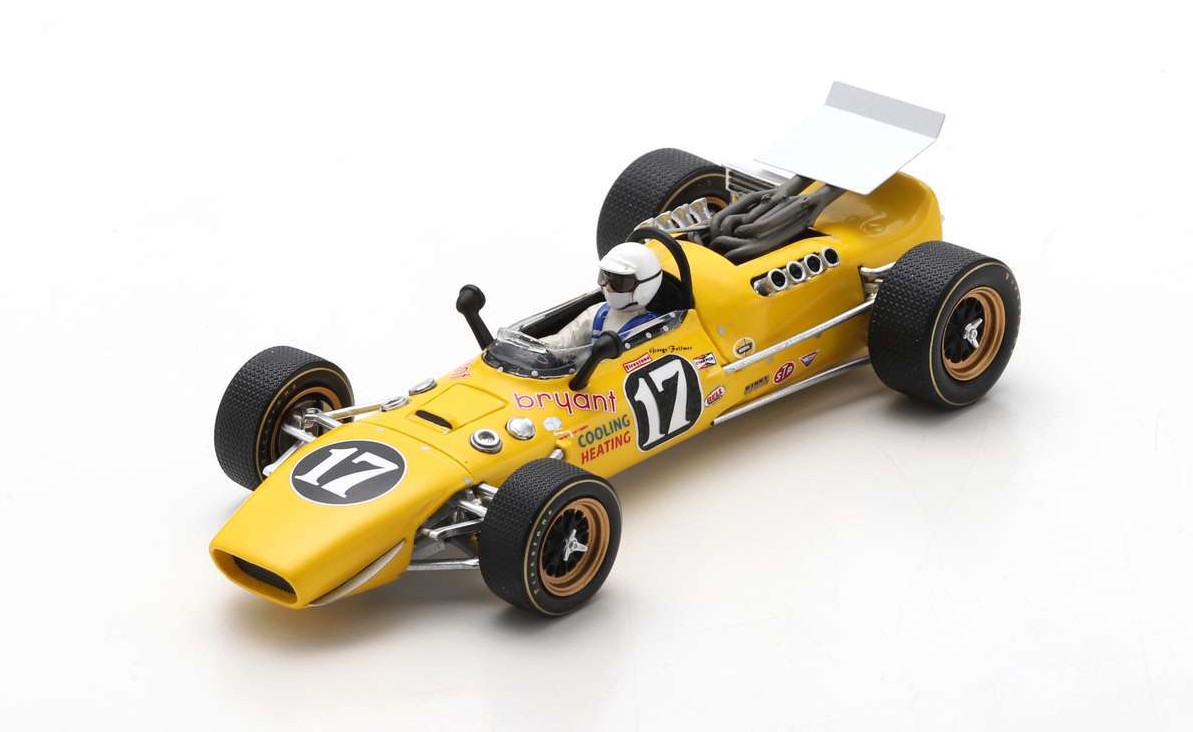 Spark: Vollstedt-Ford 1967 Riverside GP Follmer 6th
Spark: Vollstedt-Ford 1967 Riverside GP Follmer 6th
In 1960, the President of the Toyo Kogyo Company (later to be renamed Mazda in 1984, although every automobile sold from the beginning bore that name) made a bold trip to Germany to meet with executives from NSU Motorenwerke to negotiate the licensing rights for the German company's Wankel engine. After the deal was signed in 1961, Mazda received a prototype 400cc NSU rotary engine and they began development in earnest. In 1967, Mazda released its first rotary powered car, the Cosmos Sport 110S of which only 1500 units were produced until its discontinuation in 1972. To prove the reliability of the rotary engine, Mazda selected the most grueling test in Europe, the 84-hour Marathon de la Route at the Nurburgring circuit in 1968 (see After Thoughts October 2023). Two mostly stock Cosmos were entered, along with 58 other cars. The cars ran together in fourth and fifth place for most of the race but one car retired with axle damage in the 82nd hour but the second car finished the race in fourth overall. Spark has produced both of these significant cars from this innovative Japanese car manufacturer.
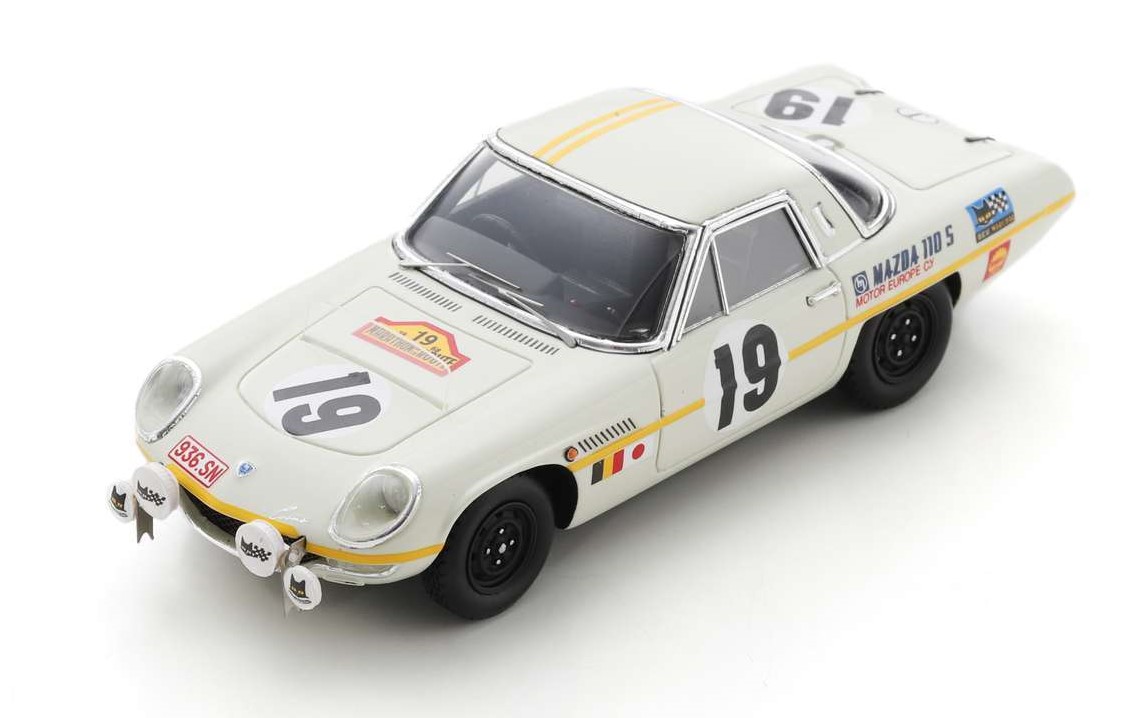 Spark: Mazda Cosmo Sport 110S, 4th 84-hr race '68
Spark: Mazda Cosmo Sport 110S, 4th 84-hr race '68
OK, that's it for another month. There are two events scheduled for November; the regular monthly Sydney Toy and Hobby Fair on 3 November and the Penrith CollectorCon show on 26 November. Also, I'd like to wish the organisers of the Diecast Model Expo (3-5 November) every success, unfortunately I couldn't make the trip down to Melbourne for this event. Finally, just a quick plug for the Sydney Model Auto Club who run the Sydney Toy and Hobby Fair; the club holds their monthly meetings on the 1st Wednesday of every month (except January) at the Magpie Sports Club, 40 Hampton Street, Croydon Park starting around 7:00pm. Every month there is a display theme and members are encouraged to bring along some models to display. I'm always amazed at the range and quantity of models that members have collected over the years. Visitors are welcome to attend. Until next month, happy collecting.
Formula One / Safety Cars
- 1961 Lotus Climax 18/21, S.Moss (7) 1st German GP "Rob Walker Racing" (Spark)
- 1973 March Ford 731, J-P.Jarier (18) US GP (Spark)
- 1975 March Ford 751, H.Stuck (10) German GP (Spark)
- 1981 March Ford 811, D.Daly (17) British GP (Spark)
- 1995 Simtek Ford S951, D.Schiattarella (11) Monaco GP (Spark)
- 1975 Surtees Ford TS16, J.Watson (18) Spanish GP (Spark)
- 1975 Williams Ford FW, D.Magee (20) Swedish GP (Spark)
- 2021 Aston Martin Vantage V8, Twin-turbo 4-litre V8 F1 Safety Car (Spark)
- 2021 Aston Martin DBX V8, Twin-turbo 4-litre V8 F1 Medical Car (Spark)
American Racing Series
- 1967 Vollstedt Ford, C.Yarborough (21) 17th Indy 500 (Spark)
- 1967 Vollstedt Ford, G.Follmer (17) 6th Riverside Indy GP (Spark)
Le Mans / Sports Cars Racing
- 1967 Ford GT40, Greder/Giorgi (130) 5th Targa Florio (Spark)
- 1968 Mazda Cosmo Sport 110S, Koga/Katayama/Katakura (18) Nurburgring 84hr (Spark)
- 1968 Mazda Cosmo Sport 110S, Dernier/Deprez/Ackermans (19) Nurburgring 84hr (Spark)
- 1997 Panoz Esperante GTR-1, D.Brabham/Bundy/McCarthy (55) Le Mans (Spark)
- 1965 Porsche 904/6 GTS, Maglioli/Linge (176) 3rd Targa Florio (Spark)
- 1966 Porsche 906, Bourillot/Maglioli (150) 5th Targa Florio (Spark)
- 1967 Porsche 910, Siffert/Herrmann (218) 6th Targa Florio (Spark)
- 1967 Porsche 910, Elford/Neerpasch (166) 3rd Targa Florio (Spark)
- 2021 Porsche 911 RSR-19, Ried/Evans/Campbell (77) Le Mans (Spark)
After Thoughts: "How to Spice Up F1" I came across an opinion piece recently, written by Roland Dane in SpeedCafe.com which I found very interesting and I'd like to share with you. For those who are unaware, especially readers outside of Australia, Roland Dane was until recently the owner of Triple 8 Engineering, a very sucessful Supercars team that has won 10 Drivers' Championships, 11 Teams' Championships and 10 Bathurst 1000 races. Roland's motorsports credentials are of the highest order and he's made some interesting observations. I've edited and paraphased his article to condense his main points...
"A visit to the recent Austrian GP served to reaffirm several observations I have about the current state of Formula 1. There's no doubt that F1 is booming in terms of profile and attendances, however, I don't feel the racing itself is that great much of the time. Often there's not that much real action after Lap 1 and the Hungarian GP was positively soporific. I'm the first person to acknowledge that not every race is going to be a great one. But I do feel part of the problem is that F1 is becoming a victim of the sheer excellence of the teams in perfecting their performances to a level that the show suffers as a consequnce of the elimination of errors.
Some fixes, like the sheer size of the current cars for instance will take a long time to implement even when they're agreed in the first place. Make the cars physically smaller and that will create more potential for side-by-side racing, like F2 and F3. However, to spice things up in the shorter term, I'd make three changes:
- Carry through with the planned tyre warmer ban for next year. Cold tyres should not only make the out laps more difficult but should also change strategic approaches to the race. Some say that it will be dangerous but it would only bring F1 into line with many other categories. Moreover, there are already instances when teams send cars to the end of pit lane to await the start of a qualifying session and sitting in cool conditions for several minutes will cause much of the tyre heat to dissipate. So, it doesn't make sense to object to the banning of tyre warmers on the basis of safety. Also, F2 and F3 drivers (who are less experienced) run without blankets on the same brand of tyres at the same events. Oh, and remember, F1 ran very well for decades without tyre blankets ... teams started to use them for performance, not safety.
- Drastically reduce the number of personnel allowed to participate in a pit stop. There are regularly 20 people involved in a typical stop! There's simply no need for such excess. I'd mandate the use of air jacks on the cars; that would cut 3 people immediately. Cut the wheel people from 3 per wheel to two. And finally, if a team wants to make wing adjustments, or any other changes, then they would be carried out by the wheel crews. The stops will be slower and more susceptible to errors from time to time. Whilst we're at it, F1 should also insist that the outer wheel guns are removed from the pit lane instead of being left on the ground throughout a race. Surely any decent risk assessment of pit lane would establish that having them left in the lane, and often with crew standing there to hold the lines back from the entry or exit line of a neighbouring pit bay, is undesirable.
- DRS (Drag Reduction System) should be changed in the way it is deployed in my opinion. Currently, the system is allowed to be used any time (within the designated zones) during practice and qualifying and then, during races, when a car is within a second of a prededing car. I would ban the use of DRS during qualifying. Allow its use during practice to ensure it's working but why is it used in qualifying? DRS only exists to help with overtaking which isn't relevant in qualifying. And then during a race, instead of unlimited use when a car is in the zone and within a second of the car in front, I'd allow it's unlimited use by each driver, regardless of car position relative to another, up to a maximum time limit for the race. So, for instance, the time limit might be 200 seconds for a race. But the driver can choose to use it any time he or she chose during the race. It would operate as a push-to-pass system which would allow defence as well as attack. When you've used it up then it's gone.
Of course teams will habitually push back on almost any change, so don't hold your breath waiting for the type of changes I'm advocating! But it's fun to speculate."
Thanks, Roland for your considered thoughts.
New Additions: October 2023
Welcome to the October update. Firstly, thanks to everyone who stopped by my stand at the Hawkesbury Model and Hobby Show during the weekend of 16/17th September. The weather was fantastic, perhaps a bit warmer than normal for this time of year (34°C/93°F). Some new models from the prolific manufacturer Spark arrived in time for this month's update. Two models are especially worthy of a mention ...
At Le Mans in 1966 all eyes were on the battle of egos between Henry Ford and Enzo Ferrari. But amongst the GT40's and the 330 P3's, sitting in 42nd position on the grid was a car entered by the little-known Scuderia San Marco team. It was a Serenissima Spyder, powered by a Serenissima 3.5-litre V8. The car was one of two spyders built on the chassis from a Ferrari 308 V Berlinetta by Count Giovanni Volpi with an aluminium body fashioned by the coachbuilder Fantuzzi. Unfortunately, the Le Mans adventure was cut short; the Spyder had to retire with a broken transmission after 5 hours. The Serenissima brand and the racing team disappeared in 1970, as competition became more professionalised and rising operational budgets prevented Volpi from being able to keep up with the big teams. The original Le Mans car survived, seemingly to have been wheeled straight into storage after the race and was put up for auction in 2019 where it was sold for 4,218,800 €. This (cheaper) model by Spark will be a welcome addition to any Le Mans collection.
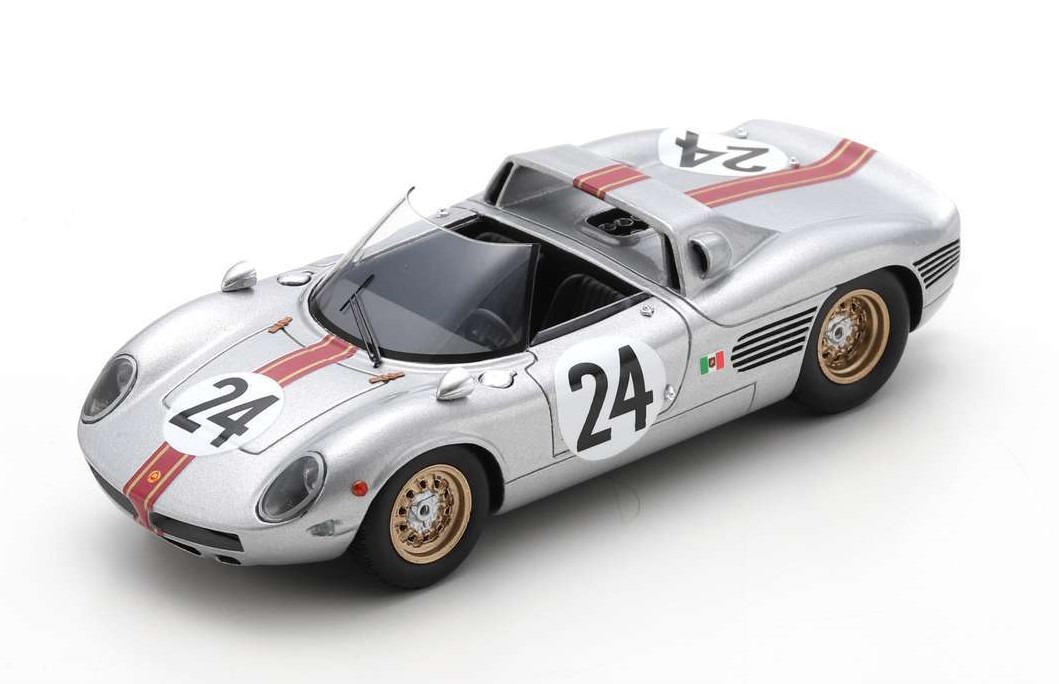 Spark: Serenissima Spyder 1966 Le Mans
Spark: Serenissima Spyder 1966 Le Mans
If not the most beautiful rally car ever built, it is certainly the most recognisable; its aerodynamic shape has a timeless beauty to it. I'm referring, of course to the Lancia Stratos HF. Apart from its good looks, it was also very successful winning the World Rally Championship in 1974, 1975 and 1976. It also won the 1974 Targa Florio. The design house, Bertone seeking to create a relationship with Lancia were aware of Lancia's intention of replacing the aging Fulvia for rallying. Bertone decided to design an eye-catching model to show to Lancia. The result was the Stratos Zero concept car. When Bertone himself appeared at the Lancia factory gates with the Stratos Zero he passed underneath the barrier, to the great applause from the workers. Twelve months later, the Lancia Stratos HF was unveiled in 1970 and the rest is history. The two Stratos models from Spark are from the 1976 Monte Carlo Rally and one that competed in the 1978 European Rally Championship.
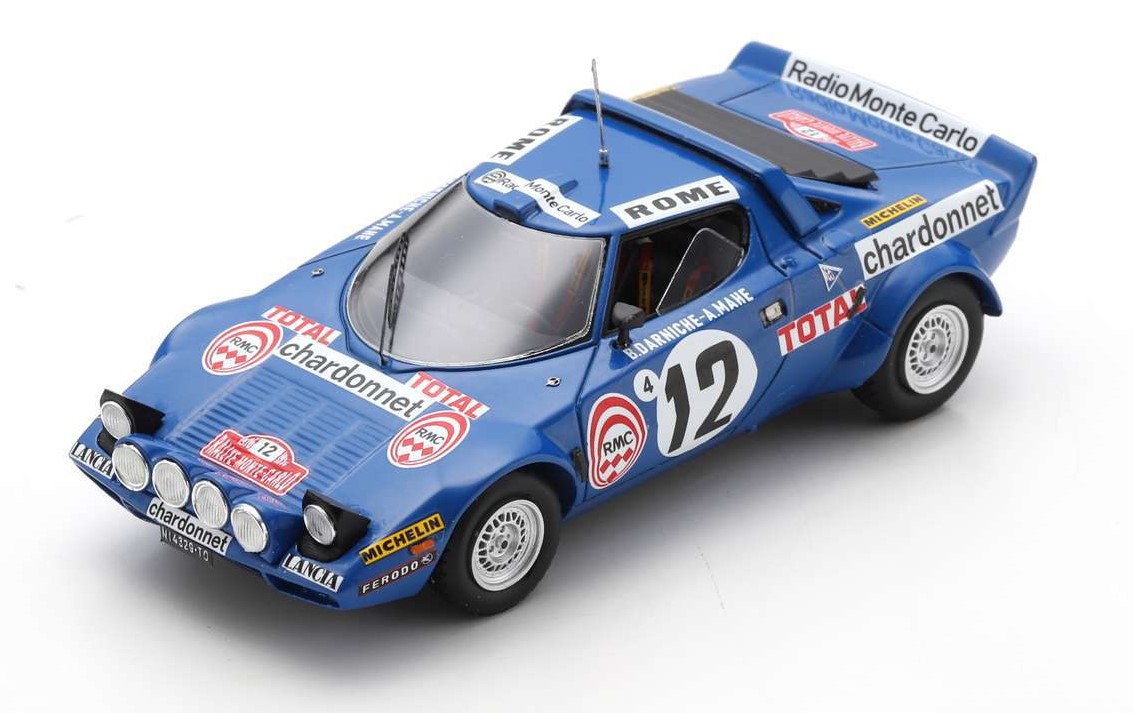 Spark: Lancia Stratos HF 1976 Monte Carlo Rally
Spark: Lancia Stratos HF 1976 Monte Carlo Rally
Well, that about wraps it up for another month. After a busy couple of months, October is going to be a relatively quiet one for model fairs, just the regular 1st Friday Sydney Toy and Hobby Fair at the Epping Creative Centre on 6 October. However, you may be interested in a car show held at the Windsor High School on Sunday 15 October (9 am - 1 pm). OK, that's it, happy collecting until next month.
Formula One
- 1990 AGS Ford JH25, G.Tarquini (17) Hungarian GP (Spark)
- 1967 Brabham Climax BT11, D.Charlton (19) South African GP (Spark)
- 1967 Lola BMW T100, H.Hahne (17) German GP (Spark)
- 1975 Lotus Ford 72E, J.Ickx (6) 2nd Spanish GP "JPS" (Spark)
- 1973 March Ford 731, J.Hunt (27) Austrian GP (Spark)
- 1975 March Ford 751, L.Lombardi (10) 6th Spanish GP (Spark)
- 1976 Penske Ford PC3, J.Watson (28) Monaco GP (Spark)
- 1995 Tyrrell Yamaha 023, M.Salo (4) Brazilian GP (Spark)
Le Mans / Sports Car Racing
- 1985 BMW M1, Grohs/Heger/König (152) Le Mans (Spark)
- 1967 Ford GT40 MkIV, McLaren/Donohue (2) 4th Le Mans (Spark)
- 2021 Glickenhaus 007 LMH, Derani/Mailleux/Pla (708) Le Mans (Spark)
- 1970 Matra Simca MS650, J.Brabham/F.Cevert (32) Le Mans (Bizarre)
- 1966 Porsche 906, Arena/Pucci (144) 3rd Targa Florio (Spark)
- 1967 Porsche 910, Cella/Biscaldi (174) 2nd Targa Florio (Spark)
- 1971 Porsche 908/3, Siffert/Redman (7) Targa Florio (Spark)
- 1966 Serenissima Spyder, Sauer/de Mortemart (24) Le Mans (Spark)
Rally
- 1977 Alpine A310, Fréquelin/Delaval (11) Rally Monte Carlo (Spark)
- 1973 Datsun 240Z, Aaltonen/Easter (10) 18th Monte Carlo Rally (Spark)
- 1976 Lancia Stratos HF, Darniche/Mahé (12) 3rd Monte Carlo Rally (Spark)
- 1978 Lancia Stratos HF, Carello/Perissinot (3) Championnat d'Europe des Rallyes (Spark)
- 1979 Porsche 924 Carrera GTS, Janda/Ristl (48) Monte Carlo Rally (Spark)
After Thoughts: "Le Marathon de la Route: An Extreme Endurance Epic" Imagine racing at the Le Mans 24 hour race and at the end, you keep on racing for another 24 hours ... and then another 24 hours and then a further 12 hours. Between 24-28 August, 1965 at the Nürburgring Nordschleife circuit, 35 cars started in the first Marathon de la Route, an 84-hour endurance race for production cars. Amazingly, 24 cars finshed. This endurance race, known as the "World's Longest Motor Race" was run between 1965 to 1971.
 Poster celebrating Porsche's Marathon win in 1970.
Poster celebrating Porsche's Marathon win in 1970.
The 84-hour race was created to replace the equally tough Liège-Rome-Liège rally (later the Liège-Sofia-Liège rally) which was a thinly disguised road race over some of Europe's tougest mountain roads. The route took in six countries and included more than 30 mountain passes and was completed in just over 90 hours of almost non-stop driving. With the increased performance of sports cars, it was only a matter of time before this type open road racing would be banned from using public roads. Hence the Marathon de la Route was born. Manufacturers liked the event because it gave them the opportunity to test their cars and any new components. As there weren't too many spectators, if something went wrong it would probably go unnoticed. Also, as one chief engineer remarked, "it was always much cheaper to do this race than go to the Ring for private testing."
The 84-hour Marathon had some of the strangest rules of any motor sport event of the time. For example:
- Teams had to complete the same number of laps in the last 12 hours as they had done in the first 12 hours.
- After the first 4 hours, competitors had to complete one lap every 24 minutes. Teams were disqualified for exceeding this time. The total distance for one lap was 28.265 km so a minimum average speed of 70.7kph was required.
- Refuelling was done using a normal petrol pump before the pits.
- Tyre and driver changes were done in the pits, but a pitstop longer than a minute resulted in a lap being deducted from the team's total.
- To avoid this penalty, repairs could be carried out during the race in one of 3 ways. (1) On the track with spares carried in the car. (2) In a designated parc ferme area away from the pits where only the driver can work on the car with verbal assistance only from mechanics. No time limit was imposed if work was done in this area but since you had to drive past your pits to get there, you effectively started a new lap which still had to be completed within 24 minutes. Often cars left parc ferme without finishing the repair in order to complete the lap without exceeding 24 minutes. (3) In the pits where two mechanics could work on the car, with the lost lap penalty being applied for every minute stopped in the pits.
- Because cars were subjected to such extreme punishment, the organisers arranged relief windows of 20 minutes where repairs could be done with no penalties. These windows occurred between laps 75-80, again between laps 150-155 and so on. So teams tried to save up their repairs for these windows which occurred after 2120 kms of racing.
- There was no official qualifying for grid postions, the race authorities simply placed what they considered the faster cars at the front. There were no complaints.
The entry list for the inaugural Marathon included cars such as the Porsche 904 GTS, Porsche 356, BMW 1800, Volvo 122 S, Ford Mustang, Alfa Romeo Giulia TZ, Glas 1204 TS, Tatra 2-603, Honda S600, Mini Cooper S, Ferrari 250GT, Daf 750GT, Peugeot 204 and Volvo P1800. At the conclusion of the race, Ford Mustangs were first and second, both completing 310 laps. Third was a Porsche 904 GTS which covered 309 laps. All the entrants used only two drivers so it was a gruelling test of skill, patience and stamina for the drivers as well as the car's speed and durability. From 1967 onwards, three drivers could be used.
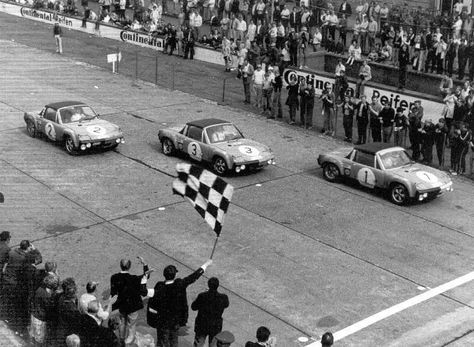 Porsche 914/6 wins in 1970 (Photo: Pinterest)
Porsche 914/6 wins in 1970 (Photo: Pinterest)
The grid size continued to increase every year; 1970 saw the biggest participation with 64 cars starting the race with the Porsche 914/6 taking the first three positions. However, the 1971 race was the beginning of the end. Only 39 entries showed up and no works team were among them. Only a handful of spectators bothered to turn up and the race was never repeated.
New Additions: September 2023
Welcome to the September update. Winter is now over, not that it was all that cold or wet this year. I would like to thank all those who dropped by garage 19 at the Shannons Sydney Classic Day on 20 August and especially those who found a model or two for their collection. It was a great day with plenty of beautifully presented cars on display and sunny skies as well; I hope to see you all again next year. Only a handful of new additions to report this month and there is one model that really stood out for me...
The Riverside International Raceway was a race track located near Los Angeles. Before its last race in 1988 it was remembered as the home of road racing in southern California and one of the most challenging tracks in the USA. On the last Sunday of October 1965, the 8th Annual Los Angeles Times Grand Prix for Sport Cars was held over a distance of 200 miles. Drivers contesting the race included the likes of Jim Clark, Bruce McLaren, Chris Amon, Hap Sharp, George Follmer, David Hobbs, Dan Gurney and A.J.Foyt. Foyt was entered driving a Ford-powered Lotus 40 but an accident during practice prevented the beautiful white car from starting. Hap Sharp won the race in a Chaparral 2A Chevrolet. Tecnomodel, an Italian model manufacturer produced just 130 examples of Foyt's sleek Lotus 40.
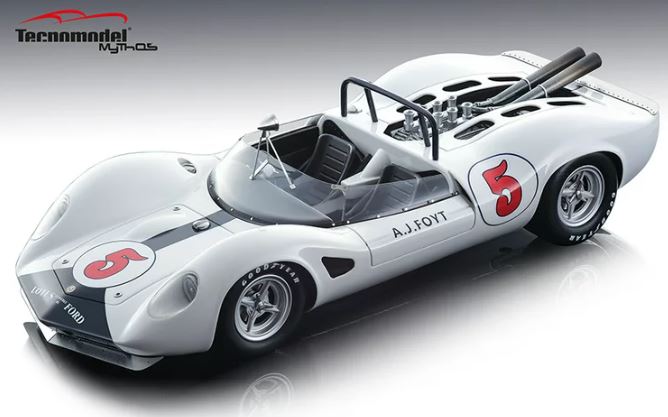 Tecnomodel: Lotus 40 Foyt Riverside GP 1965
Tecnomodel: Lotus 40 Foyt Riverside GP 1965
OK, that's a wrap up for another month. So, what's on in September? First up is the regular 1st Friday Sydney Toy and Hobby Fair at the Epping Creative Centre (1st September) and then on 16 and 17 September the Hawkesbury Model and Hobby Show will be held. It's a two day event and I'll be there both days. Incidentally (and unfortunately) also on 17 September will be the All British Day and the CollectorCon (Penrith) Fair, both of which I will miss out on attending this year. Until next month, happy collecting.
Formula One
- 1951 Alfa Romeo 159M, J.M.Fangio (24) 1st Swiss GP (Tecnomodel)
- 1951 Ferrari 375, F.Gonzales (12) 1st British GP, 1st Ferrari win (Tecnomodel)
Le Mans / Sports Car Racing / Support Vehicle
- 1979 Aston Martin AM V8, Hamilton/Bell/Preece (12) Silverstone (Tecnomodel)
- 2008 Aston Martin AM V8, R.Cann (009) AMOC Champions (Tecnomodels)
- 1966 Ford Transit Mk1, Porsche Racing Service Van (IXO)
American Racing Series
- 1965 Lotus Ford 40, A.J.Foyt (5) 200 mi. Riverside GP (Tecnomodel)
Rally
- 1964 Ford Mustang, Ljungfeldt/Sager (82) Rallye Tour de France (PremiumX)
Road Cars
- 1963 Chevrolet Corvette Stingray in red/white (IXO)
- 1967 Ford Mustang Fastback in black/red (IXO)
- 1984 Ford Escort MkIII RS Turbo in white (IXO)
- 2019 Mazda MX-5 in silver (IXO)
- 1976 Porsche 924 in green (Maxichamps)
- 2001 Volvo V40 in dark metallic blue (PremiumX)
Helmets (1:5)
- 2020 A.Albon - Red Bull Helmet (Spark)
- 2020 P.Gasly - Alpha Tauri Helmet (Spark)
- 2020 A.Giovinazzi - Alfa Romeo Helmet (Spark)
- 2022 L.Hamilton - Mercedes Monaco GP (Spark)
- 2020 E.Ocon - Renault Helmet (Spark)
- 2022 E.Ocon - BWT Alpine Helmet (Spark)
- 2020 D.Ricciardo - Renault Helmet (Spark)
- 2020 C.Sainz Jr. - McLaren Helmet (Spark)
- 2022 G.Zhou - Alfa Romeo Helmet (Spark)
After Thoughts: "When a Dune Buggy (nearly) raced at the Daytona 24 Hour" There are some things you never expect to see on a racing circuit, like a VW-based dune buggy which is more at home on sandy beaches or arid deserts. However, this did not stop a group of privateers from entering a dune buggy in the 1970 24 Hours of Daytona as a prank, only to qualify for the race and then be granted permission to start. They would have started the race had it not been for an encounter with a Porsche.
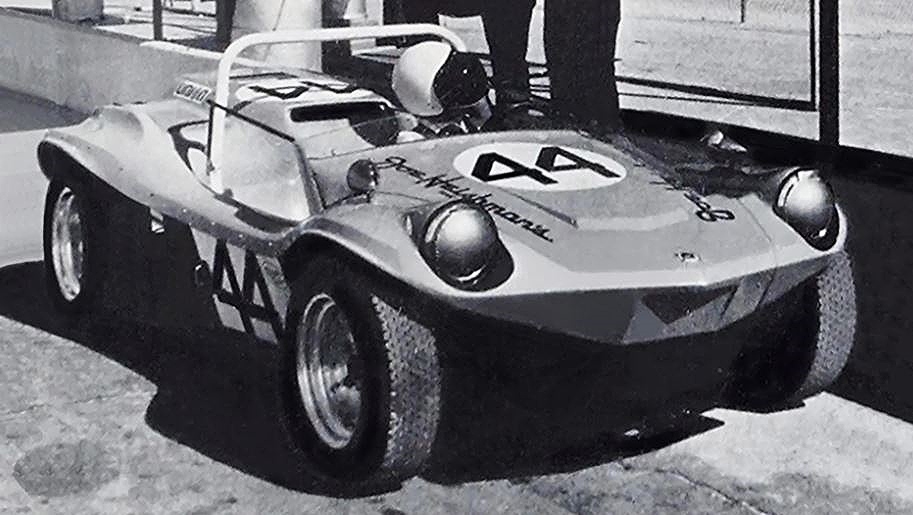 Deserter GS Volkswagen Dune Buggy at Daytona
Deserter GS Volkswagen Dune Buggy at Daytona
The 1970 Daytona 24 Hour was most noted for being the debut race for the Ferrari 512S, Enzo's answer to the Porsche 917K. The seriousness with which the two marques approached the race was matched only by the flippancy of Porsche/Volkswagen dealer Hugh Heishman, who entered a dune buggy into the race "as a novelty". Heishman's car was built in collaboration with Dearborn Automobile Company which specialised in Formula Vee race cars. By matching a tube-framed Fomula Vee chassis with a "Deserter" buggy kit, the company produced the Deserter GS Volkswagen which was essentially a dressed-up open-wheel racer. The Daytona buggy was powered by a modest VW engine; a 1.7 litre flat-four that produced around 68 to 80 horsepower. Going by the Deserter GS stated weight of 1,100 pounds, the buggy had a power-to-weight ratio between 110 to 160 horsepower per ton; well above some of sports cars entered for the Daytona race. It was however, no match with the front-running Porsches in the prototype class where the buggy was classified due to its hand-built construction.
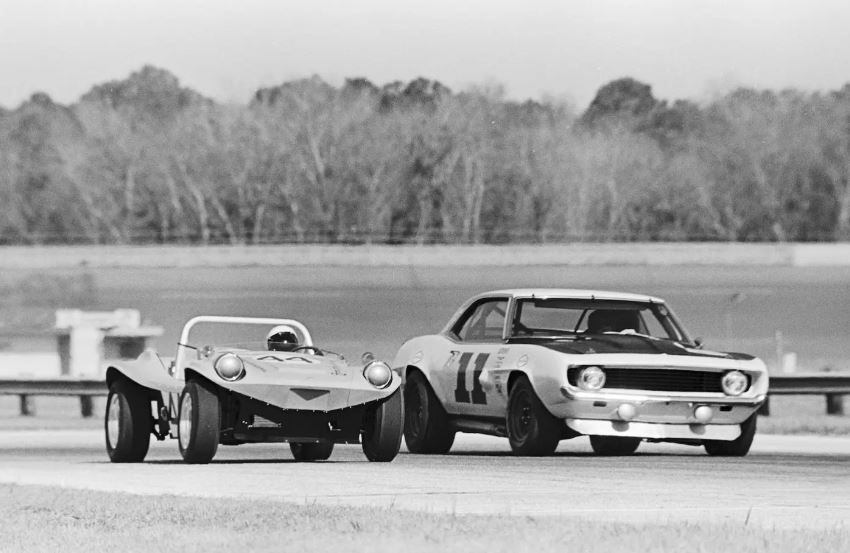 The Deserter GS buggy on the race track
The Deserter GS buggy on the race track
Heishman enlisted three employees from his car dealership to drive the buggy, all of whom had competitive racing experience. One of the drivers was Jon Krogsund who was an experienced IMSA GT driver. Krogsund was running practice laps around the Daytona circuit when the JW Automotive team sent out its Porsche 917K practice car driven by Jo Siffert. According to an eyewitness account, Siffert came across the Deserter GS buggy entering turn three and attempted to pass on the straight before turn four. Krogsund was seen to be holding his line exiting turn 3 but the two cars made contact. The dune buggy wasn't seriously damaged and limped back to the pits. The Porsche fared worse with damage to the left rear wheel and to its suspension; the car would not return to the track all weekend. JW Automotive were furious and filed a complaint alleging the buggy was being driven erratically. The race stewards investigated and came to the conclusion it was a racing incident. The Deserter GS was cleared to start the race.
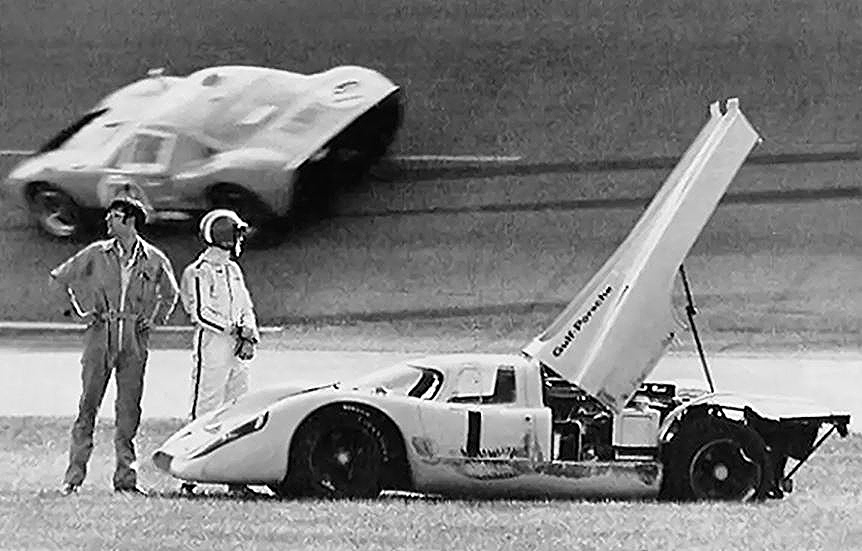 Damaged Porsche 917 after colliding with the buggy
Damaged Porsche 917 after colliding with the buggy
On race day, the Deserter GS did not line up on the starting grid; not because of the race organisers or JW Automotive, but because Heishman had withdrawn the car. Heishman who was a Porsche dealer didn't want any ill-feeling from Porsche that could impact on his livelihood. Heishman later recalled, "I didn't want to be accused of causing Porsche any more grief." The Deserter dune buggy did however leave its mark on endurance racing at Daytona; the following year slower, grassroots entries were effectively barred from starting if they could not qualify within a specified lap time.
Acknowledgement: This article was based on an article by James Gilboy which appeared on the website "www.thedrive.com." and the full version can be found at https://www.thedrive.com/accelerator/43165/this-dune-buggy-wouldve-raced-the-daytona-24-if-it-werent-for-porsche
New Additions: August 2023
Welcome to another monthly update. The new addtions in the F1 category are all 2022 cars and all bar the Ferraris are Spark models; the Prancing Horse cars are from the Italian model maker Looksmart. The offerings in the Le Mans / Sportscar section are a little more varied and it's from here that I've selected a couple of models to highlight.
The Aston Martin AM V8 racing car was a highly modified DBS V8 developed by Robin Hamilton for racing at Le Mans. Whilst it was not a works car, support was provided by Aston Martin and in fact, the lessons learnt from Hamilton's work were applied to future Aston Martin models. The car, (now unrecognisable from the original) had undergone extensive modifications from 1974 to 1977 was given the designation "RHAM/1" and was ready in time to race at Le Mans in 1977 and also in 1979. In 1977, it finished 17th overall and 3rd in the GTP class but it had to retire after 21 laps at the '79 edition of the race. When Hamilton drove across the Le Mans finishing line in 1977, he achieved a lifelong ambition and also confounded the pundits who claimed the heavyweight DBS V8 was totally unsuitable for racing. The Italian model maker, Tecnmodel has produced four limited edition versions of this unique racing car.
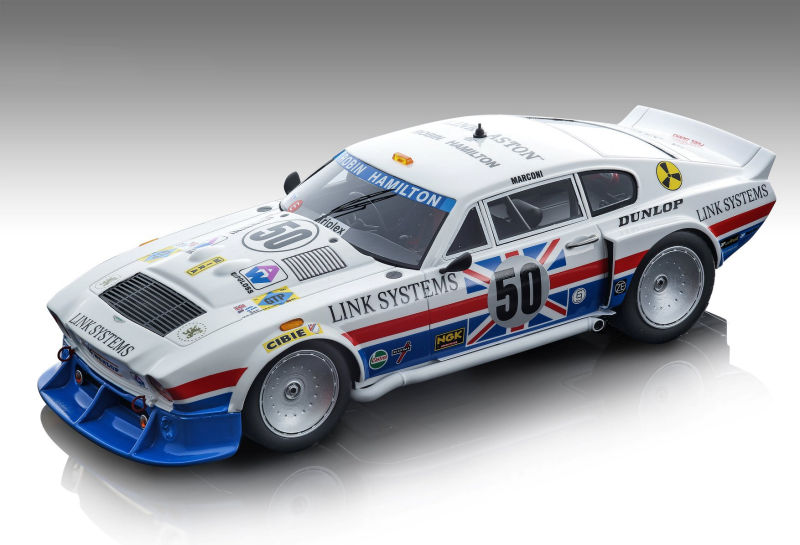 Tecnomodel: Aston Martin AM V8 - Le Mans 1979
Tecnomodel: Aston Martin AM V8 - Le Mans 1979
Liam Lawson is a young, loyal Red Bull academy driver and the New Zealander is currently the reserve driver for the Red Bull and Alpha Tauri Formula One teams. While waiting for his chance in the main game, he is honing his skills in the Japanese Super Formula Championship where he is currently second in the Red Bull sponsored Honda powered Dallara of Team Mugen. In 2021, Lawson was racing in the DTM (Deutsche Tourenwagen Masters) series in a Ferrari 488 GT3 Evo with the Red Bull AF Corse team and finished a close second overall and the first Junior driver. Looksmart has produced a very nice model of this Ferrari 488 GT3.
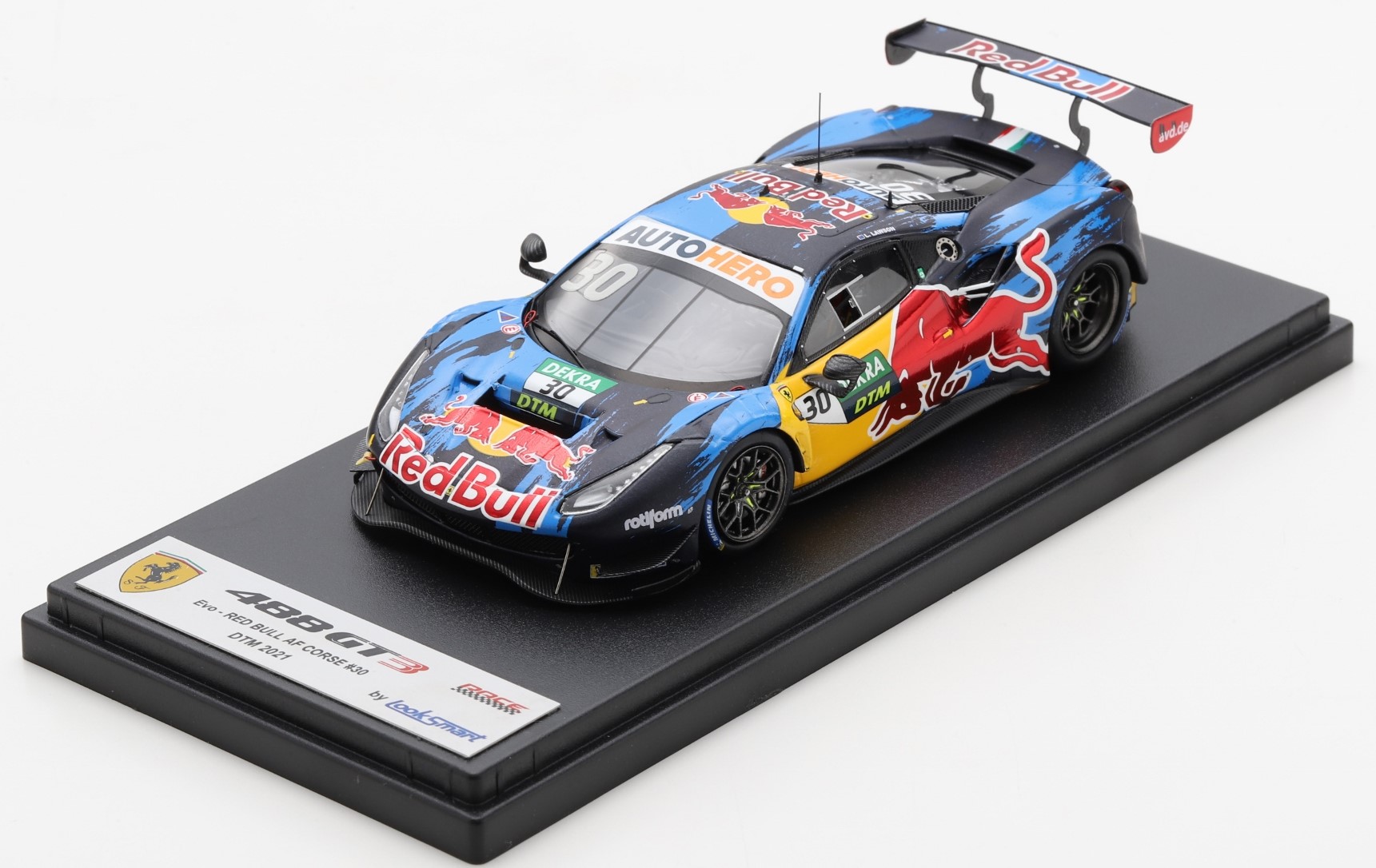 Looksmart: 2021 DTM Liam Lawson Ferrari 488 GT3
Looksmart: 2021 DTM Liam Lawson Ferrari 488 GT3
Ok, that wraps up another monthly update. There are two shows in August; the first is the regular monthly Friday night Sydney Toy and Hobby Fair on 4 August at the Epping Creative Centre. The second is the Shannons Sydney Classic Car Day on 20 August at the Sydney Motorsport Park, Eastern Creek, it's a great day out if you love your motor cars. Come to garage 19 and say hello! Until next month, happy collecting.
Formula One
- 2022 Alfa Romeo Ferrari C42, Bottas (77) 6th Bahrain GP (Spark)
- 2022 Alfa Romeo Ferrari C42, Zhou (24) 10th Bahrain GP (Spark)
- 2022 Aston Martin Merc AMR22, Hülkenberg (27) Bahrain GP (Spark)
- 2022 Ferrari F1-75, Leclerc (16) 1st Bahrain GP (Looksmart)
- 2022 Ferrari F1-75, Sainz Jr. (55) 2nd Bahrain GP (Looksmart)
- 2022 McLaren Merc MCL36, Ricciardo (3) Australian GP (Spark)
- 2022 Mercedes AMG W13, Russell (63) 4th Bahrain GP (Spark)
- 2022 Mercedes AMG W13, Russell (63) Miami GP (Spark)
- 2022 Red Bull RBPT RB18, Perez (11) 1st Pole Saudi Arabian GP (Spark)
- 2022 Red Bull RBPT RB18, Perez (11) 1st Monaco GP (Spark)
Le Mans / Sports Cars
- 1932 Alfa Romeo 8C, Sommer/Chinetti (8) Le Mans winner (Spark)
- 1979 Aston Martin AM V8, Hamilton/Salmon/Preece (50) Le Mans (Tecnomodel)
- 1980 Aston Martin AM V8, Hamilton/Bell/Green (10) Silverstone (Tecnomodel)
- 2021 Ferrari 488 GTE EVO, Guidi/Calado/Ledogar (51) 1st LM GTE Pro (Looksmart)
- 2021 Ferrari 488 GTE EVO, Lawson (30) 'Red Bull AF Corse' DTM (Looksmart)
- 2022 Glickenhaus 007 LMH, Pla/Dumas/Derani (708) 4th Le Mans (Spark)
- 2022 Glickenhaus 007 LMH, Briscoe/Westbrook/Mailleux (709) 3rd Le Mans (Spark)
- 2021 Peugeot 9X8 Hypercar, Hybrid all-wheel drive (presentation version) (Spark)
- 2022 Porsche 911 RSR, Fassbender/Campbell/Robichon (93) Le Mans (Spark)
American Race Series
- 1965 Ferrari 275P, Maglioli/Baghetti (33) Sebring 12 hour (Looksmart)
- 1965 Ferrari 330P, Kolb/Fulp (27) Sebring 12 hour (Looksmart)
- 1965 Ferrari 330P, Rodriguez/Hill (30) Sebring 12 hour (Looksmart)
- 1984 Lola Chevrolet T600, Kalagian/Lloyd (15) IMSA Road Atlanta 500km (Spark)
Road Cars
- 2022 Bentley Continental GT Speed in candy red (TSM)
- 2022 Lotus Emira in magma red (TSM)
- Nissan 35GT-RR LB-Silhouette Works in pink (TSM)
Misc Scales
- VW Type 2 Panel Van with trailer & VW Beetle 1:64 (Schuco)
Helmets (1:5)
- 1953 A.Ascari - Ferrari 500 helmet (Spark Editions)
- 2021 C.Leclerc - Ferrari SF21 helmet (Spark Editions)
- 1982 D.Pironi - Ferrari 126C2 helmet )Spark Editions)
- 1979 G.Villeneuve - Ferrari 312T4 helmet (Spark Editions)
After Thoughts: "The Forgotten F1 Circuits Series #5 - Pescara, Italy." The Circuito di Pescara in Italy was never on the F1 calender in 1957 but circumstances determined that it was to spend a day in the spotlight. With the Suez crisis causing petrol shortages across Europe, the scheduled Belgian and Dutch Grand Prix were cancelled in swift succession and the organising body was left to hastily fill the gaps in the calendar. Pescara, a city and circuit rich with racing heritage, was identified as a replacement. The city on the Adriatic coast hosted motorsport events from 1924 to 1961, in fact Enzo Ferrari had won the inaugral Coppa Acerbo auto race in 1924. The Coppa Acerbo was named after a prominent fascist politician and after World War Two the race was renamed the Pescara GP and hosted several non-championship F1 races in the early 1950's.
With a length of 25.579 km (15.89 miles) it was the longest circuit to ever host a World Championship Formula One race(1) and the triangular circuit was entirely made up of narrow two-lane roads winding from the centre of Pescara up into the hills, past several villages before heading back to the coast and the finish line. Notably, a chicane had been added on the sea front straight in 1934 to slow the cars down before entering the pits; Pescara being the very first F1 circuit to have an artificial chicane. The road surfaces were rough and were lined with hedges and trees; some sections featured sheer drops with no barriers and it was a fearful test for both man and machine. When Pescara was announced as a replacement race to be run on 18 August 1957, Enzo Ferrari immediately withdrew his cars from the event fearful for the safety of his drivers. However, Ferrari driver Luigi Musso who was in contention for second in the championship(2) pestered Ferrari to allow him to drive and a single Ferrari 801 was entered as a privateer.
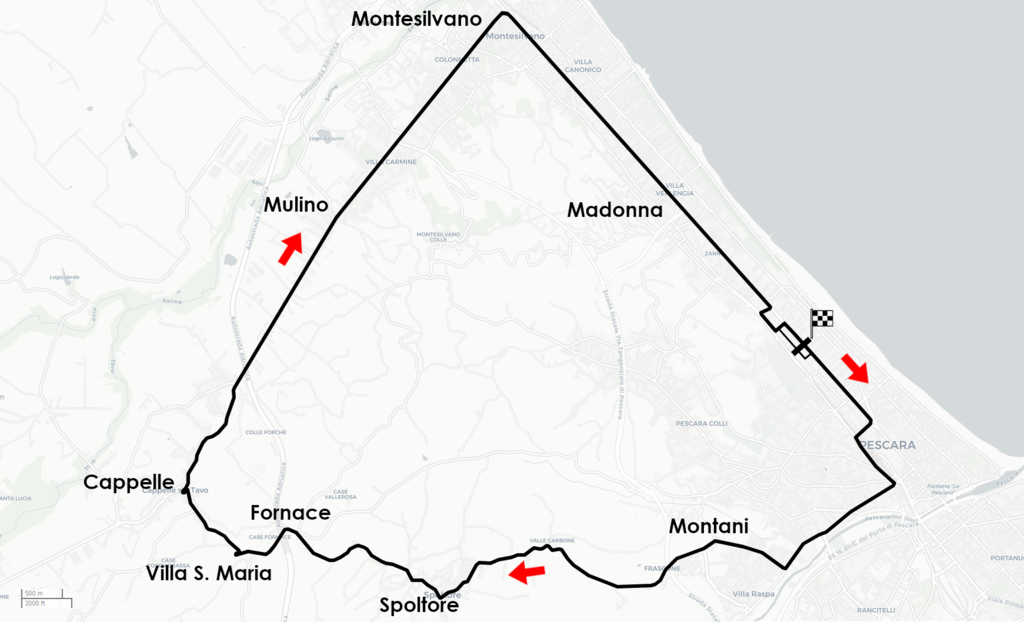 Pescara Circuit (Photo: Sayatek)
Pescara Circuit (Photo: Sayatek)
The Pescara GP was contested by 16 drivers and three official constructors, Maserati, Vanwall and Cooper. Juan Manuel Fangio was leading the championship with 34 points, ahead of Musso on 16 points and Mike Hawthorn on 13 points. It was a hot day on 18 August and Fangio (Maserati) was on pole (9.44.6 min. lap) from Moss (Vanwall) and Musso (Ferrari). Due to the length of the circuit, no attempt was made to charge an entry fee so an estimated 200,000 spectators watched the race, many from houses around the track. Musso in his Ferrari completed the first lap of the 18 lap race in the lead but Moss overtook him on the second lap and was never headed. Musso retired on lap 10 when his engined seized. Jack Brabham at the wheel of a Cooper T43 ran out of petrol on his last lap and coasted into the forecourt of an apparently closed petrol station to retire from the race. To his surprise, the proprietor rushed out and happily filled Brabham's tank with a few litres allowing him to finish the race as the seventh and last driver classified.
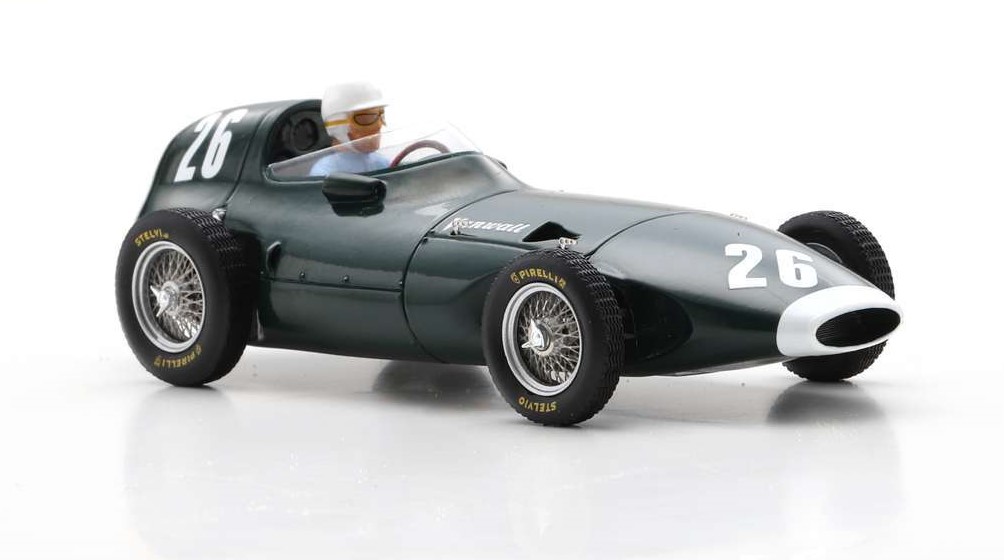 Spark: Vanwall 1st Pescara GP 1957 S.Moss
Spark: Vanwall 1st Pescara GP 1957 S.Moss
As the chequered flag fell for the last finisher, so it also fell on Pescara's time in F1. It was destined to host just a single Championship race. Racing continued on the road circuit until the last race in 1961 when it hosted a four-hour World Sportscar Championship race. After that race the circuit was permanently retired as a racing venue as it was no longer possible to guarantee the safety of drivers and spectators.
Note (1): It was longer than the old Nurburgring which was 22.81 km (14.17 miles)
Note (2): Fangio had already clinched the championship at the preceding German GP.
New Additions: July 2023
Welcome to another monthly update. I can't believe we are now half way through the year (time flies when you're having fun). Although I received a number of new additions, I can't say that many really stood out from the crowd but if I had to pick one then ...
The 1959 US Grand Prix, the last race of the season was held at the Sebring International Raceway and it was an exciting affair. This was the race where Jack Brabham, driving a Cooper Climax T51 ran out of fuel 400 yards from the finishing line and had to push his car uphill to take the chequed flag to finish 4th. It was heroic stuff with Brabham becoming the first Australian to win the world championship, although the points he scored that day didn't count as only his best 5 results mattered (his 4th place was his 6th best result). The race was eventually won by Brabham's team mate, Bruce McLaren. It was McLaren's first GP win and became the youngest ever GP winner (excluding Indy 500) at age 22 years, 104 days (this record has since been broken a few times). In addition to his prize money (a substantial US$6000), McLaren was reputed to have won several acres of land adjoining Sebring Lake as well. McLaren won four GP before he lost his life in a testing accident. His first GP winning car has been produced by Spark.
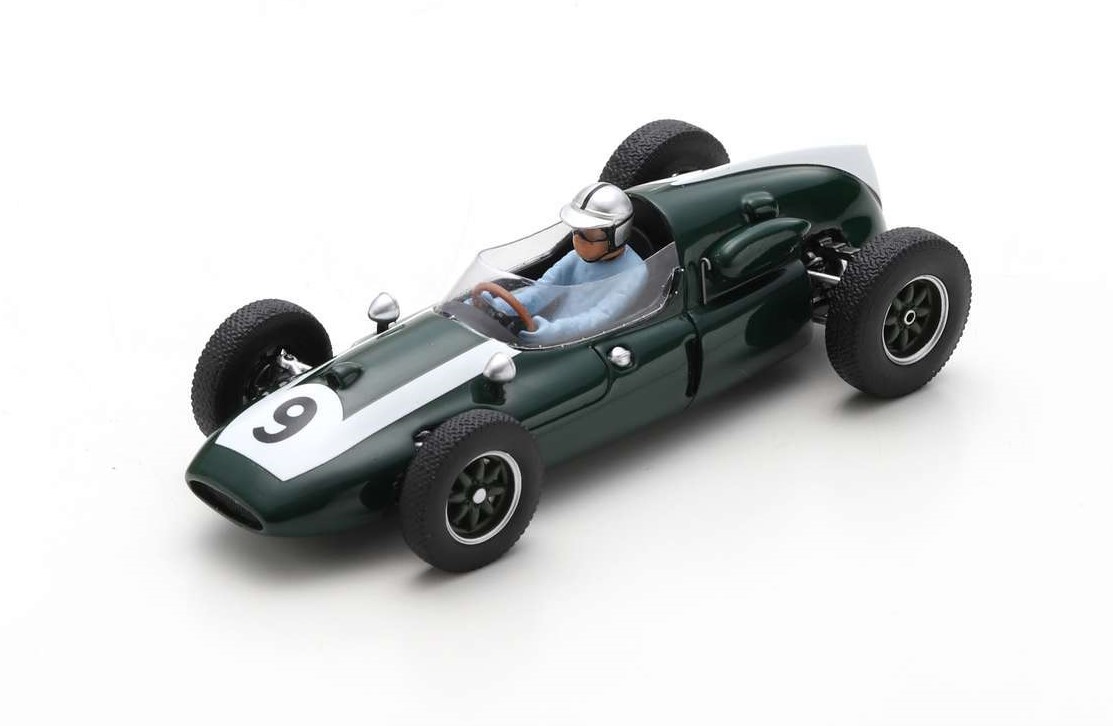 Spark: Cooper Climax T51 1st 1959 US GP.
Spark: Cooper Climax T51 1st 1959 US GP.
Well, that's it for another month. July is going to be another quiet month for model fairs, with only the regular monthly 1st Friday Sydney Toy and Hobby Fair at Epping (7 July). I hope to see you there. Until next month, happy collecting.
Formula One / Two
- 1983 Arrows Ford A6, M.Surer (29) German GP (Spark)
- 1983 Arrows Ford A6, T.Boutsen (30) Belgian GP (Spark)
- 1972 Brabham Cosworth BT38, C.Reutemann (28) 3rd Mallory Park F2 (Spark)
- 1972 Brabham Ford BT38, J.P.Jaussaud (32) 1st Hockenheim F2 (Spark)
- 1972 Brabham Ford BT38, J.P.Beltoise (5) 'Motul-Rondel Racing' GP Rouen F2 (Spark)
- 1987 Brabham BMW BT56, A.de Cesaris (8) 3rd Belgian GP (Spark)
- 1956 BRM P25, M.Hawthorn (23) British GP (Spark)
- 1959 BRM P25, H.Herrmann (11) Germany GP (Spark)
- 1960 BRM P25, G.Hill (42) Argentinian GP (Spark)
- 1959 Cooper Climax T51, B.McLaren (9) 1st US GP (1st GP win) (Spark)
- 1960 Cooper Maserati T51, M.Trintignant (18) Dutch GP (Spark)
- 1960 Cooper Maserati T51, M.Gregory (16) British GP (Spark)
- 1967 Cooper Maserati T86, J.Rindt (30) 4th Italian GP (Spark)
- 1968 Cooper BRM T86B, R.Widdows (16) British GP (Spark)
- 1981 Osella Ford FA1B, M.A.Guerra (31) San Marino GP (Spark)
- 1972 Surtees Ford TS9B, A.de Adamich (26) 4th Spanish GP (Spark)
- 1972 Surtees Ford TS9B, M.Hailwood (10) 2nd Italian GP (Spark)
- 1984 Toleman Hart TG184, S.Johansson (19) 4th Italian GP (Spark)
Le Mans
- 1953 Alfa Romeo 6C/3000 CM, Fangio/Sala (602) 2nd Mille Miglia (Spark)
- 1999 BMW V12 LMR, Martini/Winkelhock/Dalmas (15) "Dell" LM winner (IXO)
- 1964 CD Panhard, Lelong/Verrier (45) Le Mans (Spark)
- 1991 Mazda 787B, Weidler/Herbert/Gachot (55) Le Mans Winner (Edicola/Spark)
- 2014 McLaren MP4-12C GT3, Demoustier/Lapierre/Parente (98) 24hr Spa (TSM)
- 1955 Mercedes Benz 300SLR, Herrmann/Eger (704) Mille Miglia (Spark)
- 1966 Porsche 911S, Kerguen/Dewes (35) 14th Le Mans (Spark)
- 1984 Porsche 956K, Bellof/Bell (2) 1st Sandown 1000km "Rothmans" (CMR)
- 2020 Porsche 911 GT3 R, Vanthoor/Tandy/Bamber (98) 1st 24H Spa "ROWE" (Spark)
- 1989 Sauber Mercedes C9, Mass/Reuter/Dickens (63) Le Mans winner (IXO)
Road Cars / Trucks
- 1938 Alvis 4.3L Drophead in cream/black (IXO Museum)
- 1990 Ford Escort XR3i in black (Triple9)
- 2014 McLaren 650S Spider in white (TSM)
- 1999 Mercedes SL (R129) in white (Maxichamps)
- 1963 Porsche 901 in blue/grey (Triple9)
- 1955 Skoda 440 Spartak in turquoise (IXO)
- 1983 Skoda 120L in red (IXO)
- 1968 Volvo 123 GT in red (IXO)
- 1972 Volvo 144 in blue (IXO)
- 1977 Volvo 66 in red (IXO)
- 1980 Volvo 242 in green (IXO)
- 1988 Volvo 240 Polar in red (IXO)
- 1975 VW Passat Break in white (Maxichamps)
- 1990 Kenworth W900 truck cab in brown/grey (IXO)
- 1953 Mack B 61 truck cab in red/yellow (IXO)
- 1973 Peterbilt 359 truck cab in yellow (IXO)
After Thoughts: "The Great Designers - Rory Byrne" Rory Byrne's outstanding record of success as a F1 car designer puts him in the top 3 designers of all time, along with Adrian Newey and Colin Chapman. Born in South Africa in 1944, Rory's interest in motor racing began while he was studying industrial chemistry in Johannesburg; firstly as a competitor and later the technical side of racing. After graduating and then working as a chemist, Byrne continued his motoring racing activities until he decided, along with three friends to import performance car parts which ultimately changed the course of his career.
Although he had no formal engineering training, Byrne used his knowledge of mathematics to design his first car, a Formula Ford racer which achieved some success in the 1972 South African championship. Encouraged by this success, he relocated to England to pursue his racing car design career and he bought an aging Royale Formula Ford car hoping to improve its design. Shortly afterwards, as fate will have it, the owner of Royale sold his business and the new owner approached Byrne to become the designer for Royale cars. Byrne then spent the next four years designing a variety of cars for Royale and its customers. A chance introduction to Ted Toleman in 1977 presented the 33-year-old with his next opportunity.
Toleman/Benetton (1981 - 1995)
At this time, Toleman was the owner of a Formula Two team and Byrne was hired as the team's designer. After several seasons of good results, the Byrne-designed cars finally achieved first and second place in the 1980 British Formula 2 Championship. The Toleman team was now ready to step up to Formula 1. Byrne's first F1 car was the Hart-powered TG181 but it consistently failed to qualify except on two occasions. It took two seasons before Toleman scored any points, 10 in fact, earning the team a ninth in the 1983 constructors' championship. The team made steady progress up the grid, fundamental to this was Byrne's oft-repeated mantra of "evolution, not revolution", seeking to slowly hone and refine a car's potential, rather than wasting time searching for a "magic bullet" to create a vast step gain in performance. For the 1984 season, Toleman signed a driver by the name of Senna and the young Brazilian almost pulled off a miracle victory at Monaco. In 1986, the cash-strapped team was purchased by Benetton and the Hart engines were replaced by BMW power. Byrne's B186 chassis with the potent BMW scored a maiden win at the Mexican GP. A handful of wins followed in the following years before Byrne briefly departed for a stint with the ill-fated Reynard F1 project. After returning to Benetton, Byrne noticed a positive change in the team under new team boss Flavio Briatore and the talented driver, Michael Schumacher.
The 1993 car was at the cutting edge when it came to electronic aids, incorporating a semi-sutomatic gearbox, active suspension and for a while, rear-wheel steer and by the end of the year Schumacher was a regular front-runner. Schumacher took the driver's championship in 1994 and 1995 while Benetton secured the constructors' championship in 1995 much to Byrne's delight. With Schumacher's defection to Ferrari for the 1996 season, the Benetton team began to fragment and perhaps sensing that his best achievement was behind him, Byrne announced his retirement in 1996. With his Thai wife, Byrne intended to set up a scuba diving business in Phuket in his retirement but then he received a phone call from Italy.
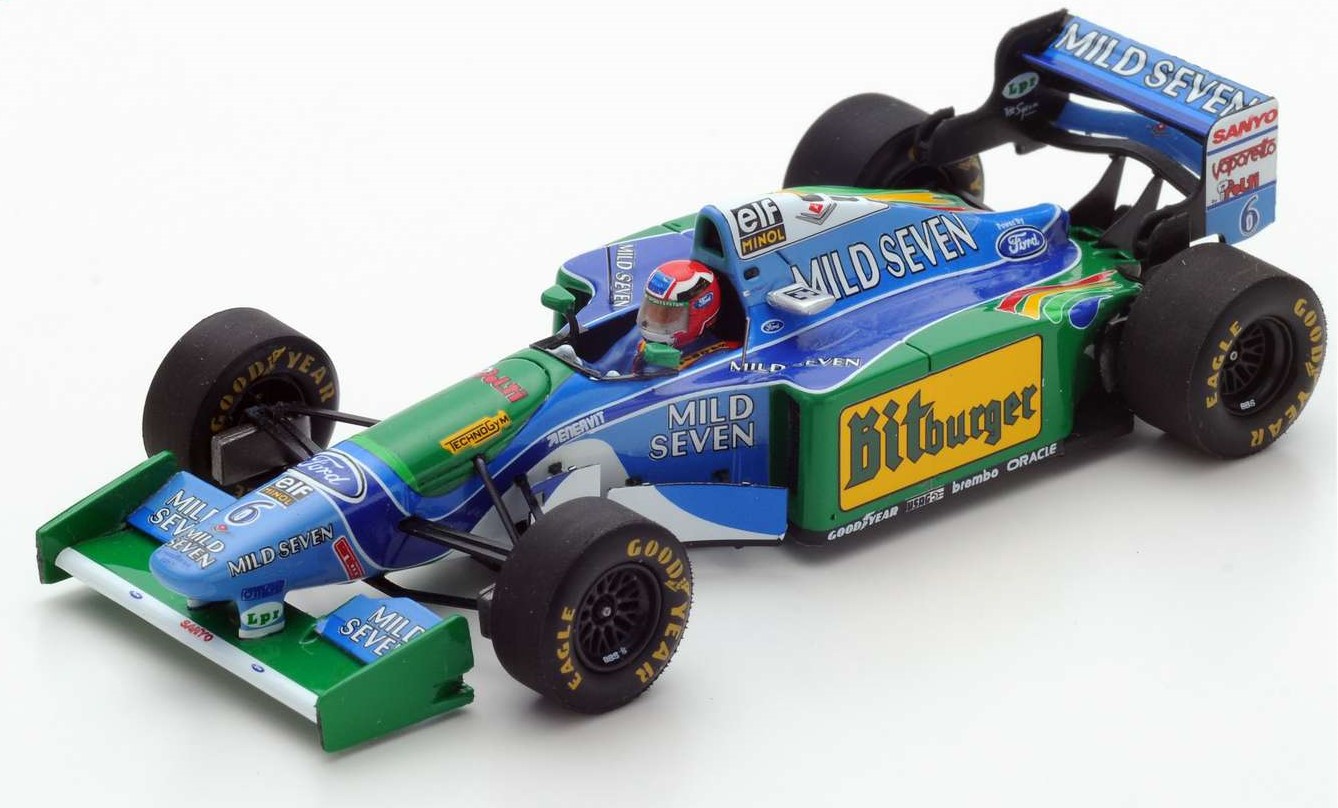 Spark: Benetton Ford B194 J.Herbert
Spark: Benetton Ford B194 J.Herbert
Ferrari (1997 - 2006)
At Ferrari, Schumacher was given a brief to hand-pick a team that would bring Maranello sustained championship success. Ross Brawn was recruited first and Byrne soon followed, unable to resist the call to the "red". The 1998 F300 car was Byrne's first full design and the following year the team secured the constructors' trophy with the F399 chassis. In 2000 Schumacher won the world championship, the first Ferrari driver to do so since Jody Scheckter in 1979. Then successive championships followed in 2001, 02, 03 and 04 for the Byrne-designed cars. The 2004 season was particularly impressive; 15 victories from 18 races, with a record 13 wins for Schumacher. Byrne's philosophy of evolution was never more evident at Ferrari where he and his team sought to systematically improve every area of the car, component by painstaking component. He set the benchmark for engineering detail, whether through the use of electronic differentials or periscopic exhaust outlets and all-titanium gearboxes. Byrne preferred the old school approach of using a drawing board rather than computer aided design. Following the success of 2004, Byrne started to step back from his role as chief designer, announcing he would retire at the end of 2006 and handing over to his assistant, Aldo Costa. However, Byrne was persuaded to stay on as a consultant until 2009. In 2012 Byrne was asked to help improve the troubled F2012 chassis and he was involved with the design of the 2014 and 2022 Ferrari cars. Rory Byrne still remains associated with the team in a consultancy capacity.
Having sought to reach the pinnacle of the sport, Rory Byrne has achieved it in empathic style. His cars have won 99 Grand Prix, seven constructors' titles and seven drivers' titles making him one of the all-time great designers in F1.
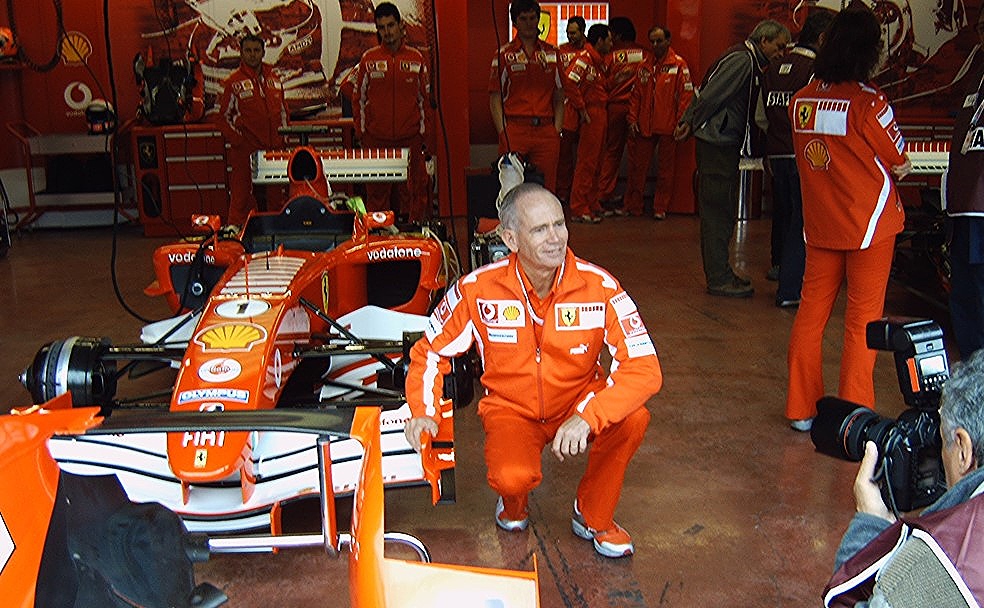 Rory Byrne with the F2005 (Photo: Mephisto83)
Rory Byrne with the F2005 (Photo: Mephisto83)
[Back to Top]
New Additions: June 2023
Welcome to the June update. Thanks to all those who dropped by my stand at the Collectorcon fair on 28 May, I hope you all enjoyed your visit. Another bumper release from Spark this month with a mixture of F1, Le Mans, Rally and American Racing series cars. With so many to choose from, it was difficult to pick which to highlight but here are my choices:
I've always loved the under-financed but enthusiastic backmarker teams of the '70's, 80's and '90's, the likes of which we will never see again. They added so much to the spectacle, the excitement and occasionally, the carnage of F1 racing and one such team was the Osella Squadra Corse from Italy. 1981 was the second year for the team and of the five drivers employed at various times during the season, Jean-Pierre Jarier was the most highly credentialled. He consistently qualified the car and finished four races but alas, scored no points. It was a similar story for the other drivers who invariably failed to qualify or failed to finish, and the team went pointless (some might say that's how the team should be remembered). To its credit, the team did struggle on until the end of 1990 season.
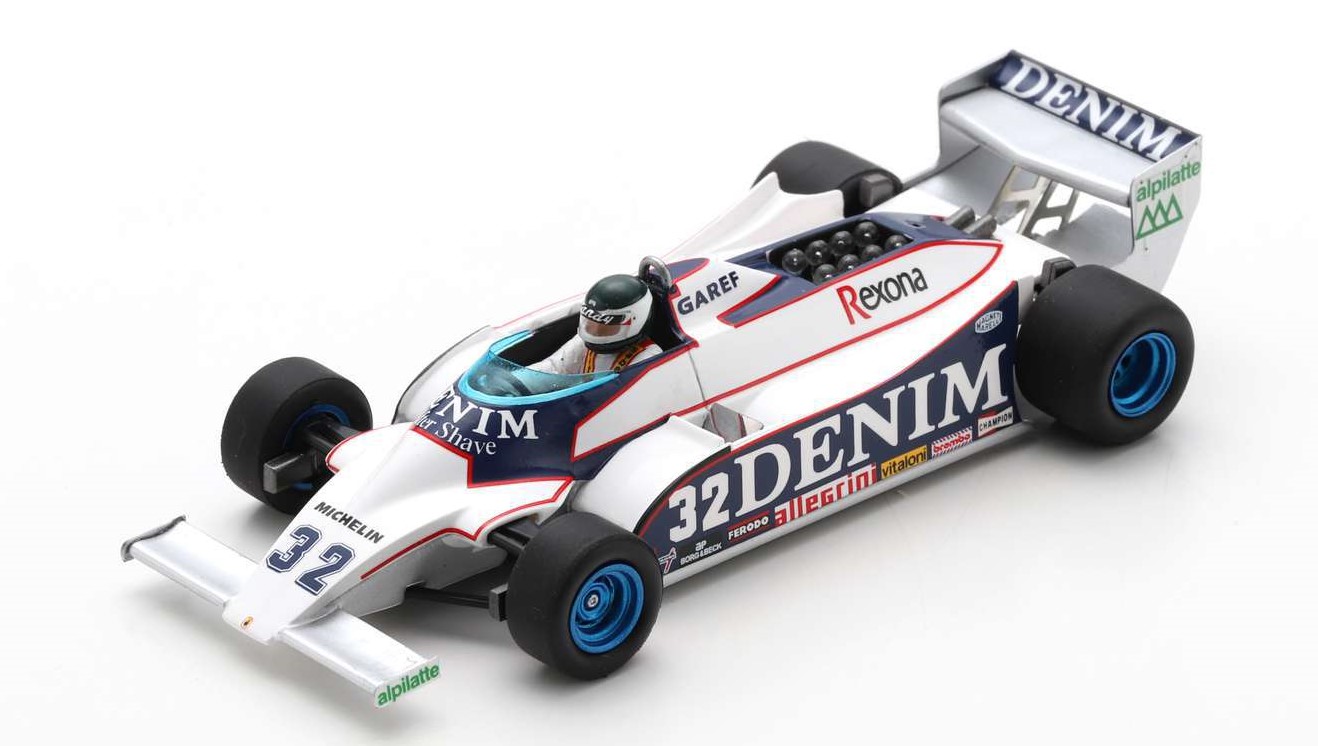 Spark: Osella Ford FA1B 1981 J-P Jarier
Spark: Osella Ford FA1B 1981 J-P Jarier
Automotive history is filled with concepts which never left the drawing board. In Jared A. Zichek's book, "Streamlined Dreams: Ten Amazing Unbuilt Automotive Designs, 1916-1939" he presents ten of the most beautiful and unusual aerodynamic studies of the inter war period. The first car featured in the book was the Clarke Racing Vehicle designed in 1916 by Harry D. Clarke from Nebraska, USA. Clarke was a tinkerer and inventor who filed several patents relating to this vehicle. It was designed as a racing car and the cylindrical bodywork was shaped for low drag for high speeds while using less fuel. Both the driver and riding mechanic sat very low in the enclosed cockpit ensuring the centre-of-gravity of the vehicle was kept low, a novel idea in 1916. This, however was an issue as the driver had no forward vision; to solve this Clarke added periscopes to both sides through which the driver could see forward. Bizarre, a sister company of Spark has produced this interesting car in 1:43.
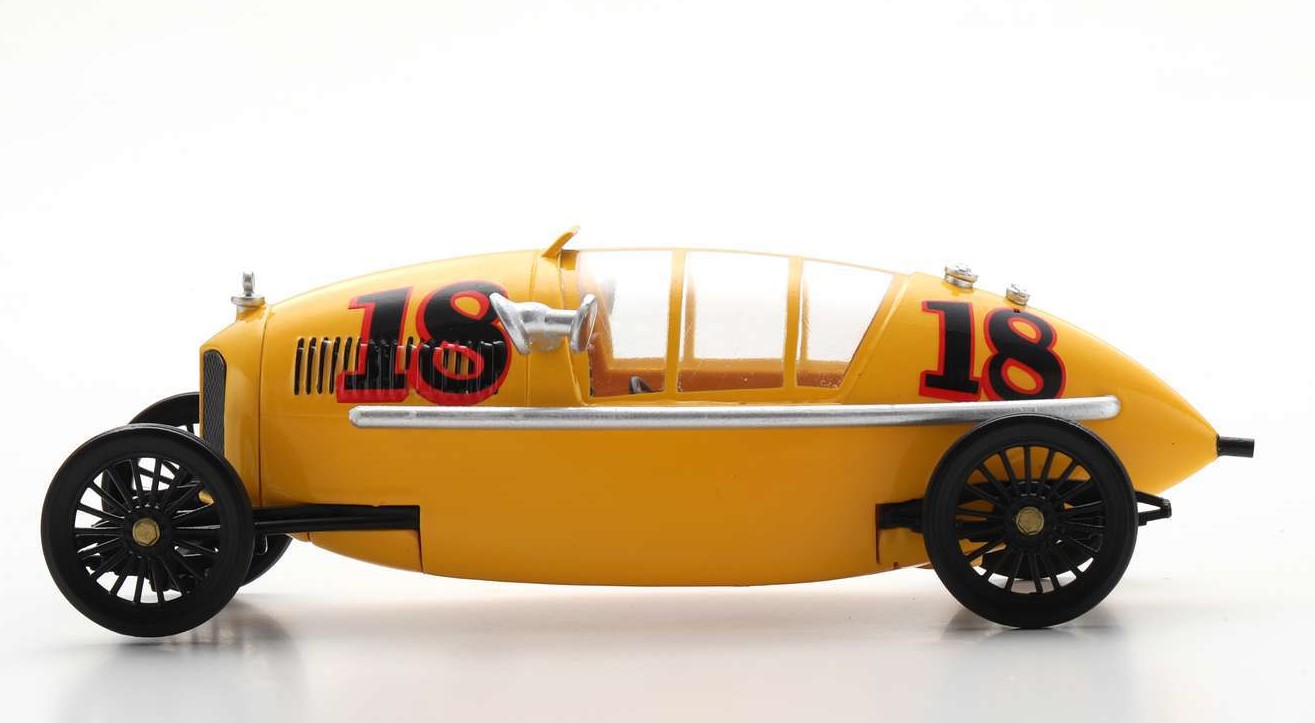 Bizarre: Clarke Racing Vehicle, 1916 concept car
Bizarre: Clarke Racing Vehicle, 1916 concept car
Datsun-badged cars are very rarely seen these days, consigned to perhaps a few historic car events. I still have fond memories of my first car in the early '80's, a Datsun 180B in mission brown with a faded white vinyl roof and brakes that failed the day after I bought it; sadly mother-nature reclaimed it and returned it to its natural ferrous oxide state. Sorry, I digress. It's good to see a Datsun being modelled by Spark, in this case, it's the Datsun Violet that won the Marlboro Rally Safari in 1982.
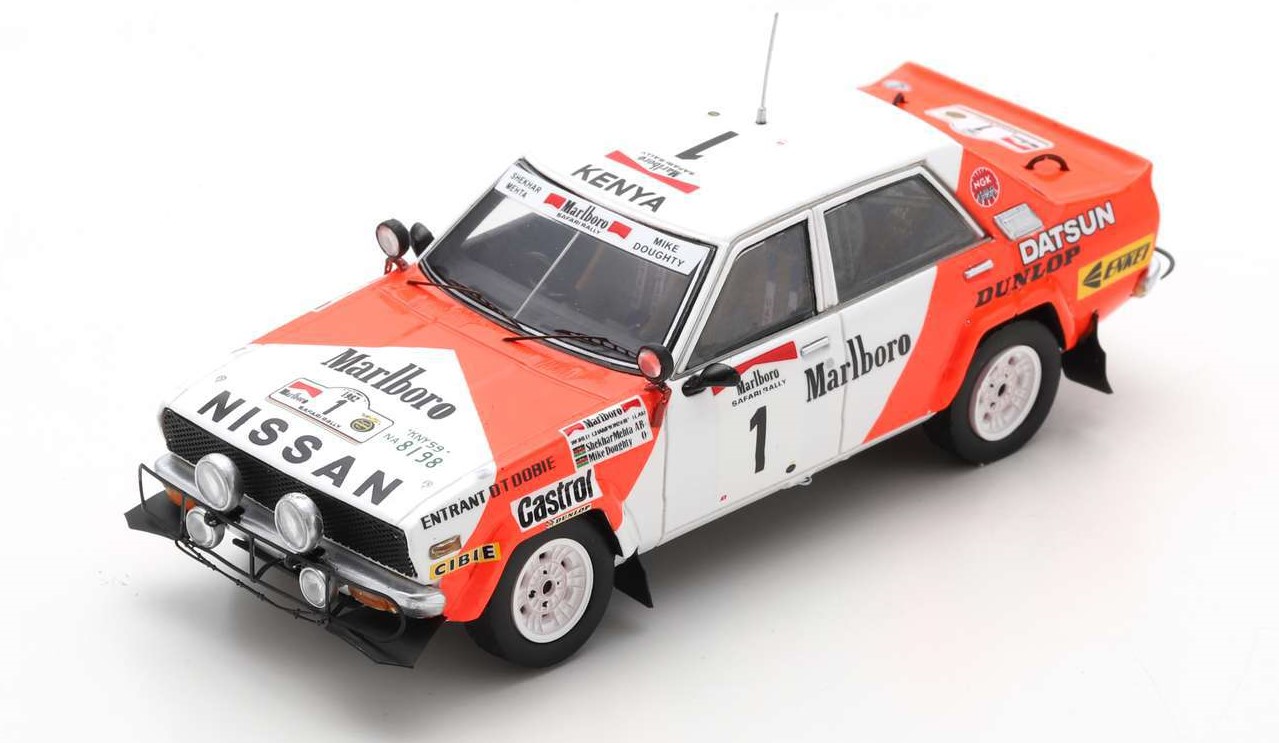 Spark: Datsun Violet, 1st 1982 Rally Safari
Spark: Datsun Violet, 1st 1982 Rally Safari
OK, that about wraps it up for another month. There is just the one event in June that I will be attending; the regular 1st Friday Sydney Toy and Hobby Fair at Epping on 2nd June. I have to announce that three events I usually attend will be held on the same weekend of 17 September; the All British Day, the Collectorcon Penrith and the Hawkesbury Model and Hobby Show. I have decided to attend the two-day Hawkesbury event. There are over 50 weekends in a year and three shows decide to hold their events on the same weekend!!! It gets worst ... on 20 August the Hunter Model Auto Club will be holding their annual fair on the same day as the Shannons Classic Day at Eastern Creek, so I will miss the Hunter event again this year. Just can't win. Until next month, happy collecting.
Formula one / Two / Three / Support Vehicles
- 1983 Arrows Ford A6, M.Surer (29) Monaco GP (Spark)
- 1983 Arrows Ford A6, C.Serra (30) San Marino GP (Spark)
- 1972 Brabham Cosworth BT38, T.Schenken (9) 1st Hockenheim F2 (Spark)
- 1972 Brabham Ford BT38, B.Wollek (4) 3rd GP d'Albi F2 (Spark)
- 1987 Brabham BMW BT56, R.Patrese (7) 3rd Mexican GP (Spark)
- 1991 Brabham Yamaha BT60Y, M.Brundle (7) San Marino GP (Spark)
- 1959 BRM P25, J.Bonnier (7) 1st Dutch GP [First win for BRM] (Spark)
- 1959 BRM P25, R.Flockhart (44) 6th French GP (Spark)
- 1959 Cooper Climax T51, J.Brabham (24) 1st Monaco GP (Spark)
- 1960 Cooper Climax T51, R.Salvadori (14) Monaco GP (Spark)
- 1961 Cooper Climax T55, B.McLaren (12) 3rd Italian GP (Spark)
- 1968 Cooper BRM T86B, J.Servoz-Gavin (32) French GP (Spark)
- 2020 Dallara Mecachrome G319, O.Piastri (1) Barcelona GP F3 Champion (IXO)
- 1991 Jordan Ford 191, R.Moreno (32) Italian GP (Spark)
- 1967 Lotus Ford 49, J.Clark (5) 1st Dutch GP (Spark)
- 1981 Osella Ford FA1B, J.P.Jarier (32) British GP (Spark)
- 1981 Osella Ford FA1B, B.Gabbiani (32) Belgian GP (Spark)
- 1972 Surtees Ford TS9B, T.Schenken (22) British GP (Spark)
- 1973 Surtees Ford TS9B, J.Hunt (56) 3rd Race of Champions (Spark)
- 1958 Citroen Type HY, Automobile Club de l'Ouest - Mobile Security (Spark)
- 1964 Citroen U23, Honda Racing Team race transporter (blue) (Spark)
- 1966 Ford Transit Mk1, Porsche Racing Service Van (IXO)
- 1954 Mercedes Transporter, "The Blue Wonder" w/ 300 SLR & Neubauer figure (Schuco)
Le Mans / Sport Car Racing
- 1953 Alfa Romeo 6C/3000 CM, Fangio/Marimon (22) Le Mans (Spark)
- 1953 Alfa Romeo 6C/3000 CM, Kling/Klenk (603) Mille Miglia (Spark)
- 1988 Argo Ford JM19C, Schanche/Smith/Donovan (117) Le Mans (Spark)
- 1966 ASA RB 613, Dini/Giunti (61) Le Mans (Spark)
- 1964 CD Panhard, Bertaut/Guilhaudin (44) Le Mans (Spark)
- 1976 Chevron Simca B36, Stadler/Dufréne/Flotard (26) Le Mans (Spark)
- 1976 Chevron Ford B36, Schafer/Albanesi/J-P.Adatte (33) Le Mans (Spark)
- 1916 Clarke Racing Vehicle featured in J.Zichek book "Streamlined Dreams" (Bizarre)
- 1992 Cougar Porsche C28S, Robert/Fabre/Brand (55) Le Mans (Spark)
- 1971 Ligier Ford JS3, Ligier/Depailler (24) Le Mans (Spark)
- 1960 Lotus Elite, Masson/Laurent (44) 13th Le Mans (Spark)
- 1955 Mercedes Benz 300SLR, S.Moss/D.Jenkins (722)1st Mille Miglia (Spark)
- 1976 Porsche 934 Turbo, Blaton/Faure/J.Goss (70) Le Mans (Spark)
American Racing Series
- 1975 Chevolet Camaro, B.Unser (7) 1st Michigan IROC (Spark)
- 1980 Chevrolet Corvette C3, Almeida/Rodriguez/Riano (02) Sebring 12H (Spark)
Rally Cars
- 1972 Citroen SM, Verrier/Martin (33) Tour de France Automobile (Spark)
- 1982 Datsun Violet GT, Mehta/Doughty (1) 1st Marlboro Rally Safari (Spark)
- 1960 Porsche 356B 1600S, Gacon/Gannot (157) Rally Monte Carlo (Spark)
- 1962 Porsche 356B T5 1600S, Dooijes/Slotemaker (209) Rally Monte Carlo (Spark)
Road Cars
- 1970 Dodge Challenger T/A in pink/black (PremiumX)
- 1986 Mercedes 560 SEC (C126) in white (Maxichamps)
- 2020 Nissan Skyline LB-Works LB-ER34 Super Silhouette in matt black (IXO)
- 1898 Renault Voiturette Type A in black/brown/yellow (Norev)
- 1986 Volvo 240 GL Break in metallic dark blue (Maxichamps)
Helmets (1:5)
- 1978 Mario Andretti - JPS Lotus helmet (Spark Editions)
- 2014 J.Button - McLaren Mercedes helmet (Spark Editions)
- 1973 F.Cevert - Elf Tyrrell helmet (Spark Editions)
- 2005 D.Coulthard - Red Bull helmet (Spark Editions)
- 1982 E.de Villota - LBT Team March helmet (Spark Editions)
- 2018 M.Ericsson - Alfa Romeo Sauber helmet (Spark Editions)
- 2019 P.Gasly - Toro Rosso Honda helmet (Spark Editions)
- 1951 J.Gonzalez - Scuderia Ferrari Helmet (Spark Editions)
- 2017 R.Grosjean - Haas helmet (Spark Editions)
- 1996 D.Hill - Williams Renault Helmet (Spark Editions)
- 2008 R.Kubica - BMW Sauber helmet (Spark Editions)
- 1977 R.Petersen - Elf Team helmet (Spark Editions)
- 1974 C.Regazzoni - Scuderia Ferrari helmet (Spark Editions)
- 1978 C.Reutemann - Scuderia Ferrari helmet (Spark Editions)
- 2012 M.Webber - Red Bull Helmet (Spark Editions)
- 2017 P.Wehrlein - Sauber helmet (Spark Editions)
After Thoughts: "A Centenary of Endurance" I'm guessing just about everyone is aware the Le Mans 24 Hour Race is celebrating its centenary year so I thought it might be an appropriate time to recount some interesting facts (in no particular order) of that very first race back in 1923.
- The race started at 4 pm Saturday but finished at 5 pm on Sunday. The weekend chosen for the race coincided with France moving to "summer time" so clocks were moved forward one hour at 11 pm.
- All cars had to be standard 4-seater production models, except those under 1100cc which could be 2-seaters where at least thirty cars had been built.
- A maximum of two drivers were allowed but were not allowed to ride together.
- Only the drivers could top up petrol, oil and water.
- All cars had to have standard touring equipment, such as running boards, headlights, a rear-view mirror and a horn.
- None of the entered cars had windscreen wipers.
- It rained for the first 4 hours of the race.
- The race did not have a winner in 1923 nor, for that matter in 1924 or 1925 because these were not individual races but rounds of the Rudge-Whitworth Triennial Cup.
- The Rudge-Whitworth Triennial Cup was intended to keep teams coming back to ensure the viability of hosting the world's first 24 hour race.
- The winners of the Cup was to be decided on the aggregate of three consecutive performances over and above predetermined targets; a convoluted method later shelved.
- The 1.1-litre Salmson driven by Desvaux and Casse took the lead for the Cup; it had completed 98 laps, 46 over its 52 lap target for its engine size.
- The Chenard & Walcker of Lagache and Léonard completed the most laps in 24 hours, 128.
- One lap of the 1923 circuit was 10.7 miles whereas today it is 8.5 miles.
- Of the 35 cars that started, 32 were French; the others were 2 Belgian Excelsiors and a single Bentley. Of the 70 drivers entered, 64 were French ... Vive la France!!
- The surface of the track was not sealed, it was a mix of gravel and tar.
- The race was an excellent exhibition of car endurance and reliability; 30 cars finished the race.
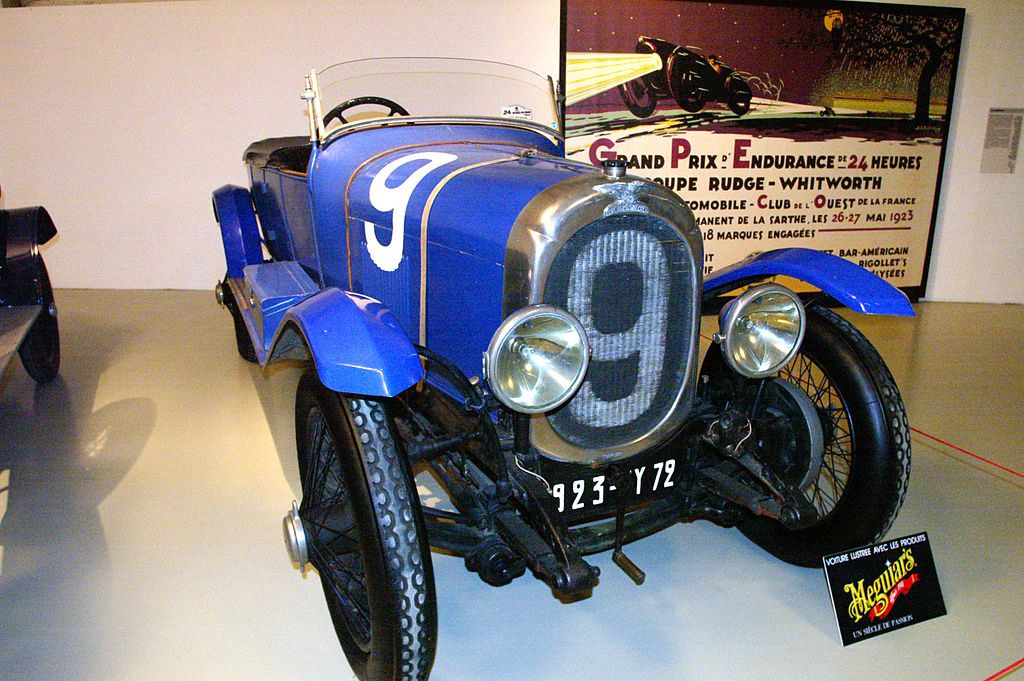 Chenard & Walcker #9 128 laps (Photo: D.Merrett)
Chenard & Walcker #9 128 laps (Photo: D.Merrett)
New Additions: May 2023
Welcome to another monthly update. I received a large shipment of Spark F1 models last month, ranging from the 1957 Vanwall to the 2021 Championship winning Red Bull RB16B. Probably the most interesting of the bunch are the Fittipaldi F8's from the 1980 season.
Harvey Postlethwaite's 1980 Fittipaldi F8 was finally ready in time for the British GP in July and was used until the end of the season. Fittipaldi Automotive had bought the assets of the Wolf team for 1980 and the Wolf cars were updated and renamed the Fittipaldi F7. This allowed Postlethwaite time to design the F8 which was an evolution of the Wolf design and followed the shape of the current Williams, Brabham and Arrows cars. The F8 was a huge improvement on the F7 and Keke Rosberg had a storming drive from last place to finish fifth at the Italian GP.
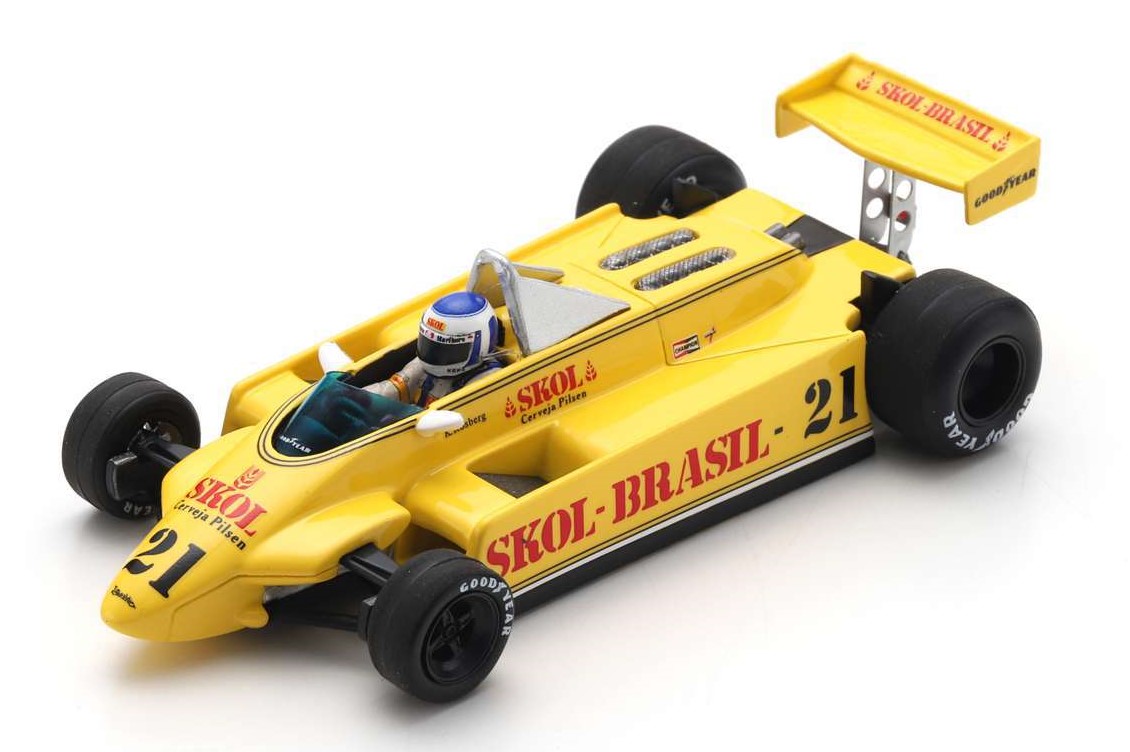 Spark: Fittipaldi Ford F8 1980 K.Rosberg Italian GP
Spark: Fittipaldi Ford F8 1980 K.Rosberg Italian GP
For those who collect Australian F1 drivers, the BRM P201B driven by Larry Perkins in 1977 may be of interest. The once illustrious BRM team was by 1977, in its death throes when Larry Perkins joined the one-car team. In his second race for BRM at South Africa, Perkins ran at the back of the field all race to finish 15th and lapped 5 times. "It's slow in a straight line, slow under braking, slow out of the corners" was Perkins frank assessment of the BRM. He quit the shambolic team mid-season and soon after, BRM disappeared from Grand Prix racing forever.
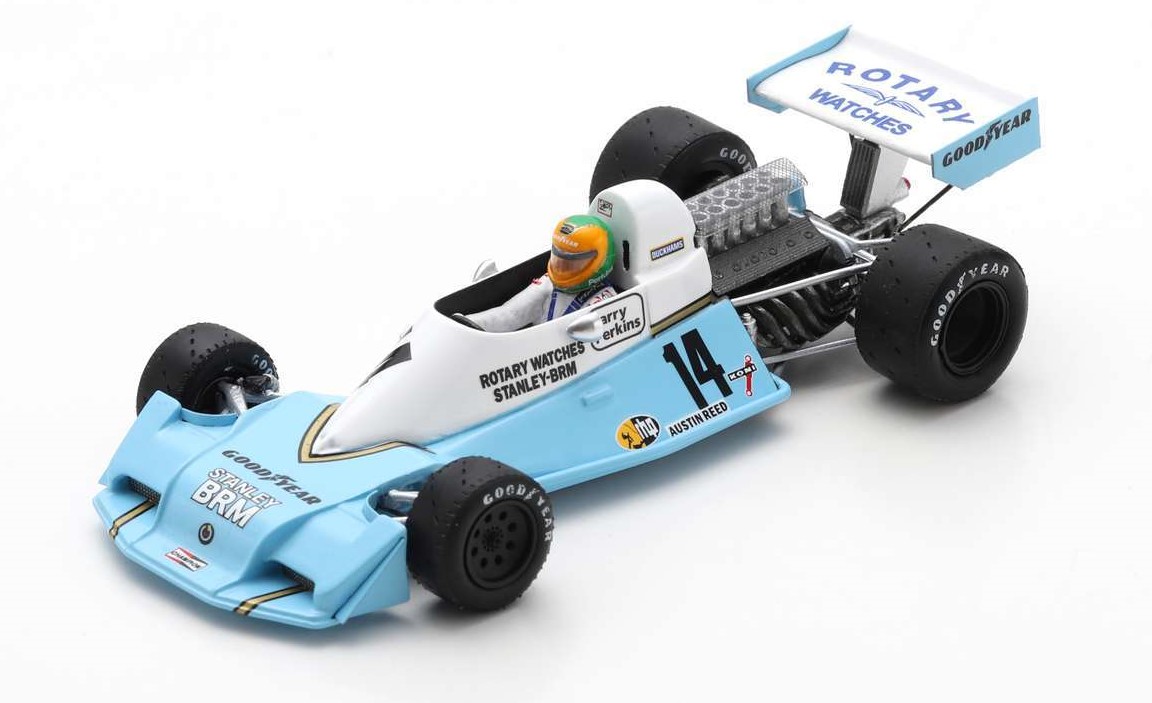 Spark BRM P201B 1977 L.Perkins South Africa GP
Spark BRM P201B 1977 L.Perkins South Africa GP
OK, that wraps it up for another month. After a barren April, we are spoilt with two model fairs in May. Firstly, the regular 1st Friday Sydney Toy and Hobby Fair at Epping on 5 May and then the Collector Con (Penrith) on 28 May. Also, the date for the Hawkesbury Model and Hobby Show has been confirmed as 16 - 17 September and the Shannon's Sydney Classic at Eastern Creek is on 20 August. For more information on these shows, please see the Swap Meets link. Until next month, happy collecting.
Formula One / Two / Transporter
- 2021 Aston Martin Mercedes AMR21, L.Stroll (18) Abu Dhabi GP 100th Race (Spark)
- 1966 Brabham Climax BT22, J.Bonnier (30) French GP (Anglo-Suisse Racing) (Spark)
- 1968 BRM P126, P.Courage (36) 6th French GP (Spark)
- 1969 BRM P133, J.Oliver (12) Spanish GP (Spark)
- 1977 BRM P201B, L.Perkins (14) South African GP (Spark)
- 1980 Fittipaldi Ford F8, E.Fittipaldi (20) British GP (Spark)
- 1980 Fittipaldi Ford F8, K.Rosberg (21) 5th Italian GP (Spark)
- 1981 Fittipaldi Ford F8C, K.Rosberg (20) Belgian GP (Spark)
- 1973 Iso-Marlboro Ford IR, J.Ickx (26) 7th US GP (Spark)
- 1991 Jordan Ford 191, B.Gachot (32) 5th Canadian GP (Spark)
- 1995 Ligier Mugen JS41, O.Panis (26) 6th Spanish GP (Spark)
- 1996 Ligier Mugen JS43, P.Diniz (10) 6th Spanish GP (Spark)
- 1973 Lotus Ford BDA 74, R.Petersen (2) GP de GB F2 Nivelles "Texaco Star" (Spark)
- 1984 Lotus Renault 95T, E.de Angelis (11) 2nd East US GP (Spark)
- 1972 McLaren Ford M19A, J.Scheckter (21) 'Yardley' USA GP (Spark)
- 2021 McLaren Mercedes MCL35M, Ricciardo/Norris 1st/2nd Italian GP w/pit board (Spark)
- 2021 McLaren Mercedes MCL35M, D.Ricciardo (3) Abu Dhabi GP (Spark)
- 2001 Minardi European PS01, F.Alonso (21) Australian GP (Spark)
- 1967 Protos Cosworth 16, K.Ahrens (26) German GP F2 (Spark)
- 2021 Red Bull Honda RB16B, M.Verstappen (33) 1st Abu Dhabi GP w/no.1 board (Spark)
- 1984 Spirit Hart 101, M.Baldi (21) Brazilian GP (Spark)
- 1982 Tyrrell Ford 011, B.Henton (4) Italian GP (Spark)
- 1957 Vanwall VW5, S.Moss (26) 1st Pescara GP, Italy (Spark)
- 1957 Vanwall VW5, R.Salvadori (20) French GP (Spark)
- 1992 Venturi Lamborghini LC92, U.Katayama (30) South African GP (Spark)
- 1987 Williams Honda FW11B, N.Piquet (6) 1st Hungary GP (Spark)
- 1955 Mercedes L3500 blue truck with flat board; Merc Racing Dept., (Premium Classixx)
Le Mans / Sports Cars
- 1952 Mercedes 300SL, Lang/Riess (21) Winner Le Mans (IXO)
- 1970 Porsche 917K, Siffert/Redman (24) 1000 km Spa (Brumm)
- 1970 Porsche 917K, Siffert/Redman (20) Le Mans "Gulf" (Brumm)
- 1970 Porsche 917K, Rodriguez/Kinnunen (25) 1000 Km Spa (Brumm)
- 1970 Porsche 917K, Siffert/Redman (1) 2nd Daytona 24 hrs (Spark)
- 1970 Porsche 917K, Piper/Redman (28) 1000km Buenos Aires (Spark)
- 1970 Porsche 917L, Larousse/Kauhsen (3) 2nd Le Mans (CMR)
- 1971 Porsche 917K, Rodriguez/Oliver (2) 1st Daytona 24h (CMR)
Helmets
- 2021 F.Alonso - Alpine Helmet 1:5 (Spark)
- 2022 V.Bottas - Alfa Romeo Helmet (Spark)
- 2022 P.Gasly - Alpha Tauri Helmet 1:5 (Spark)
- 2021 L.Norris - British GP McLaren Helmet (Spark)
- 2021 L.Norris - Monaco GP McLaren Helmet (Spark)
- 2022 L.Norris - McLaren Helmet (Spark)
- 2021 K.Rakkonen - Alfa Romeo helmet (Spark)
- 2021 D.Ricciardo - Monaco GP McLaren Helmet (Spark)
- 2022 Y.Tsunoda - Alpha Tauri Helmet (Spark)
Road Cars
- 1955 Mercedes Benz 300 SLR, Uhlenhaut coupe (W196S) in silver (IXO)
After Thoughts: "The Race to Death" Henry Ford was believed to have said, "Auto racing began 5 minutes after the second car was built."
When the motor vehicle came into existence, it was natural that it be tested for speed on the open road, from point to point thus proving its reliability and performance. The first competitive car race in the world was in 1894 and was run from Paris-Rouen, followed by the Paris-Bordeaux-Paris and other inter-city races. While these inter-city races were popular at the dawn of motorsport, the disastrous Paris-Madrid race in 1903 almost put an end to automobile racing in general.
The Paris-Madrid race of 1903 was organised by the Automobile Club de France and the Autómovil Club Español, but the French government was against the idea of races being held on public roads. However, King Alphonse XIII of Spain was strongly in favour and the French government relented under pressure from the media and French car manufacturers who wanted to promote their brands. The route for the race was divided into three legs. The first, from Paris to Bordeaux was 552 kilometres; the second from Bordeaux to Vitoria (Spain) was 335 km. The last leg, from Vitoria to Madrid was 420 km.
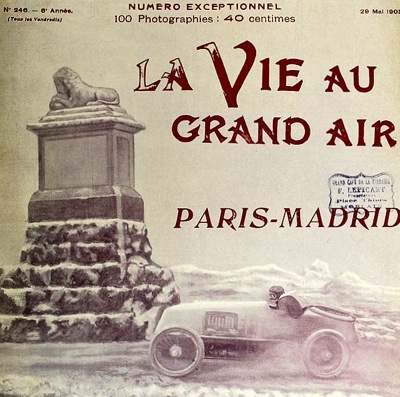 Race program for the 1903 Paris-Madrid Race
Race program for the 1903 Paris-Madrid Race
The actual start of the race was from Versailles on May 24, as racing on the Parisian streets was not allowed. There were 314 entries and 219 of them showed up at the start. The rules called for four weight categories; ranging from less than 250 kg (motorcycles) up to a maximum of 1000 kg. The cars started the race at 3:45 am, one by one with a one-minute delay. First to start was a 4-hp De Dietrich, followed by a 70-hp Panhard, third was Louis Renault in a 30-hp voiturette. The differences in speed between the classes and competitors was huge. The first leg, from Paris to Bordeaux was mainly on very straight roads and were well known to many of the drivers. On race day the weather was fine but it had not rained for a long time so the roads were extremely dusty. Spectators clamoured on the roads to see the cars and only stepped back at the last moment when the cars emerged from the dust clouds. They were not used to the high speeds; it was a recipe for disaster.
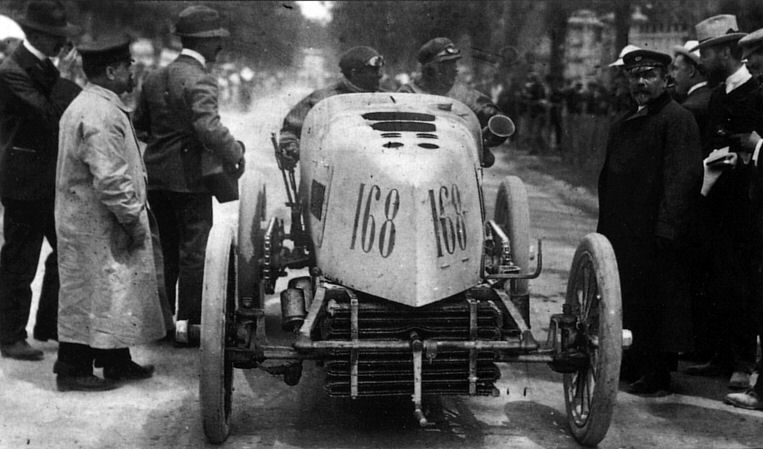 Winner 1903 Paris-Madrid, F.Gabriel's 90-hp Mors
Winner 1903 Paris-Madrid, F.Gabriel's 90-hp Mors
Shortly after the start, Louis Renault took the lead averaging 120 km/h. Some competitors reached top speeds of around 140 km/h on the long straights which was way above the official world record for automobiles at that time(1). Ultimately, of the 219 starters only 114 arrived at Bordeaux. Of those who failed to reach Bordeaux, 17 were involved in accidents, many cars crashing into walls and trees at high speed. In the race, six racers died immediately and two more some days later. The most prominent was Marcel Renault (co-founder of Renault with his brother Louis) who because of dust thrown up by another competitor, didn't see a left-hand corner and missed the street at a speed of 130 km/h. He and his mechanic were thrown out of the Renault and Marcel hit a tree. He died two days later; his mechanic survived. In some other accidents, the drivers and mechanics survived, but spectators lost their lives. It was believed three spectators died.
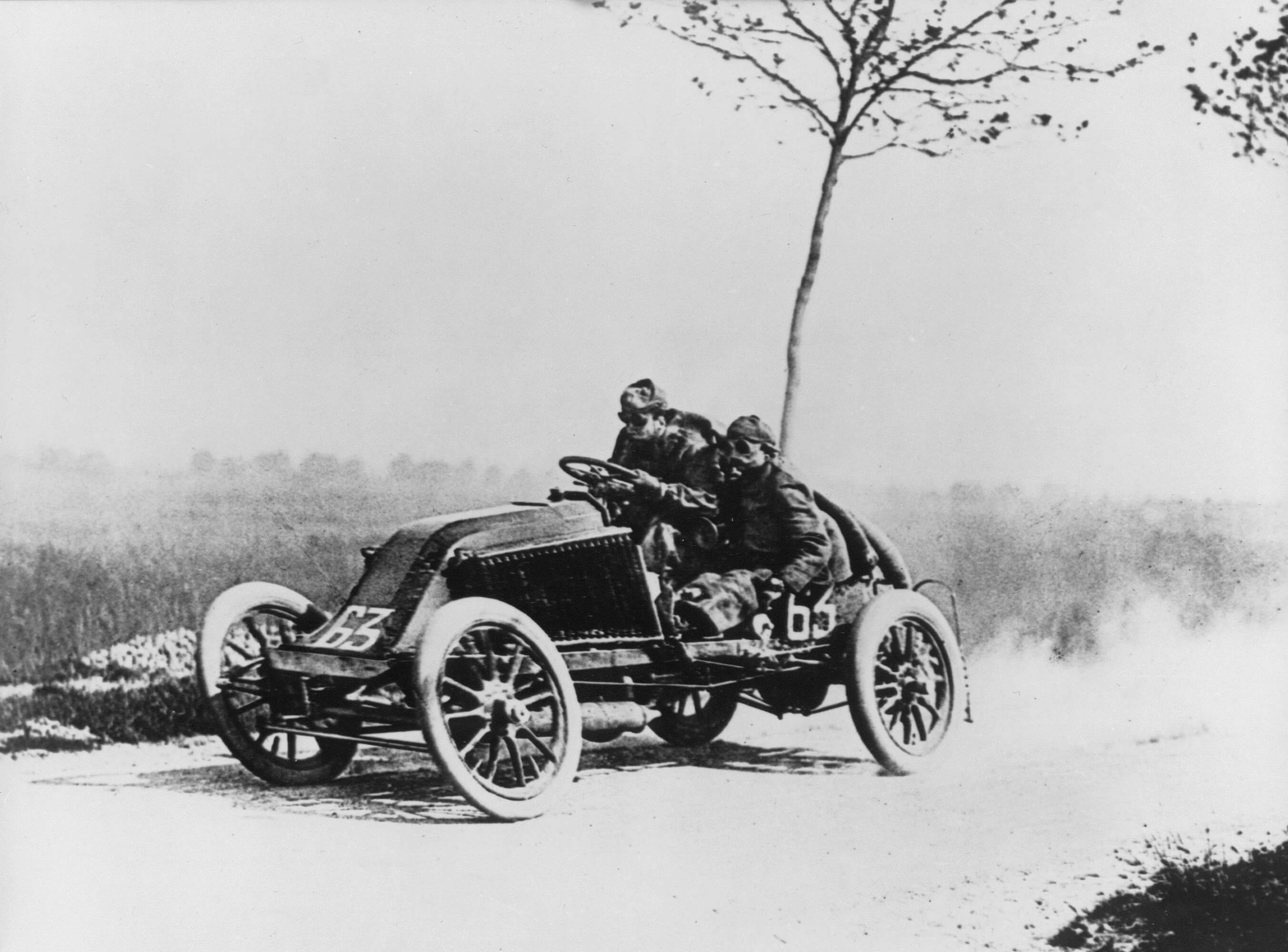 Marcel Renault in the 1903 Paris-Madrid Race
Marcel Renault in the 1903 Paris-Madrid Race
The French Parliament reacted strongly to the news of the death toll and forced the cancellation of the event. The cars were impounded and towed to the Bordeaux rail station by horses and transported back to Paris by train. Fernand Gabriel in a Mors was declared winner of the shortened race. The furore caused many newspapers and experts to declare that auto racing was finished, at least on public roads. The Paris-Madrid was the last of the great town-to-town races run on public roads not only in France but in Europe as well; one day of racing had set motorsports back nearly three decades(2). The effects of the race also extended to motoring regulations, with proposals for limiting cars to a maximum speed of 40 km/h in France. Post-race analysis pointed to a number of causes for the high fatality:
- Speed which saw cars reaching over 140 km/h on rudimentary public roads.
- Dust which caused visibilty problems. The one minute starting interval did not allow time for dust to settle for the following driver.
- Random starting order saw faster cars mixed with slower and smaller cars causing many unneeded, high risk overtakings.
- Poor crowd control and a general underestimation of the dangers of car racing.
Until 1903, motorsport had not claimed many casualties but after the Paris-Madrid Race, the world came to realise motorsport was, in reality, a very deadly activity that had no place on open public roads.
Note (1): The speed record was 124.13 km/h set on 17 November 1902.
Note (2): There would not be another race on public highways until the 1927 Mille Miglia. The Peking to Paris race of 1907 and the New York to Paris race of 1908 were more reliability trials than all-out races.
New Additions: April 2023
Welcome to my April update. Firstly, thanks to all those who dropped by my stand at the Collector Con show at Penrith last month. I hoped you enjoyed your visit. Last month I received several shipments of Spark models that I'd pre-ordered over a period of time; Spark are really pumping out their models at the moment and I'm not sure that's a good thing. Everyone, everywhere is experiencing high inflation and high interest rates and buying model cars is one luxury that can easily be sacrificed. Maybe buying one or two occasionally would be OK but when one company is releasing so many in a short space of time, it could lead to collecting fatigue. When faced with so many new models but not being able buy any, some might simply give up collecting all together. OK, enough of my ranting, so what are the highlights this month ...
Despite winning Le Mans for the first time in 1966, Ford realized the GT40 Mk II was already reaching the end of its competitive life. It was heavy and the aerodynamics were not optimal so Ford decided to return to Le Mans with an all-new car incorporating the latest technology. As the new car was designed to comply with the Appendix J of the FIA's regulation, it was known as the J-Car. The J-Car shared almost nothing with the GT40 beyond a 427 engine. It lost 300 lbs, its chassis and body were built using aircraft technology. The first prototype (J-1) was finished in January 1966 but required extensive modifications, mostly areodynamic after testing at Le Mans in April. Two other prototypes were built the same year (J-2 and J-3) and sadly Ken Miles died while testing J-2 in August at Riverside. Chassis J-4 was further modified by Ford and Shelby America with a new body, incorporating a longer front end, a Can Am style tail section and a new roof line with a rear window. During this transformation the J-Cars officially became known as the Ford GT40 Mk IV.
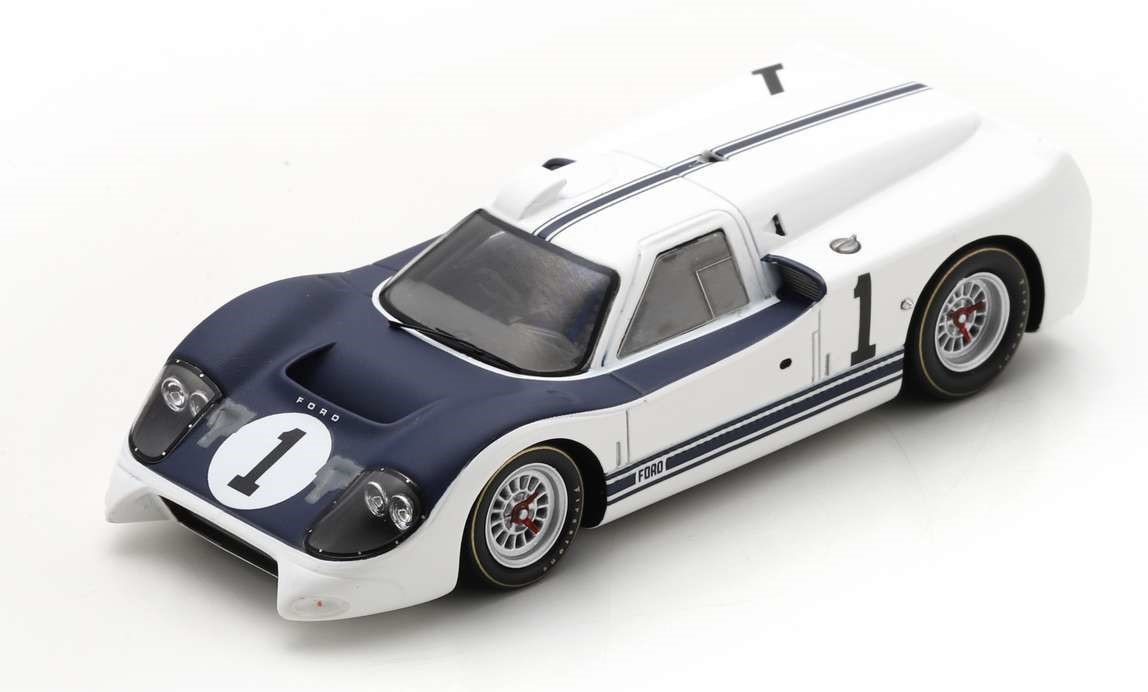 Spark: Ford J-Car Le Mans Test 1966
Spark: Ford J-Car Le Mans Test 1966
Spirit Racing entered Formula One in 1983 using a revised F2 chassis and Honda's new turbocharged engine. The following year, Spirit had a new purpose-built F1 chassis but unfortunately, Honda decided to supply its engines exclusively to Williams, citing a lack of progress by the Spirit team. Spirit decided to continue in 1984 with Hart turbocharged engines. Initially twice world champion Emerson Fittipaldi was to drive one of the cars however, after testing the car at the Brazilian GP he decided to leave to race Indy Cars after finding the Spirit uncompetitive.
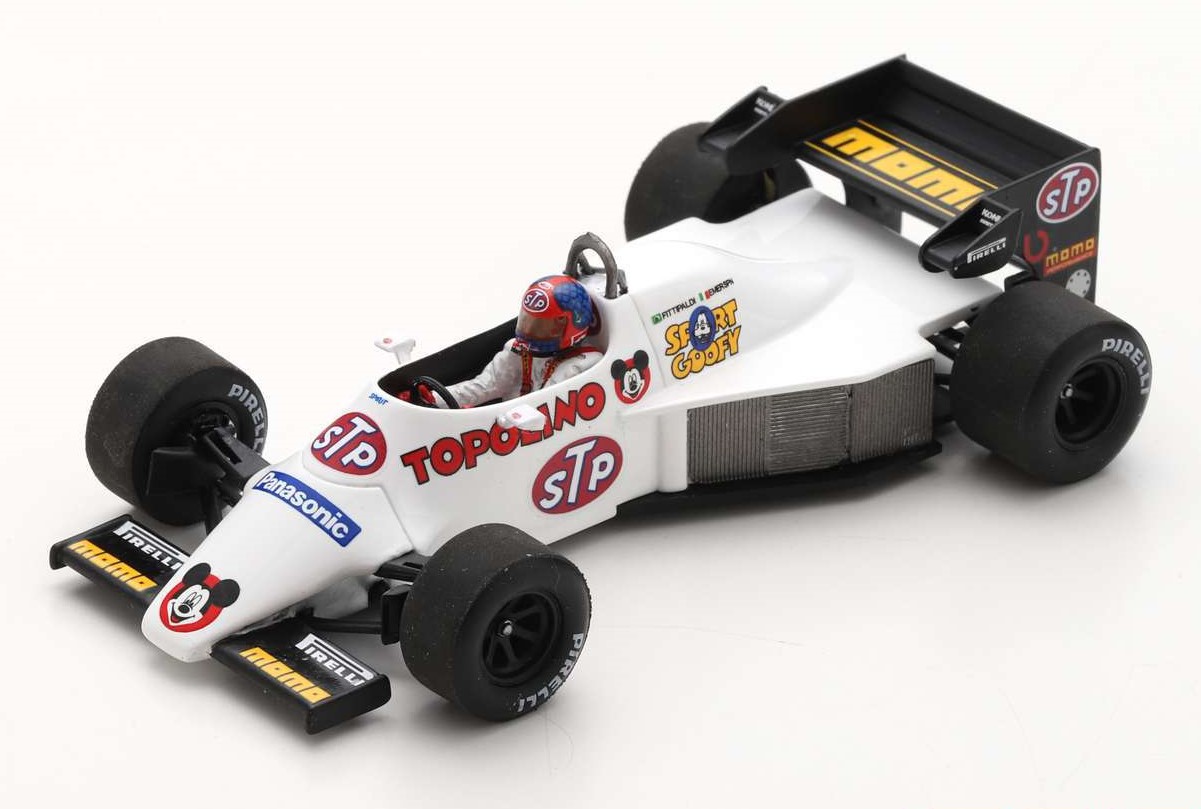 Spark: Spirit Hart 101 Brazil Test 1984
Spark: Spirit Hart 101 Brazil Test 1984
After doing some research on the 1:5 helmets produced by "Spark Editions", I found these helmets were produced as a "partworks" series, namely as an attachment to a magazine. The only photo I've seen of the magazine has the Spanish title "Cascos Grandes Premios los mejores pilotos de Formula 1" or "Grand Prix Helmets of the best Formula 1 drivers". I believe these helmets were only released in Mexico, Argentina, Spain and Italy, however, I do have a few for those who are interested in helmets from an earlier era.
The organisers of the monthly Sydney Toy and Hobby Fair have cancelled the April event as it falls on the Good Friday public holiday. So, there are no events until early May, until then, happy collecting.
Formula One / Two
- 1968 Brabham Ford BT23C, P.Courage (2) 1st Buenos Aires F2 (Spark)
- 1982 Brabham BMW BT50, N.Piquet (1) 1st Canadian GP (Spark)
- 1968 BRM P133, P.Rodriguez (20) French GP (Spark)
- 1973 Iso-Marlboro Ford IR, T.Schenken (26) Canadian GP (Spark)
- 1991 Jordan Ford 191, A.de Cesaris (33) 4th Canadian GP (Spark)
- 1996 Ligier Mugen JS43, O.Panis (9) 1st Monaco GP (Spark)
- 1984 Lotus Renault 95T, N.Mansell (12) 3rd Dutch GP (Spark)
- 1981 March Ford 811, D.Daly (17) Long Beach GP DNQ (Spark)
- 2021 Mercedes AMG W12, L.Hamilton (44) 1st Brazilian GP holding flag (Spark)
- 1967 Protos Cosworth 16, P.Rodriguez (1) Hockenheim F2 (Spark)
- 2021 Red Bull Honda RB16B, M.Verstappen (33) 1st Abu Dhabi w/pitboard (Minichamps)
- 1984 Spirit Hart 101, E.Fittipaldi Test Session Brazil (Spark)
- 1982 Tyrrell Ford 011, M.Alboreto (3) 4th German GP (Spark)
- 1956 Vanwall VW2, M.Hawthorn (24) French GP (Spark)
- 1987 Williams Honda FW11B, R.Patrese (5) Australian GP (Spark)
Le Mans / Sports Cars
- 1935 Alfa Romeo 8C, Sommer/d'Estrez (15) Le Mans (Spark)
- 1965 Ford GT40, Bondurant/Maglioli (7) Le Mans 'Rob Walker Racing' (Spark)
- 1965 Ford GT40, Bucknum/Muller (6) Le Mans "Scuderia Filipinetti" (Spark)
- 1966 Ford J-Car, B.McLaren (1) April Le Mans Test (Spark)
- 1967 Ford GT40 MkIV, McLaren/Donohue (1) Le Mans Test Day (Spark)
- 1967 Ford GT40 MkIV, Bianchi/Andretti (3) Le Mans 'Holman & Moody' (Spark)
- 1960 Porsche 718 RS60, Bonnier/Herrmann (184) 1st Targa Florio (Spark)
- 2021 Toyota GR010 Hypercar, Hartley/Buemi/Nakajima (8) 2nd Le Mans (Spark)
Misc. Scale
- 1970 Porsche 917K, Rodriguez/Kinnunen (21) le Mans 1:64 (Spark)
Helmets 1:5
- 1992 M.Alboreto - Footwork Helmet (Spark Editions)
- 1972 C.Amon - Equipe Matra Sports Helmet (Spark Editions)
- 1981 R.Arnoux - Equipe Renault Elf Helmet (Spark Editions)
- 1980 E. de Angelis - Essex Lotus Helmet (Spark Editions)
- 1979 P.Depailler - Ligier Gitanes Helmet (Spark Editions)
- 1998 M. Häkkinen - McLaren Helmet (Spark Editions)
- 1972 D.Hulme - Yardley Team McLaren Helmet (Spark Editions)
- 1979 J.Ickx - Ligier F1 Helmet (Spark Editions)
- 1980 A.Jones - Williams F1 Champion Helmet (Spark Editions)
- 1982 J.Laffite - Equipe Talbot Gitanes Helmet (Spark Editions)
- 1979 J.Mass - Warsteiner Arrows Helmet (Spark Editions)
- 1975 C.Pace - Martini Racing Helmet (Spark Editions)
- 1981 R.Patrese - Arrows Beta Racing Helmet (Spark Editions)
- 1972 H.Pescarolo - Team Williams Motul Helmet (Spark Editions)
- 1981 A.Prost - Renault Elf Helmet (Spark Editions)
- 1973 P.Revson - Yardley Team McLaren Helmet (Spark Editions)
- 2019 D.Ricciardo - Renault Helmet 1:5 (Spark Editions)
- 2020 D.Ricciardo - Renault DP World Helmet (Spark Editions)
- 1979 J.Watson - McLaren Helmet (Spark Editions)
After Thoughts: "The Forgotten F1 Circuits Series #4 - Mosport Park, Canada" The Canadian Grand Prix seems to be historically linked to the Circuit Gilles Villeneuve(1) on the Notre Dame Island in Montreal. The Canadian GP has been held in Montreal since 1978, but prior to this it was held eight times(2) between 1967 to 1977 at Mosport Park which is located 64 kilometres from Toronto. The name Mosport is a contraction of Motor Sport and was Canada's first permanent motor racing facility.
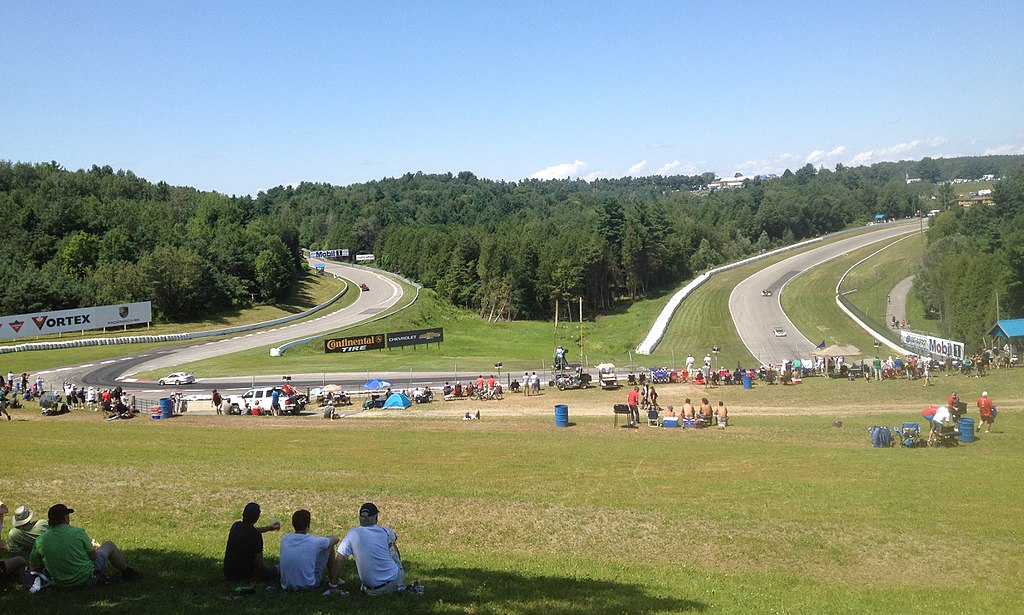 Moss Corner (Photo: TorontoGuy79)
Moss Corner (Photo: TorontoGuy79)
Plans for the circuit were first developed in 1958 by the British Empire Motor Club who had purchased a 450-acre parcel of land near the town of Bowmanville, Ontario. By 1960, a swooping track design making the most of the contours of the land had been drawn up and that same year, Stirling Moss while on a trip to Toronto was shown the circuit plans. Moss made many suggestions and the resulting Turn 5 was called Moss Corner in his honour. The circuit was finally completed in May 1961 but it had cost double the original $250,000 estimate. A clubman race christened the new 3.96 km course and the first major event, the Player's 200 for sports cars was held in late June which was won by Stirling Moss driving a 2.5 litre Coventry Climax powered Lotus 19. Stock cars and Can-Am were the mainstay events in the early years but by 1966 the costs of construction finally caught with the company operating the circuit and the company was put into liquidation. Luckily, a new owner was found and top level racing came soon afterwards when the circuit hosted the first Canadian F1 Grand Prix in 1967(3).
 Mosport Park Circuit 1967 (photo: W.Pittenger)
Mosport Park Circuit 1967 (photo: W.Pittenger)
A crowd of 58,000 witnessed Jack Brabham and Denny Hulme complete a one-two for the Brabham-Repco team in the inaugural event. Other winners of the Canadian GP at Mosport were Jacky Ickx (Brabham), Jackie Stewart (Tyrrell), Peter Revson (McLaren), Emerson Fittipaldi (McLaren), James Hunt (McLaren) and Jody Scheckter (Wolf). The most controversial race was in 1973 which was held in exceptionally bad weather and near the halfway point of the race, François Cevert and Jody Scheckter were involved in a collision. This led to the first deployment of a safety car in Formula One history. Unfortunately, the safety car picked up the wrong leading car and with cars diving into the pits, confusion ensued as to who was actually leading when the race resumed. Colin Chapman thought Fittipaldi's Lotus crossed first, Howden Ganley's lap keeper insisted Ganley was the winner; eventually Peter Revson was declared the victor.
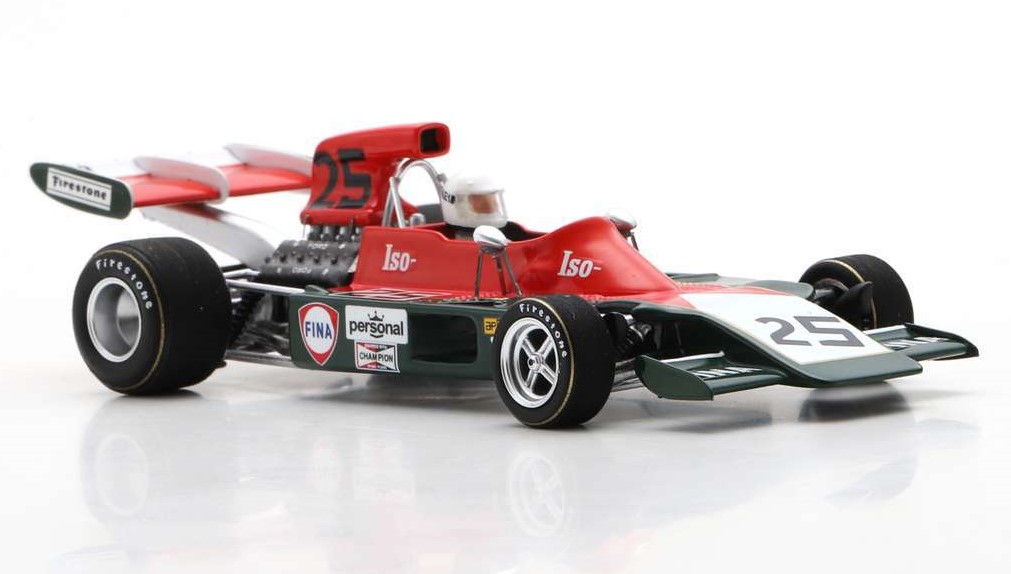 Spark: Ganley's Iso-Marlboro 6th Mosport '73 (or 1st?)
Spark: Ganley's Iso-Marlboro 6th Mosport '73 (or 1st?)
Safety at the circuit came under question after a number of large accidents and by the mid-70's the circuit had become increasingly unsuitable for modern F1 cars. The track's fast, sweeping turns and huge elevation changes combined to make every corner a blind one and with runoff areas basically non-existent, any mistake usually ended in a wall. When Jochen Mass' McLaren hit the wall at Turn 1 during practice for the 1977 GP, the wall simply flattened upon impact. During the same event Ian Ashley's Hesketh flew clear over a wall and crashed into a TV camera tower. Ashley survived but it ended his driving career and it was also the end for the circuit.
The last Canadian GP held at Mosport was in 1977. It was a very special Grand Prix in Canadian motorsport history as Gilles Villeneuve made his debut for Ferrari, in his second ever F1 start, after a one-race deal for McLaren at the 1977 British GP. After losing the hosting rights to the GP, the Mosport circuit continued to host other motor sport events and today it is best known as a sportscar venue. For a time it was owned by Don Panoz and under his ownership a series of improvements began most notably enlargement of some runoff areas. The current owners continued the program of extensive renovations and a new sponsorship deal saw the circuit officially renamed as the Canadian Tire Motorsport Park.
Note (1): The original circuit name was Circuit ÎIe Notre-Dame and was changed to its current name in 1982 to honour hometown hero Gilles Villeneuve who died on 8 May 1982.
Note (2): During this period the Canadian GP was twice held at the Mont-Tremblant circuit (1968 and 1970) and the GP was not held in 1975 due to a small row between Formula One Constructors' Association and Mosport Park about ... payments.
Note (3): Mosport Park hosted the "Canadian GP" from 1961 to 1966 but the events were not part of the F1 World Championships.
New Additions: March 2023
Welcome to the March update; wow, the year is really flying by. March is probably my favourite month of the year, it means the start of the new F1 season with the first race on the 5th at Bahrain. The Australian Supercars series also kicks off with the new Gen3 cars appearing at the Newcastle 500 on the 12th March. Then we have the World Endurance Championship starting with the Sebring 1000 miles on the 17th and the Indy Cars also starting on 5th with the GP of St. Petersburg. And I mustn't forget the MotoGP series with the first race in Portugal on the 27th. What a month for motorsport fans.
OK, last month I didn't have any new additions to announce but this has changed for March. I did receive some models, mainly models that I had pre-ordered with my suppliers so I was obliged to honour my committments. Although, to be honest I was suffering a bit from withdrawal symptoms anyway.
Spark are getting into model helmets in a big way. I received 10 new 1:5 F1 drivers helmets and as my stock of helmets have been growing steadily, I've decided to create a new stocklist dedicated to helmets only. You can see a new link Helmets on the upper left-hand side of this page. Of particular interest to Aussie collectors are the two Daniel Ricciardo helmets from his ill-fated time with McLaren. I hope Spark produce his 2022 helmet seen at the Monaco GP which had "FEA" emblazoned at the back in full view of his on-board camera; apparently it was an acronym for F*** 'em all. (Actually, it's not too hard to add using a fine marker pen). He had it on his 2018 (Red Bull) helmet as well!
OK, that's it for another month. In March, there are two events which I will be attending; the first Friday Sydney Model and Toy Fair at the Epping Creative Centre on 3 March and the Penrith Collector Con on 12 March. At the Collector Con, I can be found at stall 310 in Hall 3 (not Hall 2 as in the past), I hope to see you there. Until next month, happy collecting.
Formula One
- 1968 Brabham Repco BT24, D.Gurney (18) Dutch GP (Spark)
- 1966 McLaren Ford M2B, B.McLaren (17) Mexican GP (Spark)
- 1961 Porsche 787, D.Gurney (7) Dutch GP (Spark)
Le Mans/Sports Cars
- 1964 Aston Martin DP214, Salmon/Sutcliffe (18) Le Mans (Spark)
- 1994 Mazda RX7, Terada/De Thoisy/Freon (74) Le Mans (Spark)
- 1971 Porsche 908/3, Rodriguez/Müller (4) Targa Florio (Spark)
- 1972 Porsche 908/3, Jost/Schüler (7) 2nd Monza 1000Km (Spark)
- 1973 Porsche 908/3, Jost/Müller (1) 1st Kyalami 9 Hr (Spark)
- 2021 Toyota GR010 Hypercar, Conway/Kobayashi/Lopez (7) 1st Le Mans (Spark)
American Race Series
- 2021 Acura ARX-05 Dpi, Taylor/Rossi/Albuquerque/Castroneves (10) 1st Daytona (TSM)
- 1981 BMW M1, Stuck/Brun/Gebhardt (14) Daytona 24 hour (Spark)
- 2021 Chevrolet Corvette C8.R, Catsburg/Gabian/Taylor (3) 1st GTLM Daytona 24h (TSM)
- 1990 Mazda RX7 GTO, P.Halsmer (1) 1st IMSA Mid Ohio 250 km (TSM)
- 2021 Mazda RT24-P, Tincknell/Jarvis/Bamarito (55) 3rd IMSA Daytona (TSM)
Road Cars
- 1976 Chevrolet Opala SS in metallic grey/black bonnet (PremiumX)
Helmets (1:5)
- 2021 F.Alonso - Alpine (Spark)
- 2021 V.Bottas - Mercedes (Spark)
- 2021 P.Gasly - Alpha Tauri (Spark)
- 2021 L.Hamiton - Mercedes British GP (Spark)
- 2021 L.Hamilton - Mercedes Abu Dhabi GP (Spark)
- 2022 L.Hamiton - Mercedes (Spark)
- 2021 K.Raikkonen - Alfa Romeo (Spark)
- 2021 D.Ricciardo - McLaren (Spark)
- 2022 D.Ricciardo - McLaren (Spark)
- 2022 G.Russell - Mercedes (Spark)
After Thoughts: "The Unheralded Driver Series #7 - Satoru Nakajima." Satoru Nakajima's five year career in Formula One achieved many notable "firsts" as will be recounted below. He was born on 23 February 1953 into a farming family where as a teenager, he first felt the excitment of driving a car around the fields of the farm. He then started racing after finishing school and five years later in 1978, he won his first race in Japanese Formula Two. It wasn't long before Nakajima won his first F2 championship in 1981 then backing this up with a further four Japanese F2 titles in the next five years. All of his championships were won in Honda-powered cars. As a prize for winning the Japanese title, he won a test drive with JPS Lotus in 1982, a test that Colin Chapman did not attend. A few days after this test, Chapman suffered a massive heart attack and died.
In 1986, Lotus were still contracted to use Renault engines but it was plain to see the French power plant was inferior to the Honda and TAG-Porsche engines used by other teams. Lotus driver, Aryton Senna was not happy and expressed his intentions of leaving the team if Lotus did not secure Honda engines. Lotus team boss, Peter Warr was put into a tricky situation; they were mid-season and did not want to anger Renault while Senna was still chasing the title. So he had to negotiate with Honda's head of racing in several secret meetings. At one such meeting, the Honda man was receptive of Warr's proposal and suggested having a Japanese driver as number two to Senna. The driver he proposed was Satoru Nakajima. By the Detroit GP, the Honda engine and driver deal was sealed.
Not only was Lotus now powered with Honda engines in 1987, but gone also was the black and gold JPS livery which was replaced by the yellow and blue of Camel cigarettes. Satoru Nakajima now became Japan's first full-time F1 driver; he wasn't Japan's first ever driver, that title went to Hiroshi Fushida(1). Nakajima's first race in F1 was the Brazilian GP on 12 April 1987, he was 34 years old making him one of the oldest driver to debut(2). He qualified 12th in the Lotus 99T (Senna was 3rd on the grid) and finished a creditable 7th place, while Senna retired with engine problems. The next race was the San Marino GP where Nakajima went one better and finished 6th becoming the first Japanese driver to score points. He also finished 6th at the Japanese GP, becoming the first Japanese driver to score points at his home GP. During his debut season, Nakajima was regularly outclassed by team mate Senna which led many commentators to unfairly question his place in F1, stating if not for Honda he would not have been racing on merit. With the benefit of hindsight, no rookie driver could have competed with Senna who later went on to win three World Championships. At the end of his debut season (his best) Nakajima finsihed 12th in the championship with seven points while Senna finished 3rd with 57 points.
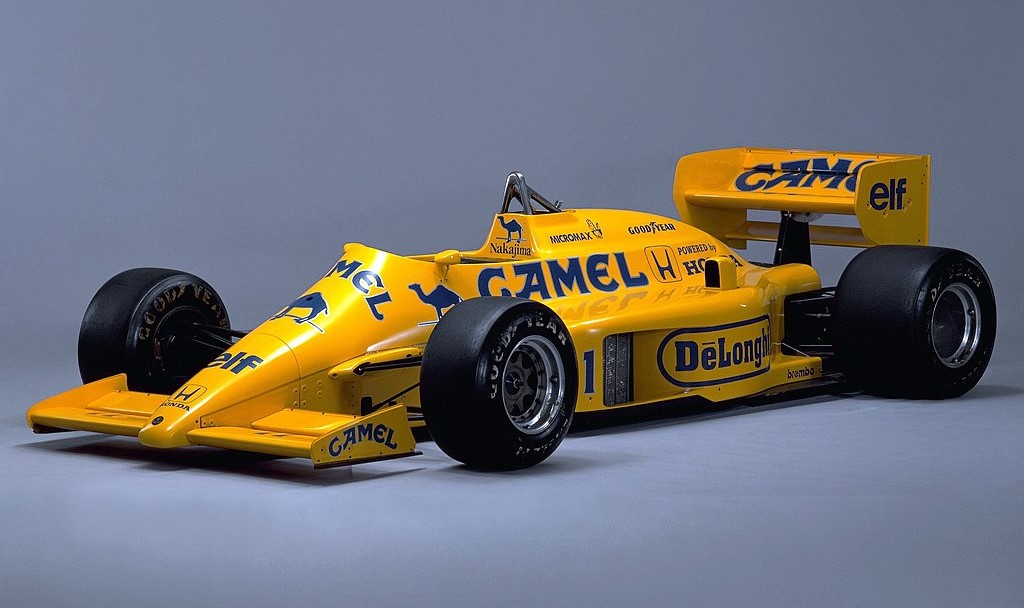 Lotus Honda 99T 1987 S.Nakajima (Photo: Dima Moroz)
Lotus Honda 99T 1987 S.Nakajima (Photo: Dima Moroz)
1988 was a miserable year for both Nakajima and the Camel Lotus Team. Senna had moved to the all-conquering McLaren-Honda team and his place at Lotus was taken by Nelson Piquet. It was the final year of the V6 turbo era and Nakajima could only score 1 point with the Lotus 100T, ending the year in 16th place in the championship. It must be noted that Nakajima failed to qualify on two occasions that year making him the first driver not to qualify a Honda V6 turbo-powered car since the engine's introduction in 1983. Piquet managed to score 22 points in the ill-handling and slow Lotus.
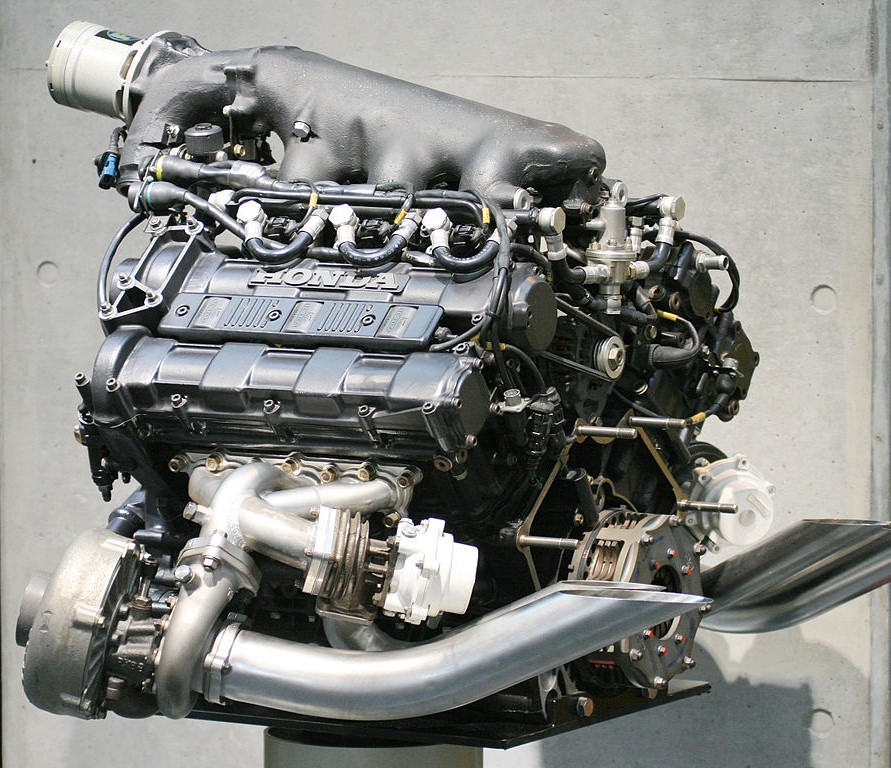 Honda RA168E 1.5-litre turbo engine (Photo: Morio)
Honda RA168E 1.5-litre turbo engine (Photo: Morio)
The 3.5-litre naturally-aspirated engine era began in 1989. Lotus received a body blow when Honda decided to supply its 3.5-litre V10 exclusively to McLaren and were forced into a short-term deal for Judd V8 engines. Nelson Piquet remained under contract with Lotus and with no obligation to Honda, the team tried to entice Derek Warwick to be Nakajima's replacement. Warwick decided to stay with Arrows and Nakajima was retained for another season thanks to continued sponsorship from Epson and PIAA. Nakajima struggled in the Lotus 101 and his only points scoring finish was 4th at the Australian GP, equaling his best career finish. Australia was also where he became the first Japanese driver to record a fastest lap in a race.
Nakajima left Lotus after three seasons to join the Tyrrell Racing Organisation in 1990, taking with him the much-needed Epson and PIAA sponsorship and the promise of Honda engines in 1991. Using the underpowered Ford DFR V8, the Tyrrell 019 was nonetheless a compact and nimble car which Nakajima's team mate, Jean Alesi used to good effect to score 13 points against Nakajima's 3 points.
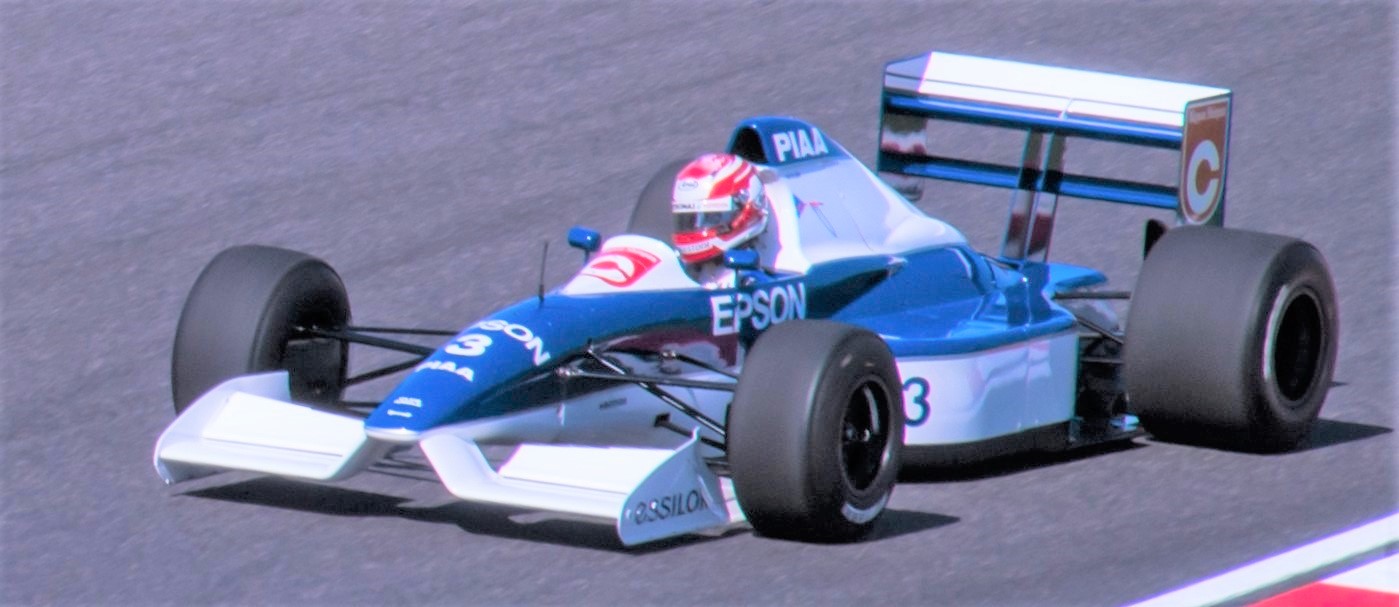 Tyrrell Ford 019 '90 Nakajima (Photo: N.Hayashida)
Tyrrell Ford 019 '90 Nakajima (Photo: N.Hayashida)
Still under his two-year contract, Nakajima's presence helped Tyrrell secure Honda V6 engines in 1991, albeit the ones used by McLaren the previous year. The season began well for Nakajima and his new team mate, Stefano Modena, finishing 5th and 4th respectively at Phoenix. Then it all went wrong for Nakajima as he failed to score another point all year prompting the 38-year-old to announce his retirement from racing at the end of the season.
After retirement, Nakajima did not leave F1 completely as he was retained by Honda in 1993/94 as a test driver as Honda planned to enter F1 with their own team. He tested several chassis for Honda but the company delayed the project and it wasn't until 2006 that Honda finally entered F1 as a constructor. In 1983, Nakajima founded Nakajima Racing, a Super Formula and Super GT team and is still active today racing a Honda NSX-GT. Nakajima's eldest son, Kazuki raced for Williams in F1 from 2008 - 2009 while his younger son, Daisuke competed in the British F3 championship in 2009 - 2010.
During Nakajima's five season, 80 Grand Prix career he scored 16 points and had made a name for himself as a respected mid-field runner and a formidable competitor.
Note (1): Fushida qualified for the Dutch GP in 1975 with a Maki-Ford but his engine blew preventing him from starting the race; he failed to qualify for his second and last race.
Note (2): The oldest driver to start a race was Louis Chiron who started in the 1955 Monaco GP at the age of 55 years, 292 day.
 Vale: Jean-Pierre Jabouille (1 October 1942 - 2 February 2023)
Vale: Jean-Pierre Jabouille (1 October 1942 - 2 February 2023)
[Back to Top]
New Additions: February 2023
Welcome to the February update which will be a rather short one. I have recovered from my operation I had in late November but my wife is keeping a close eye on me to ensure I don't lift anything too heavy. Thank you to all who wished me well during my recovery. Regretfully, I haven't any new additions to report this month which is probably the first time in a long time. I'm simply overstocked and I've run out of storage space, so, please help me out!
Last month's Toy and Hobby Fair at Epping was an understandably quiet affair, not helped by the torrential rain that seemed to go on forever. Let's hope for better weather at the next fair on 3rd February which I should be returning as a trader. This will be the only model fair for February. Until next month, happy collecting.
After Thoughts: "A Short History of the Formula One Pit Stop." When the first F1 Championship race took place at Silverstone on 13 May 1950 , pit stops were never considered as a planned strategy to obtain a racing advantage. In fact, bringing a car into the pits during a race was considered detrimental and extremely dangerous. Only two mechanics could service a car and mallets had to be used to remove and tighten the wheel nuts. Jammed wheel nuts were not uncommon. Also the pit lane was on the side of the race track, exposing the pit crew to cars racing wheel to wheel at upward of 180 mph. When the stop was completed, the mechanics then had to push the car for a few metres to get it going again. During the first three decades of F1, the pit lane was almost exclusively a place to fix mechanical problems. Drivers only went into the pits if they had no other choice, such as the Alfa drivers. In 1950, the Alfa Romeo team was dominant at the outset of the Championship using the Type 158 with its supercharged 1.5-litre engine against the 4.5-litre normally aspirated opposition. The supercharged engine was a thirsty powerplant and the Alfas were forced to pit for fuel, sometimes twice whilst the others could race without stopping. The Alfas prevailed only due to the unreliability of its opposition but by 1951, stopping to refuel was a huge disadvantage. The Alfa 159 was fitted with several auxiliary fuel tanks to extend its range between pit stops.
At the 1957 German GP, Juan Manuel Fangio became the first driver to strategically pit for fuel and tyres during the race. Fangio was aware of the tyre and fuel-level selection of the Ferrari drivers and realised they were planning to run non-stop for the 500 kilometre race. So Fangio decided he would use softer tyres and only half a tank of fuel in his Maserati 250F believing he could take the corners faster and build a substantial lead before pitting. Fangio pitted on lap 13 of 22, in first place and 30 seconds ahead of the Ferraris. The pit stop was a disaster. A wheel nut rolled under the car without the mechanic noticing, it took nearly half a minute to locate and Fangio left the pits in 3rd place and 48 seconds behind the second-placed car. Considered as his greatest drive, Fangio clawed back the deficit and won the race by 3 seconds. Although he won, post-race analysis suggested he would have had an easier victory simply by avoiding the stop altogether and nobody tried the strategy again for a long time.
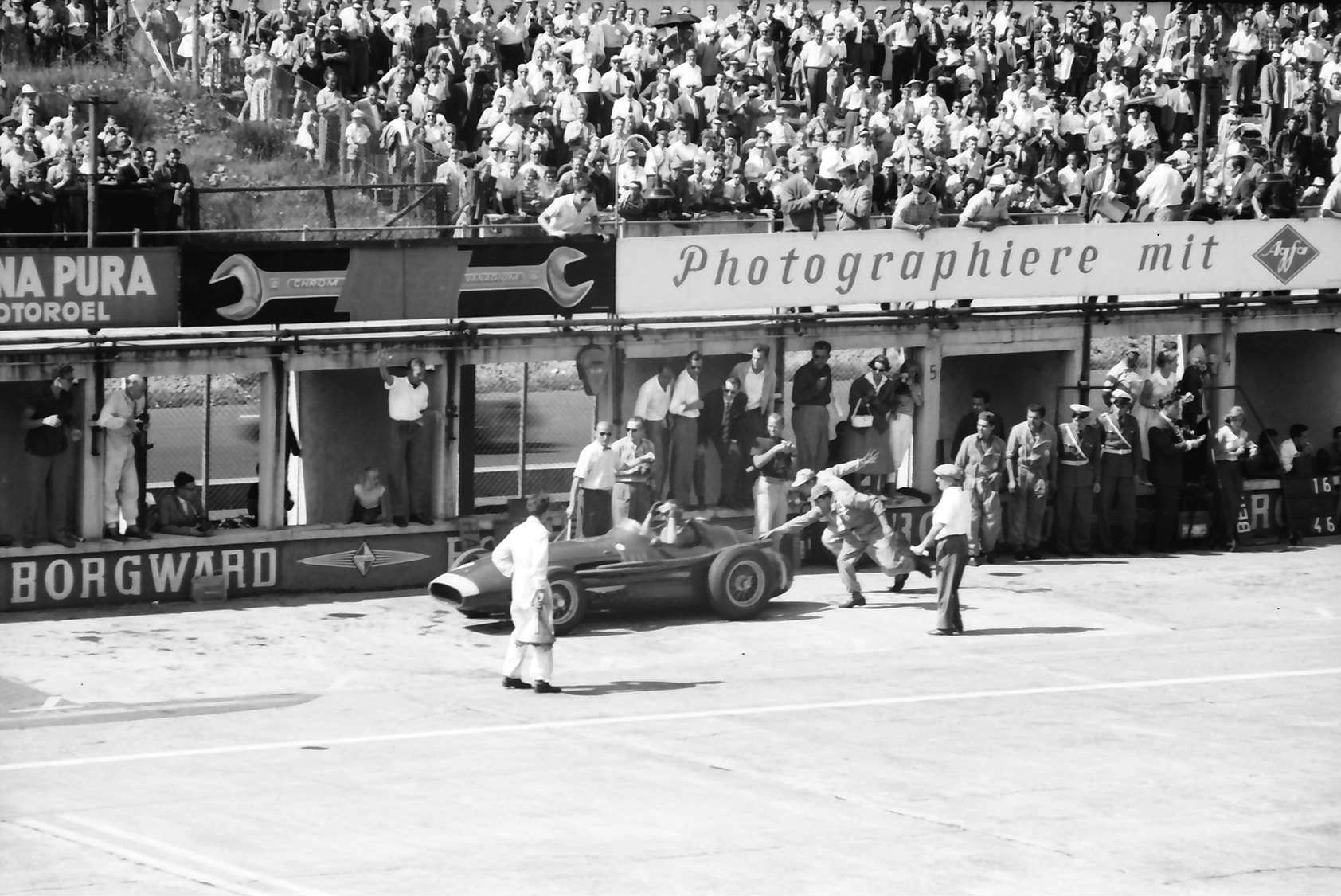 Fangio leaving the pits, German GP 1957 (Photo: W.Pragher)
Fangio leaving the pits, German GP 1957 (Photo: W.Pragher)
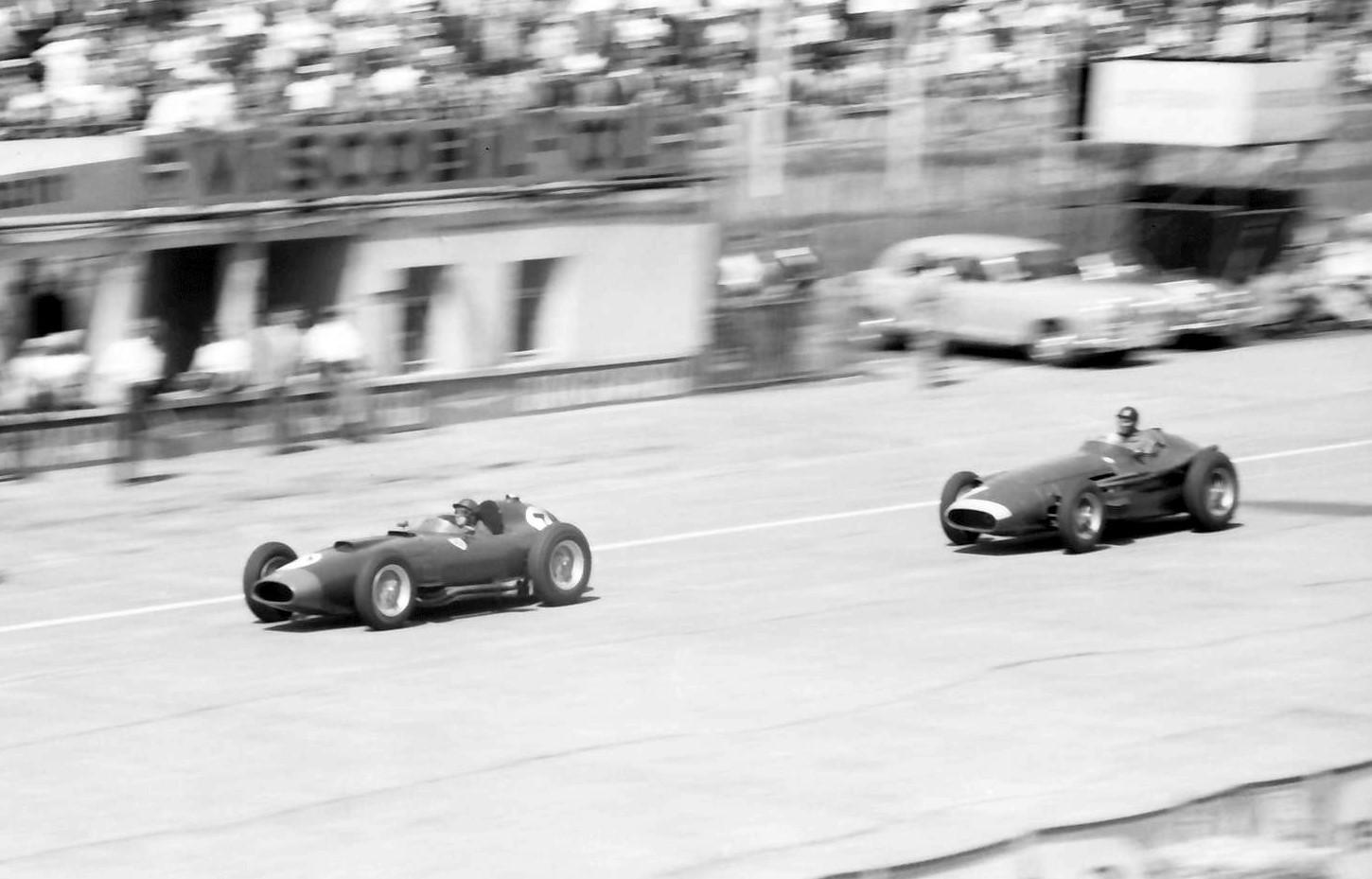 Fangio chasing Collins in 2nd after pitting German GP 1957 (Photo: W.Pragher)
Fangio chasing Collins in 2nd after pitting German GP 1957 (Photo: W.Pragher)
Fast-forward to 1982. At the season opening race in South Africa, Alain Prost in his Renault, punctured his left rear tyre on lap 41 whilst leading, forcing him to pit for new tyres. He emerged in eighth place but with fresh tyres and a lighter fuel load, Prost was by far the quickest car in the field, allowing him to overtake easily. By lap 68 Prost was in the lead again and went on to win the race. The extra performance of the Renault did not go unnoticed by Gordon Murray in the Brabham garage. Murray summised (as did Fangio in 1957) they could gain an advantage if they sent out their thirsty BMW turbo powered BT50s with half full tanks and softer, faster tyres. They should be able to lap quicker, especially when they could run higher boost levels knowing they would be topping up with fuel midway through the race. The radical strategy was first implemented at the British GP with both cars starting with 24 gallons of fuel rather than the 47 the BT50 needed to complete the race distance. Unfortunately, due to the unreliability of the new BMW engines, both cars retired before making their pit stops. It wasn't until 4 races later, at the Austrian GP that either car made it to a scheduled pit stop; Patrese pitted from first place, his stop lasted 14 seconds taking on fresh tyres and fuel. He returned to the track still in the lead only to crash three laps later when his engine seized. Despite this setback, Patrese had validated the strategy of starting with a light fuel load and mid race pit stops were soon adopted by other teams.
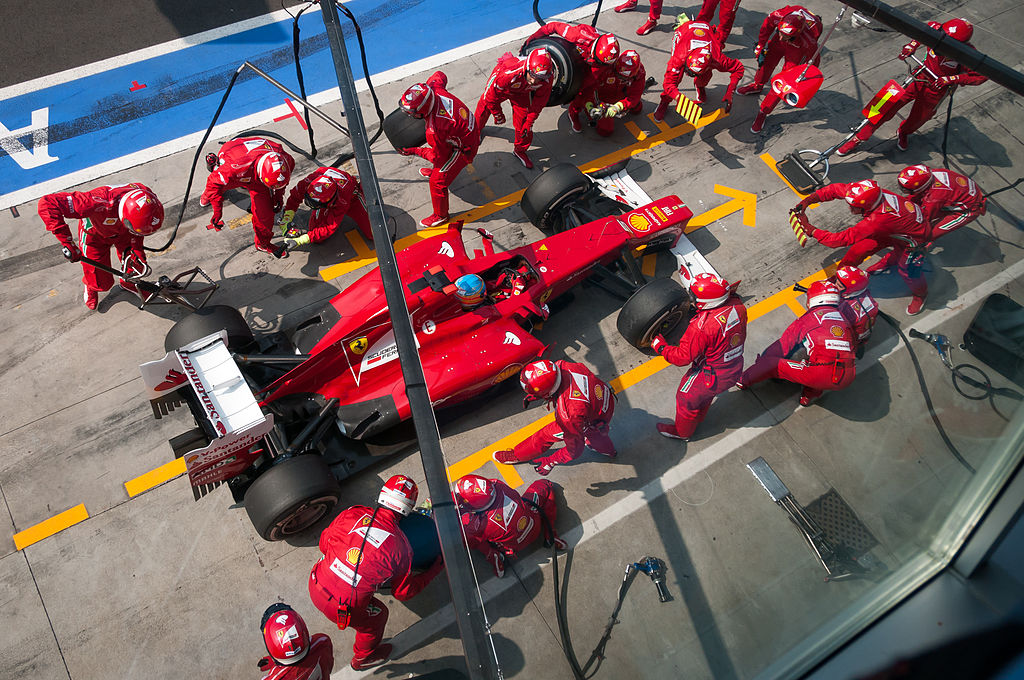 Ferrari pit stop, 2012 Italian GP (Photo: F.Crippa)
Ferrari pit stop, 2012 Italian GP (Photo: F.Crippa)
For the 1984 season, in-race refuelling was banned but teams continued to strategically change tyres. Without refuelling, pit stops became faster and faster. At the 1993 Belgian GP, Benetton performed a 3.2 second pit stop, a new record that stood for 15 years. It would be considered slow by today's F1 standards. Refuelling was reintroduced in 1994 which allowed the Benetton record to last as long as it did. After a number of pit lane fires, the FIA banned refuelling again after the 2009 season, leading to the modern F1 pit stop. Since then, pit stops times have 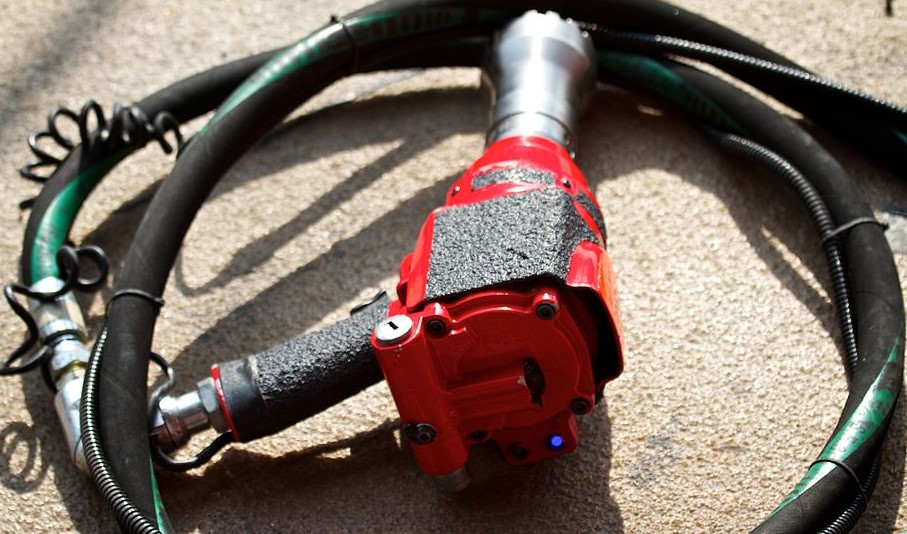 gradually gone down, through process and equipment advancement. Some teams and the FIA suspected that to speed up pit stops, Red Bull had been using automated devices such as a wheel gun that automatically sends out a positive signal when a lug nut is tightened. Red Bull currently holds the record for the fastest pit stop at 1.82 seconds, set at the 2019 Brazilian GP. Although it is the driver who gets all the attention, F1 is as much a team sport as any other and this is nowhere more evident than in the pit stop.
gradually gone down, through process and equipment advancement. Some teams and the FIA suspected that to speed up pit stops, Red Bull had been using automated devices such as a wheel gun that automatically sends out a positive signal when a lug nut is tightened. Red Bull currently holds the record for the fastest pit stop at 1.82 seconds, set at the 2019 Brazilian GP. Although it is the driver who gets all the attention, F1 is as much a team sport as any other and this is nowhere more evident than in the pit stop.
 Vale: Ken Block (21 November 1967 - 2 January 2023) Gymkhana Legend
Vale: Ken Block (21 November 1967 - 2 January 2023) Gymkhana Legend
[Back to Top]
New Additions: January 2023
Welcome to the first update for 2023; I hope everyone had an enjoyable and relaxing time over the festive season. I would like to wish all my readers a very happy new year and also a happy Lunar New Year as it falls on 22 January this year. It's going to be an exciting year of motorsports with three new drivers in F1 (see AfterThoughts below), more exotic Hypercars at Le Mans and the debut of the Gen3 Camaros and Mustangs in the Australian Supercar series. Bring it on! Only a handful of new additions to report, all of them 2021 F1/Le Mans cars.
As it's only early into the new year, dates for some events for 2023 haven't yet been confirmed. Wh at are known are the dates for the monthly Sydney Toy and Hobby Fair at Epping, i.e. the first Friday of every month, except for April. As the Good Friday holiday falls on the first Friday, the organisers have decided to cancel the Fair for April. Also, the dates for Collector Con (Penrith) have been confirmed with four events scheduled this year. Please check the Swap Meets link for confirmations of events.
So, only the one event for January, the Sydney Toy and Hobby Fair on 6 January. Unfortunately, I won't be attending this event as a trader as I'm still recovering from my operation however I'm hoping to be there as a visitor and to help out where I can.
Lastly, thank you for making 2022 a good year for F1scalemodels, it's so pleasing to see you haven't lost your passion for collecting model cars. Our extraordinary hobby has helped us get through some dark times and I hope it keeps giving you joy into the future. Until next month, happy collecting.
Formula One
- 2021 Alpine Renault A521, F.Alonso (14) Hungarian GP (Spark)
- 2021 Alpine Renault A521, E.Ocon (31) 1st Hungarian GP w/ pit board (Spark)
- 2021 Aston Martin Merc AMR21, L.Stroll (18) Italian GP (Spark)
- 2021 McLaren Merc MCL35M, D.Ricciardo (3) Monaco GP Gulf Livery (Spark)
- 2021 McLaren Merc MCL35M, L.Norris (4) 3rd Monaco GP Gulf Livery #3 Board (Spark)
- 2021 McLaren Merc MCL35M, D.Ricciardo (3) 1st Italian GP w/ pit board (Spark)
- 2021 Mercedes AMG W12, L.Hamilton (44) 1st Russian GP 100th Win (Spark)
Le Mans
- 2021 Alpine Gibson A480, Negrão/Lapierre/Vaxivière (36) 3rd Le Mans (Spark)
After Thoughts: "The cars that were too fast for Le Mans." Prior to the 1990 race, the Mulsanne Straight(1) at Le Mans was just that, a long 6 km (3.7 mi) stretch of road that started from Tertre Rouge, passed the Hippodrome Café and ended at the village of Mulsanne. Incredibly, the Mulsanne Straight had been even longer; the 1911 French Grand Prix used a circuit that was 54 kilometres long but the circuit and the straight were shortened two years before the first 24-hour race in 1923. Speed down the Mulsanne was one of the key components to a quick lap so drivers unleashed the power of their cars along the straight. In 1961, a Maserati was clocked at 280 km/h (173.6 mph) down the Mulsanne during practice, in 1970 a Porsche 917 registered 331 km/h (205.2 mph) during the race and by the late 1980's, speeds in the high-300 km/h were regularly recorded. But speeds were getting out of control; for the drivers anything much over 300 km/h is a potential killing zone. If anything went wrong, like a puncture or loss of bodywork, drivers depended on lady luck more than their skill to survive.(2)
In 1988, Peugeot engineers Gérard Welter and Michel Meunier, the founders of Welter Racing designed the WM P88 Peugeot, not to win at Le Mans but to be the fastest damn car ever down the Mulsanne Straight. That was it, that was the only goal. Team WM was a part-time operation and the WM cars were designed, engineered and built mainly in Welter's home garage with the help of part-time mechanics. Garage owner Roger Dorchy was the lead driver who was tasked with setting the record and he swept through the speed trap at 407 km/h, a new record for the Mulsanne Straight. Astonishingly, Welter, Peugeot and the Le Mans organisers (ACO) agreed to advertise the record at 405 km/h (252 mph) as a marketing exercise to promote the debut of the new Peugeot 405 road car. As the P88 was only designed to go fast in a straight line, it handled poorly around the rest of the circuit so only qualified in 36th. The car lasted 59 laps, expiring with turbo, cooling and electrical issues.
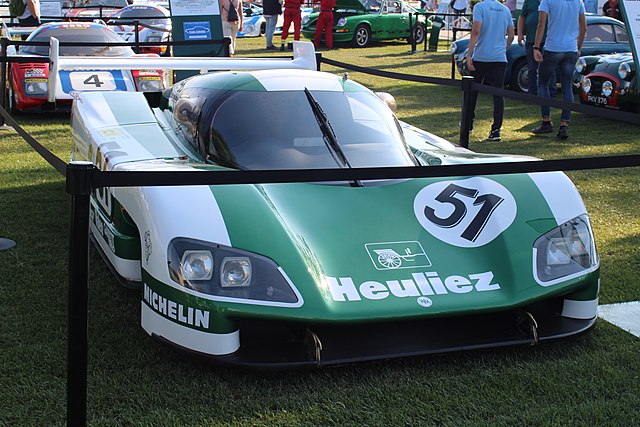 VM P88 Peugeot (Photo: Éric Manesse)
VM P88 Peugeot (Photo: Éric Manesse)
The Sauber Mercedes C9 was a Group C prototype introduced in 1987, however both Kouros sponsored cars failed to finish at Le Mans that year. In the 1988 race, the team suffered an embarassing setback when they were forced to withdraw; the combination of higher speeds and higher downforce had increased the loads on their Michelin tyres causing the rear tyres to burst at very high speed. The following year, the 750 hp, 4.973 litre twin-turbo, V8-powered C9 dominated the World Sportscar Championship, of which Le Mans was unusually not a part of that year. Painted bare silver to evoke the memory and success of its all-conquering Silver Arrows from the past, the C9 attempted to better the mark set the previous year by the WM P88. Unfortunately, the C9 wasn't able to break the record but did record a 400 km/h run down the Straight and was the last car to break the 400 barrier. Oh, the C9's also finished 1st, 2nd and 5th in the race.
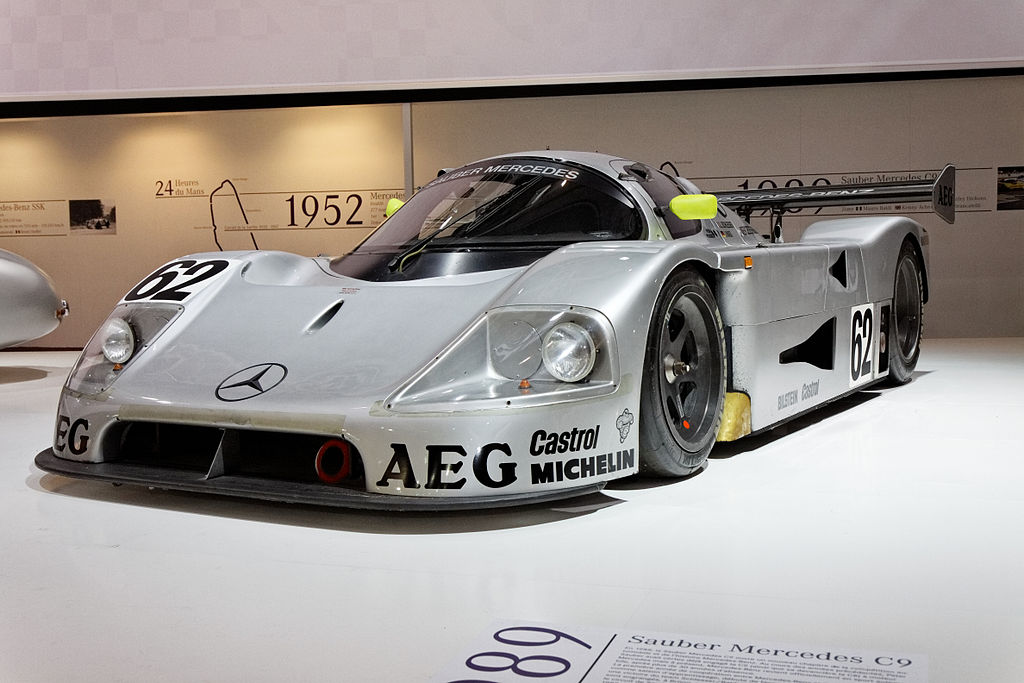 Sauber Merc C9 1989 (Photo: Thesupermat)
Sauber Merc C9 1989 (Photo: Thesupermat)
The Mulsanne in its uninterrupted form came to an end for the 1990 edition of the 24 Hours. In the interest of safety, two chicanes were added with the goal of reducing the speed on the Straight(3). This change also coincided with FISA (governing body for motorsports) decreeing it would no longer sanction a circuit with a straight longer than 2 km (1.2 mi). But was "safety" the real reason for the insertion of the two chicanes or was politics being played between the ACO and FISA? In 1989, Le Mans was not part of the World Sportscar Championship. FISA wanted concessions such as TV revenue from the ACO if Le Mans was to return to the Championship and the Mulsanne was then made a negotiating point in the ongoing battle. FISA promised the Mulsanne would remain unchanged if the ACO agreed to its demands but an agreement was not forthcoming so FISA introduced the two kilometre length rule for any straight. Le Mans did not rejoin the Championship until 1991; the chicanes, of course, remained.
Note (1): The Ligne droite des Hunaudières (the straight line of the Hunaudieres) is its correct name, named after the hamlet at its mid-point; it's only called the Mulsanne in the English-speaking world.
Note (2): The Straight has claimed the lives of seven drivers.
Note (3): The fastest speed on the Mulsanne after the introduction of the chicanes was 366 km/h.
The 2023 F1 Rookies: It has been some time since three new drivers joined the F1 Championship in the same season. Here are the reasons why they will be on the grid this year ...
Oscar Piastri
Piastri's debut is perhaps the most keenly anticipated of all the rookies. The Australian youngster will be replacing another Australian, the popular Daniel Ricciardo in the competitive McLaren outfit. Why wouldn't McLaren be happy to have Piastri in their team with a CV like this?
- 2017 - 2nd F4 British Championship
- 2019 - 1st Formula Renault Eurocup
- 2020 - 1st FIA Formula 3 Championship
- 2021 - 1st FIA Formula 2 Championship
Logan Sargeant
Sargeant, an American driver will be replacing Nicholas Latifi who spent three uneventful seasons at Williams. He will be the first American F1 driver to compete since Alexander Rossi in 2015. Sargeant has worked his way through the feeder series to gain a drive with the underperforming Williams team.
- 2017 - 3rd F4 British Championship
- 2018 - 4th Formula Renault Eurocup
- 2020 - 3rd FIA Formula 3 Championship
- 2022 - 4th FIA Formula 2 Championship
Nyck de Vries
Although technically not a rookie F1 driver, his one-off drive when he replaced Alex Albon at the Italian GP in 2022 for Williams showed his immense talent. He finished 9th in his first F1 race and deserves a full season with the Alpha Tauri. His credentials are impressive.
- 2014 - 1st Eurocup Formula Renault 2.0
- 2015 - 3rd Formula Renault 3.5 Series
- 2019 - 1st FIA Formula 2 Championship
- 2020-21 - 1st Formula E Championship
 Vale: Patrick Tambay (25 June 1949 - 4 December 2022)
Vale: Patrick Tambay (25 June 1949 - 4 December 2022)
